
CSA BOX CONTENTS WEEK OF JAN 1ST
01/02/18 — Scott
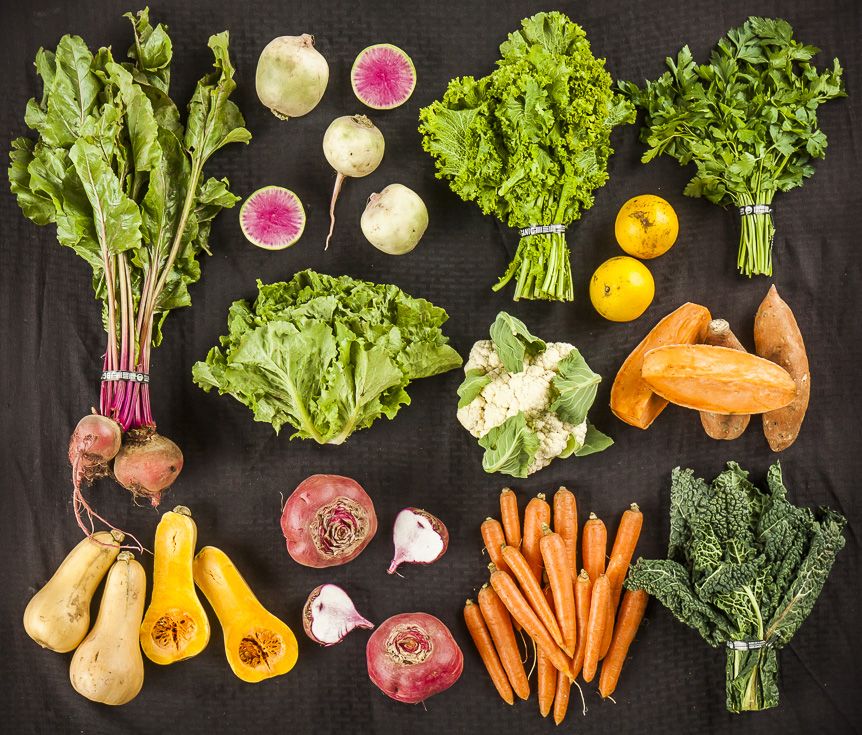 CSA Box Contents Week of Jan 1st
CSA Box Contents Week of Jan 1st
Large Box
Bok Choy
Broccoli
Carrot, Orange
Citrus, Mixed
Garlic, Green
Greens, Arugula
Greens, Chard, Rainbow
Greens, Kale, Curly
Greens, Spinach
Herb, Cilantro
Kohlrabi, Purple
Turnip, Rutabaga
Bok Choy
Broccoli
Carrot, Orange
Citrus, Mixed
Garlic, Green
Greens, Arugula
Greens, Chard, Rainbow
Greens, Kale, Curly
Greens, Spinach
Herb, Cilantro
Kohlrabi, Purple
Turnip, Rutabaga
Medium Box
Beet, Red
Bok Choy
Broccoli
Carrot, Orange
Greens, Collards
Greens, Spinach
Herb, Cilantro
Kohlrabi, Purple
Lettuce, Braising Mix
Turnip, Rutabaga
Beet, Red
Bok Choy
Broccoli
Carrot, Orange
Greens, Collards
Greens, Spinach
Herb, Cilantro
Kohlrabi, Purple
Lettuce, Braising Mix
Turnip, Rutabaga
Small Box
Broccoli
Cabbage
Carrot, Orange
Citrus, Mixed
Garlic, Green
Greens, Collards
Turnip, Rutabaga
Broccoli
Cabbage
Carrot, Orange
Citrus, Mixed
Garlic, Green
Greens, Collards
Turnip, Rutabaga
Individual Box
Beet, Red
Carrot, Orange
Greens, Arugula
Greens, Collards
Radish, Purple Daikon
Beet, Red
Carrot, Orange
Greens, Arugula
Greens, Collards
Radish, Purple Daikon
CSA BOX CONTENTS WEEK OF JAN 1ST
01/02/18 — Scott
 CSA Box Contents Week of Jan 1st
CSA Box Contents Week of Jan 1st
Large Box
Beet, Chioggia
Carrot, Orange
Cauliflower
Citrus, Oranges
Greens, Kale, Dino
Greens, Mustard
Herb, Parsley, Flat
Lettuce, Romaine
Potato, Sweet
Radish, Watermelon
Squash, Butternut
Turnip, Scarlett
EASY BLACK EYED PEAS & COLLARD GREENS
01/03/18 — Heydon Hatcher
Recipe and Photo by Megan Winfrey
Just one peek at social media on January 1st and everyone's posting the same thing. Big ole bowls of black eyed peas and greens, cornbread and hot sauce waiting in the wings. Legend says that black eyed peas bring luck, greens bring wealth, and pork keeps you moving forward (like a pig does when foraging). I look forward to making this meal on the first day of the year, and enjoying the leftovers all week long. What follows is the easiest peas and greens recipe in the entire world, and it will taste like it took hours to make. By all means, use dried peas and ham hock if possible - but keep this recipe in your back pocket for that inevitable January 1st when you simply 'aint got time for that. Happy 2018!
Easy Black Eyed Peas & Collard Greens![]()
In a medium-large dutch oven, cook the chopped bacon until crispy. Transfer to a paper towel to drain.
Cook the onion, celery, and garlic in the bacon drippings until tender.
Add the broth, peas, salt and pepper and bring to a boil.
Lower the heat to a simmer and add the bacon. Cover and cook for about 45 minutes, until the peas are tender and can be easily smashed with the back of a fork.
Add the chopped collard greens, stir well, adjust seasoning to taste, cover and let simmer for another 10 minutes.
Garnish with the hot sauce of your choice.
Just one peek at social media on January 1st and everyone's posting the same thing. Big ole bowls of black eyed peas and greens, cornbread and hot sauce waiting in the wings. Legend says that black eyed peas bring luck, greens bring wealth, and pork keeps you moving forward (like a pig does when foraging). I look forward to making this meal on the first day of the year, and enjoying the leftovers all week long. What follows is the easiest peas and greens recipe in the entire world, and it will taste like it took hours to make. By all means, use dried peas and ham hock if possible - but keep this recipe in your back pocket for that inevitable January 1st when you simply 'aint got time for that. Happy 2018!
Easy Black Eyed Peas & Collard Greens
- 4 cups frozen black eyed peas
- 5 slices of bacon, chopped
- 1 large onion, chopped
- 1 celery stalk, diced
- 4 cloves garlic, minced
- 6 cups chicken broth
- salt and black pepper to taste
- 1 bunch collard greens, stems removed and rough chopped
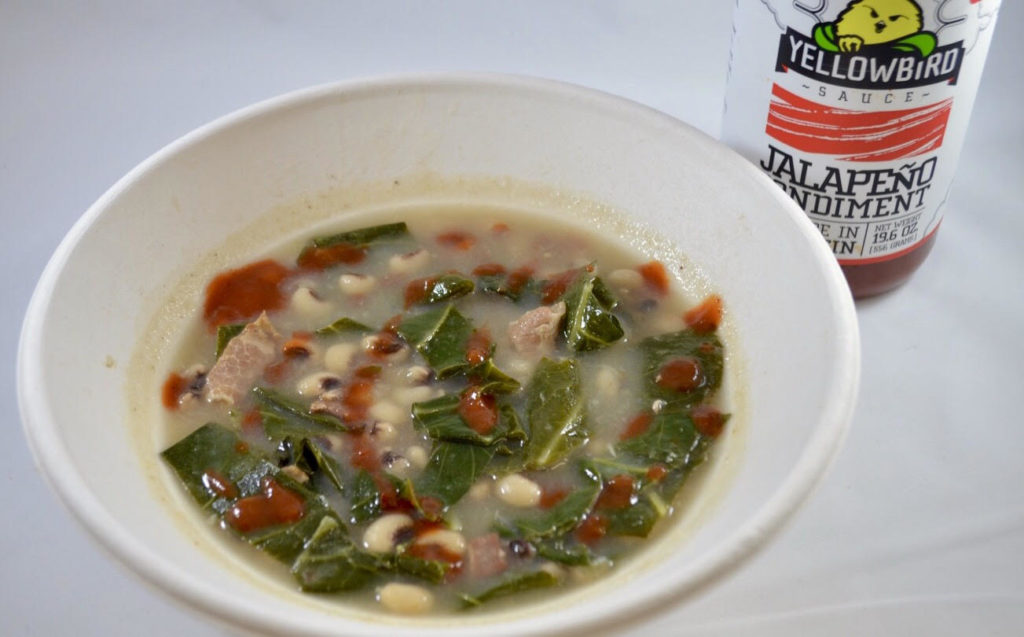
In a medium-large dutch oven, cook the chopped bacon until crispy. Transfer to a paper towel to drain.
Cook the onion, celery, and garlic in the bacon drippings until tender.
Add the broth, peas, salt and pepper and bring to a boil.
Lower the heat to a simmer and add the bacon. Cover and cook for about 45 minutes, until the peas are tender and can be easily smashed with the back of a fork.
Add the chopped collard greens, stir well, adjust seasoning to taste, cover and let simmer for another 10 minutes.
Garnish with the hot sauce of your choice.
WEEK 1 IN PHOTOS
01/05/18 — Heydon Hatcher
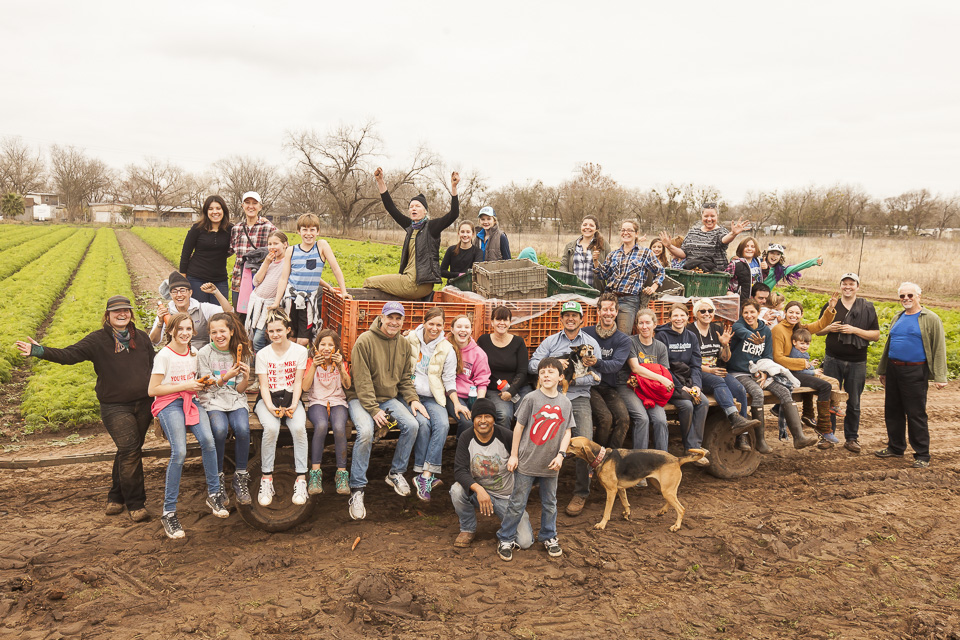 Our incredible volunteers. Photo by Scott David Gordon.
Our incredible volunteers. Photo by Scott David Gordon.
Happy 2018! Right before the start of the fresh, new year, we reached out to our Austin community via Instagram and a mass email pleading for extra hands to aid in harvesting storage crops before an impending freeze. The freeze can wreak havoc upon crops, so getting this produce into storage was of utmost importance. To our surprise, we received an astounding response and had more than 60 people happily show up for us at the farm the following day. These incredible volunteers harvested over 1500 pounds, or 22 bulk bins of produce (specifically carrots, black Spanish radishes, and daikon radishes). Time and time again we are floored by the support of our community, so, we extend the biggest thank you for being there for us this past week.
Speaking of the freeze, everything is just now thawing out at the farm from this past week's deep freeze, and we are still assessing the damage. You can expect a little less variety at markets this weekend, as well as slightly decreased quality in certain crops. Most of our delicate and tender leafy-crops (like lettuces and cilantro) are likely lost. We're crossing our fingers that hardier greens like kale and collards have sustained some damage, but that the plants themselves have not died. Root crops like carrots and beets hopefully sustained minimal damage as they were underground during the freeze.
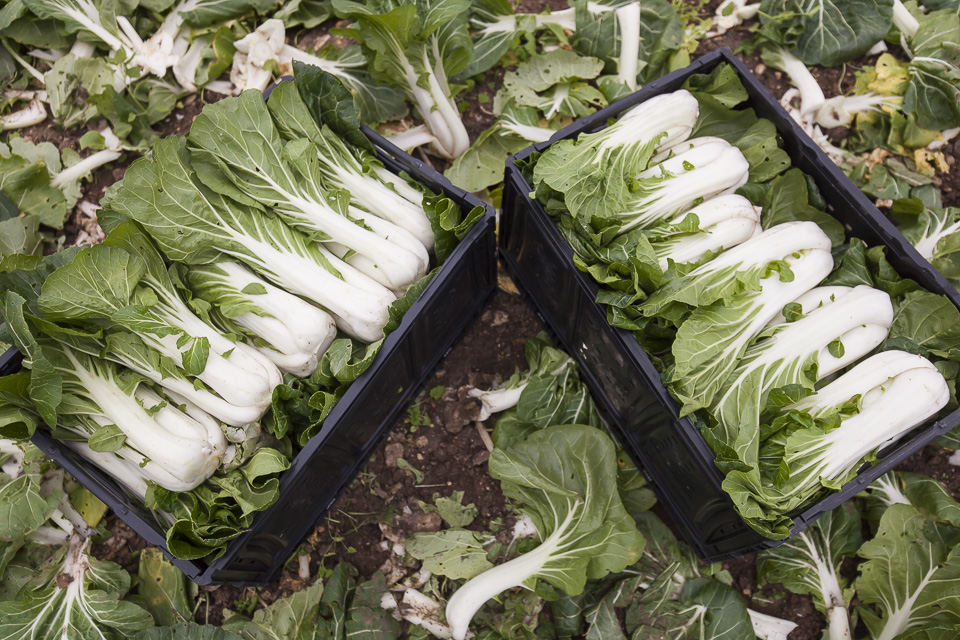 Bok choy. Photo by Scott David Gordon.
Bok choy. Photo by Scott David Gordon.
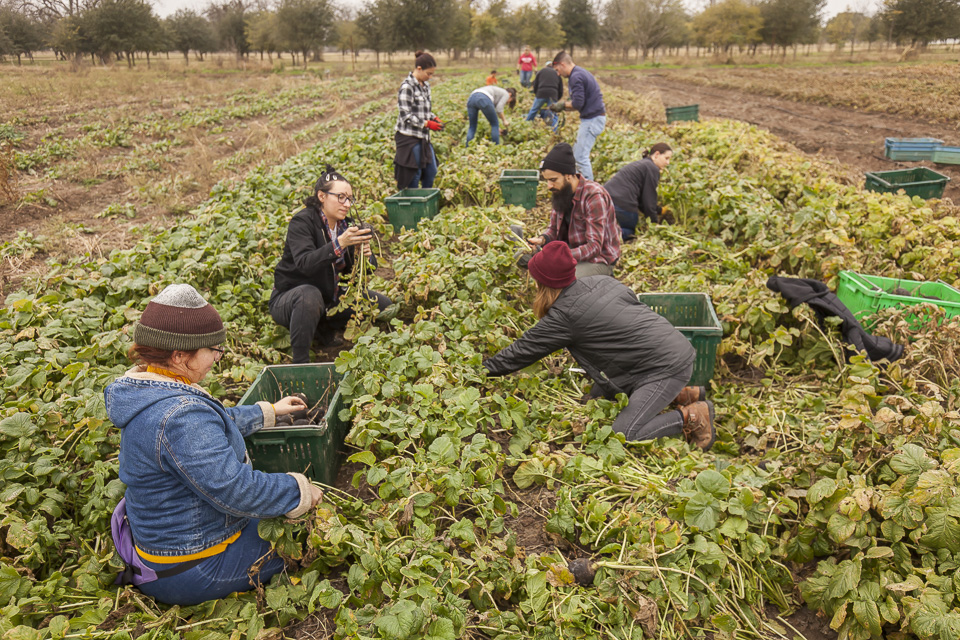 Black Spanish Radish harvest. Photo by Scott David Gordon.
Black Spanish Radish harvest. Photo by Scott David Gordon.
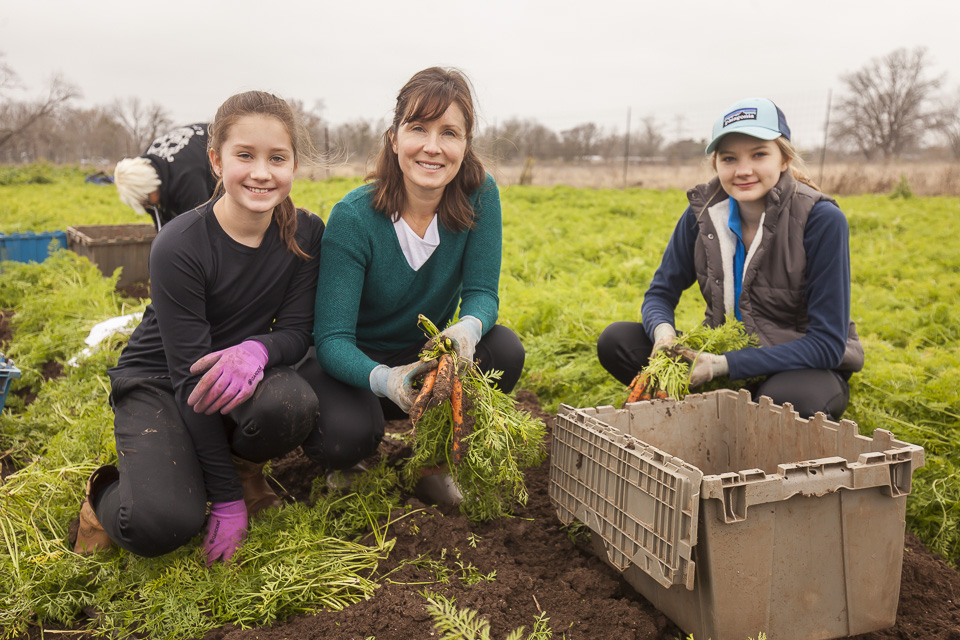 Carrot harvest. Photo by Scott David Gordon.
Carrot harvest. Photo by Scott David Gordon.
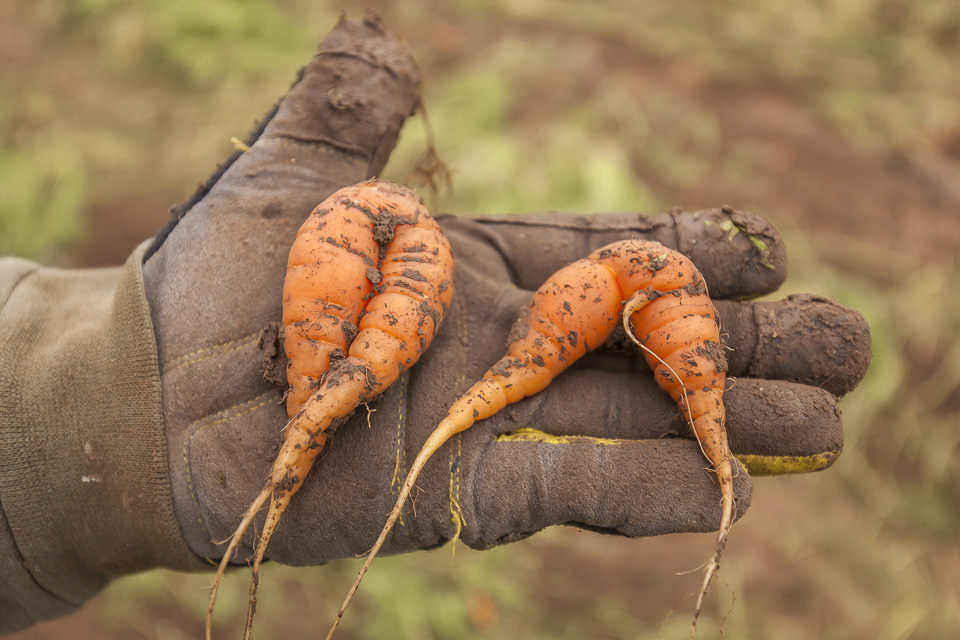 Carrot legs. Photo by Scott David Gordon.
Carrot legs. Photo by Scott David Gordon.
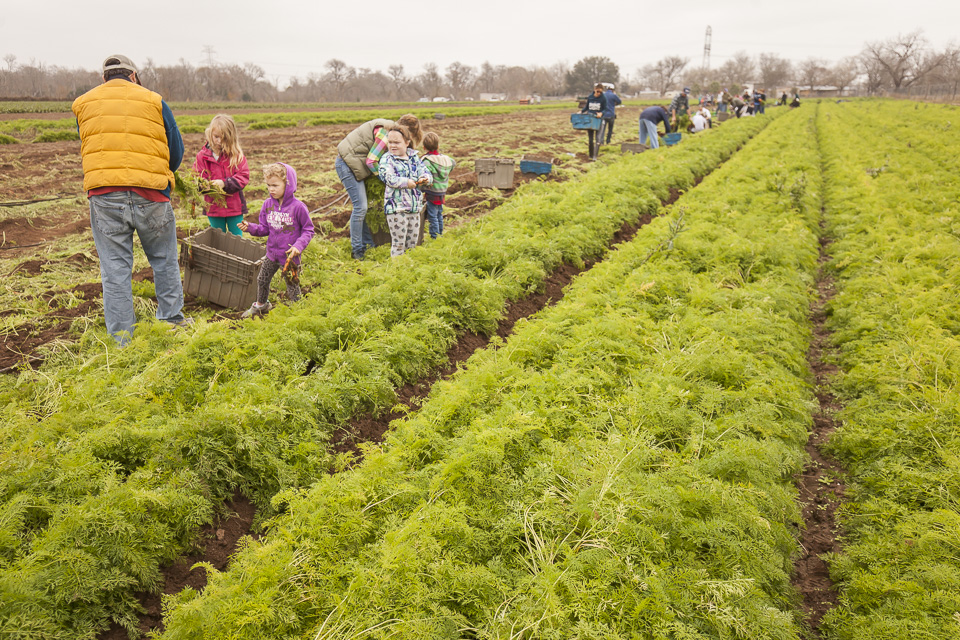 Volunteers all the way down. Photo by Scott David Gordon.
Volunteers all the way down. Photo by Scott David Gordon.
 Gals and their carrots. Photo by Scott David Gordon.
Gals and their carrots. Photo by Scott David Gordon.
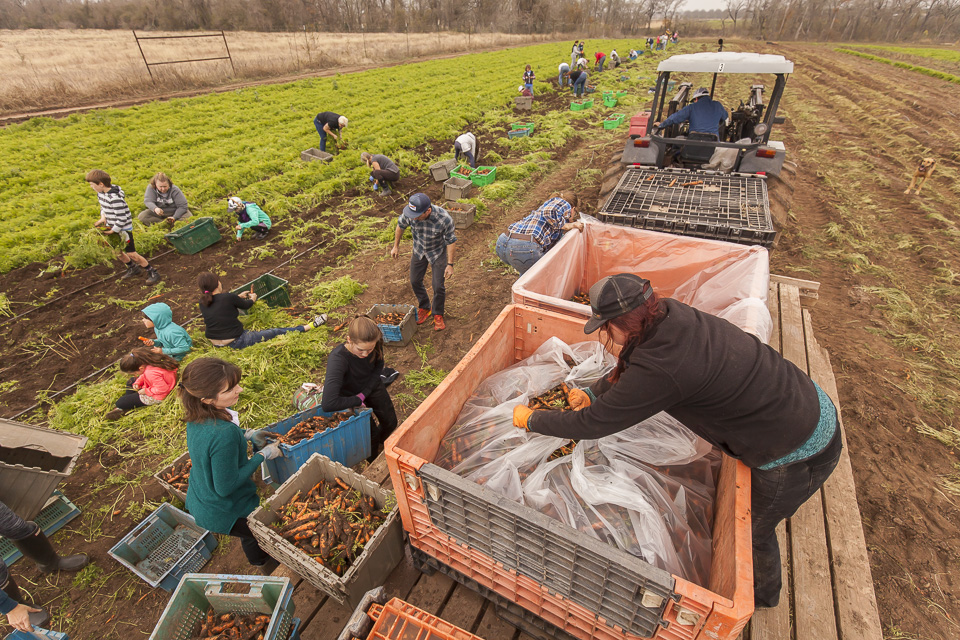 Filling up the bulk bins. Photo by Scott David Gordon.
Filling up the bulk bins. Photo by Scott David Gordon.
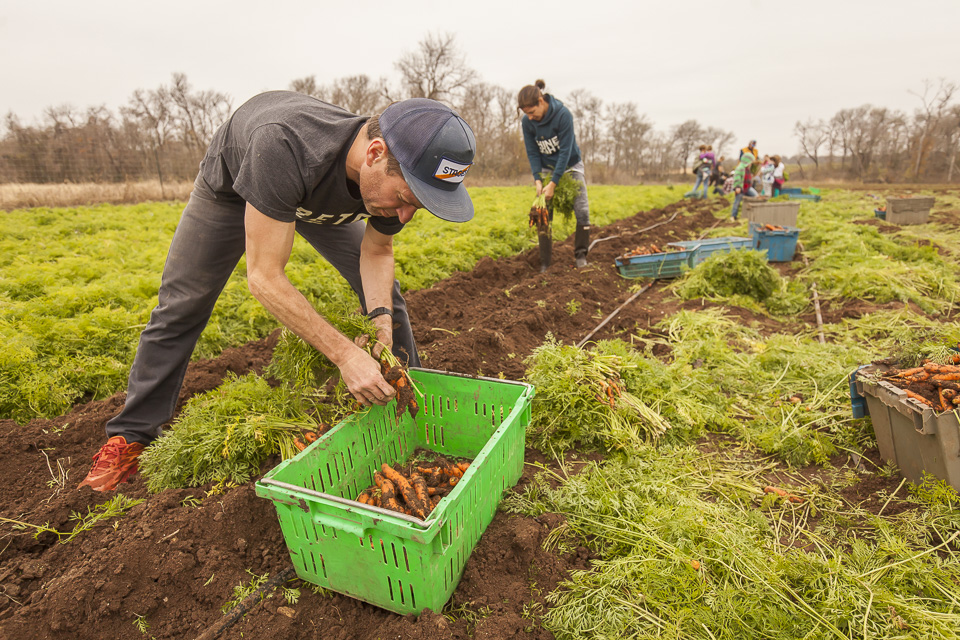 Carrot harvest action shot. Photo by Scott David Gordon.
Carrot harvest action shot. Photo by Scott David Gordon.
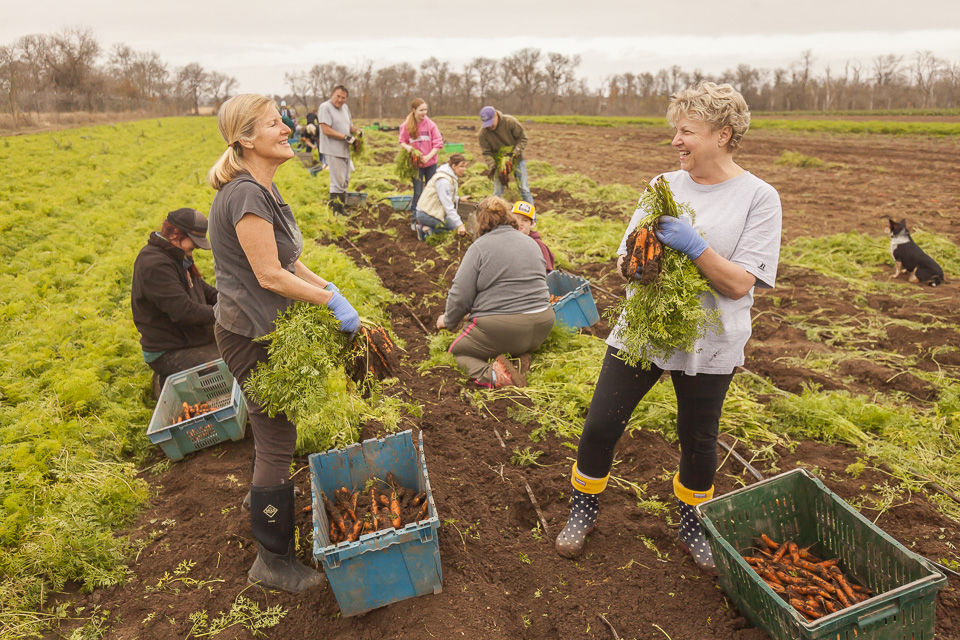 Carrot harvest convo. Photo by Scott David Gordon.
Carrot harvest convo. Photo by Scott David Gordon.
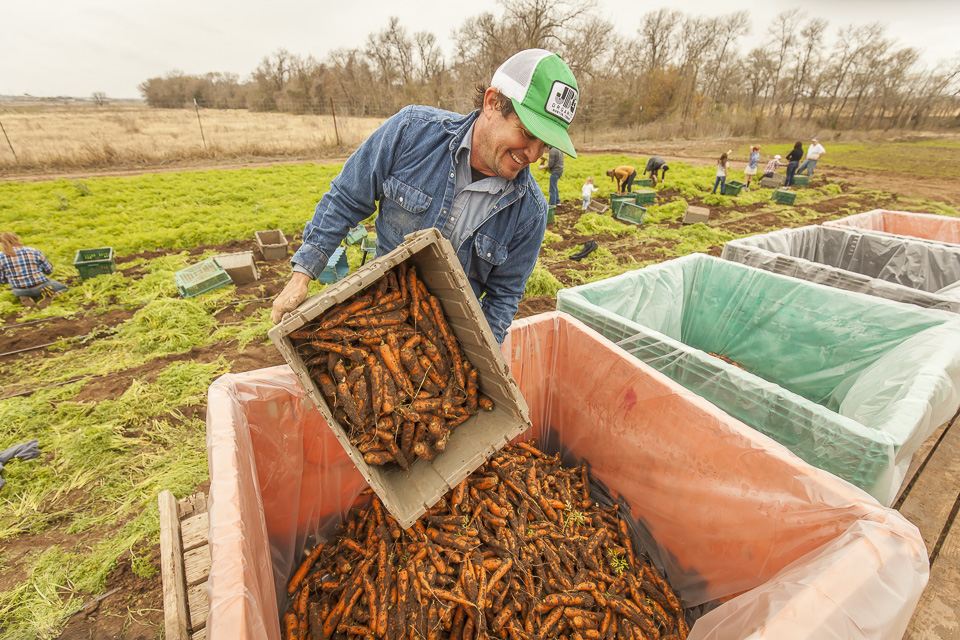 Head farmer, Brenton, emptying out his carrots. Photo by Scott David Gordon.
Head farmer, Brenton, emptying out his carrots. Photo by Scott David Gordon.
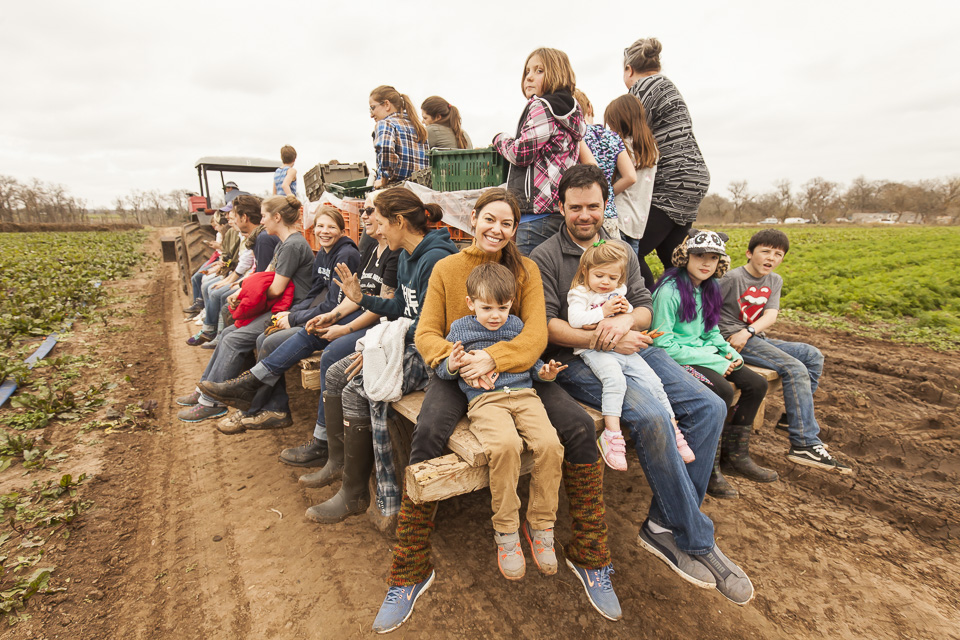 Bundled up on the trailer. Photo by Scott David Gordon.
Bundled up on the trailer. Photo by Scott David Gordon.
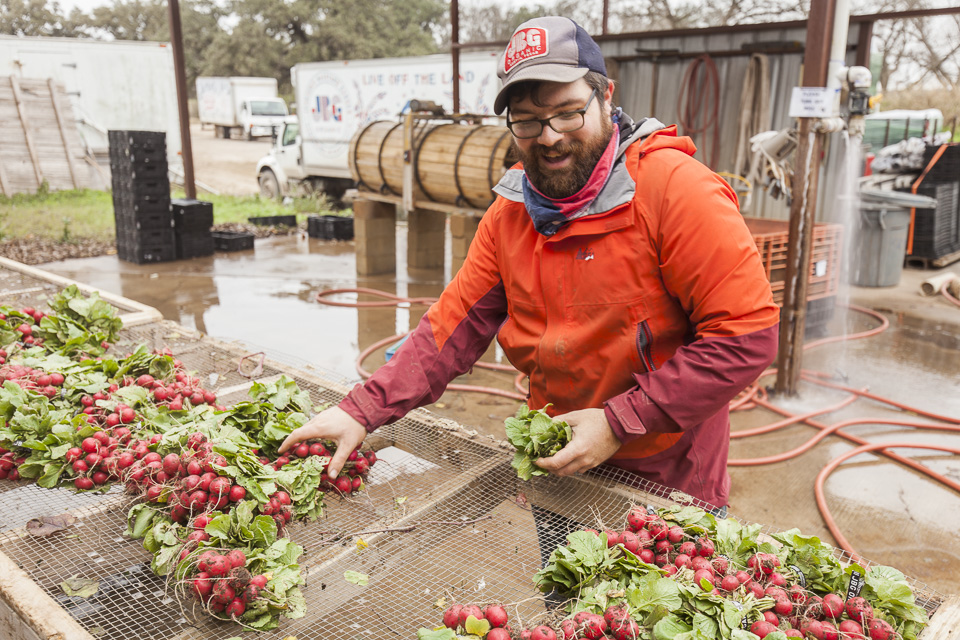 Ryan and the radishes. Photo by Scott David Gordon.
Ryan and the radishes. Photo by Scott David Gordon.
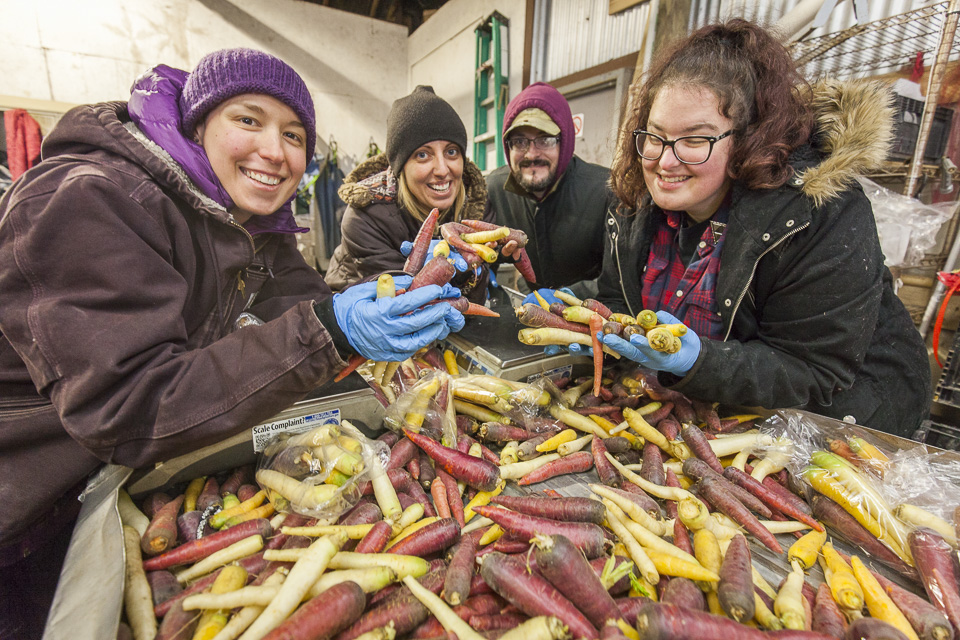 Carrot sorting at the barn. Photo by Scott David Gordon.
Carrot sorting at the barn. Photo by Scott David Gordon.JOIN THE CSA IN 2018 + FAVORITE SEASONAL RECIPES FROM JBG-ERS
01/05/18 — Heydon Hatcher
2018 has arrived! A new year offers the opportunity to start fresh and assess old habits. Why not join our CSA in the New Year?
![]() CSA bounty. Photo by Scott David Gordon.
CSA bounty. Photo by Scott David Gordon.
Let’s create intentions that set us up to attain overall better well-being. We could all do a little more for our bodies, and in 2018, why don’t we all aim to brighten our plates, make more meals, become more in tune with our environment, and ameliorate our diets once and for all. Easy enough, right? As we all strive for health in the new year, consider one life hack that is sure to bring welcome and easy change, our CSA! A simple and painless delivery service that ensures organic and fresh produce will be integrated into your diet week after week!
If you are a new customer or have been taking a hiatus, sign up now through the end of January and get your first box free! Yep, you heard us right, FREE! A new year means a new you. It’s a great way to integrate fresh, organic produce into your daily regimen. It’s the perfect nudge you’ve been waiting for, so don’t dally, the offer ends January 31st! To join (or rejoin) the CSA click here and use the promo code: getcookin2 or call the farm at 512.386.5273.
![]() Farmers Market CSA pickup. Photo by Scott David Gordon.
Farmers Market CSA pickup. Photo by Scott David Gordon.
Cultivated in East Austin and harvested no more than a day or two before reaching your doorstep, our certified organic fruits and vegetables (Over 200 varieties) are at peak nutrition and flavor. Getting a CSA share with JBG means you know exactly where your food is coming from and how it's grown. GMO? Heck no! You might even see a bunch of flowers in your share during certain months!
Eating locally connects you to the seasons, to the land, and to your own health and wellness. Cucumbers will cool you down in the summer, while braised collards will warm you up when the temperatures start to drop. Enjoy the best pico de gallo of your life during the short window when cilantro, onions, peppers, and tomatoes all overlap, and we promise you'll never go back to the store-bought stuff again. You'll get acclimated with the seasons on a whole new level, and learn about what naturally grows when and why. speaking of cooking: we love this challenge The idea is simple - cook all your meals at home for 30 days, and refrain from going out to eat or picking anything up, and with a weekly CSA the recipe options are endless!
![]() Longtime CSA Member, E. McQueen, enjoying her box at home. Photo by Scott David Gordon.
Longtime CSA Member, E. McQueen, enjoying her box at home. Photo by Scott David Gordon.
Beautifully put by our farm friend, Johannes Courtens: “'Community Supported Agriculture' is a commitment by people, not just for getting food as a reward for paying money, but it’s the idea that they are behind you, and believe in what you are doing. If the farm fails with something during the season, the finances are going to be okay since you have people backing the farm. By providing funds up front, the farm is able to run as efficiently as possible, and not being tied up by all the other clutter, like building the capital.
Trying to grow food first and then sell it is kind of an insane thing. Food is not a commodity, it’s a living thing, but it is a commodity in our economy. What CSA says is that it’s not a commodity, it’s a commitment. It’s something that’s hard to do. If people rally around a farm, it’s like crowdfunding. People are saying, I really think this product idea is awesome. It’s crowdfunding for food. The reward is high quality vegetables for weeks on end.”
![]() Beautiful watermelon radishes. Photo by Scott David Gordon.
Beautiful watermelon radishes. Photo by Scott David Gordon.
That being said, behind the veggies, are people. When you support our farm, you are supporting the people that toil ceaselessly week after week to plant, harvest, clean, pack, and deliver your veggies. In honor of those people, we thought that we would share some of our favorite seasonal recipes that utilize our favorite wintertime crops.
![]() Ada. Photo by Scott David Gordon.
Ada. Photo by Scott David Gordon.
Winter Thai-ish Curry
All of the ingredients and measurements are suggestions! This recipe works best when you use it as a clean-out technique. Use what you have!
Ingredients:
2. To make the curry, cook your onions in the oil. After soft, add the ginger and garlic and cook for another half minute, or so.
3. Add your carrots and sweet potatoes to the onion mixture. Add a dash of water to help steam those veggies and to prevent burning. After your carrots are about half-way done, add your curry paste and stir to combine.
4. Next, plop in the coconut milk, as well as a 1/2-1 cup of water or broth and a skimpy tablespoon of sugar. Add your greens, and any remaining vegetables. Bring to a simmer, reduce heat, and cook until all vegetables are tender-to your liking. Shouldn't be longer than 20 minutes, probably somewhere around 10.
5. Remove pot from the heat, and add the magic! Season with lime juice, soy sauce, and fish sauce. If it needs more sweet, add some honey or agave nectar. More spice? Top with yellowbird, chili oil, or red pepper flakes.
![]() Fawn at the Farmers Market. Photo by Scott David Gordon.
Fawn at the Farmers Market. Photo by Scott David Gordon.
Creamy Carrot Soup
With a slotted spoon, transfer the carrots and rice to the container of a blender or food processor, leaving as much of the cooking liquid behind you as you can. Puree the mixture. Then, with the machine still running, pour the cooking liquid in through the feed tube or hole in the lid of the container. Blend until the soup is very smooth. Pour the blended soup back into the saucepan and bring to a boil, stirring. Add the milk and heat through without boiling.
Serve soup sprinkled with chopped chives.
**Makes 4 servings
![]() Taylor spraying down the veggies. Photo by Scott David Gordon.
Taylor spraying down the veggies. Photo by Scott David Gordon.
Black Eyed Pea Collard Rolls are hearty, healthy, tangy and plant-based! Bring on the BBQ y'all!
**Vegan + GF **Prep Time 45 minutes **Cook Time 25 minutes **Total Time 1 hour 10 minutes **Servings 8 -9 Rolls
**Author Traci York | Vanilla And Bean
Ingredients
For the Rolls:
For the Filling:
Fill a large stockpot 2/3 full of water and bring to a boil. Rinse the collards well and chop off the stem at the base of all the collards. Choose the most intact 9 leaves available for the rolls, set aside. Chop enough of the remaining collards for 3 C packed to be used in the filling. Rinse these in a colander with plenty of water as collards tend to be a bit dirty. Set aside. Place the 9 whole collard leaves in the boiling water and boil for about 6 minutes. If you have a few whole leaves left, you can boil those too, using them to line the casserole dish. Carefully drain the whole leaves in a colander and rinse with cold water. Place a few kitchen towels or paper towels on the counter. Place each leaf, flat, on the towel. Be careful here as the leaves are tender and tear easily.
In a large sauté pan, melt down 1 Tbs of coconut oil. Cook the mushrooms on medium heat until softened and fragrant, stirring only occassionally for about 5 minutes, then add the chopped collards. Cook until just wilted. Turn the heat down to low and add the black eyed peas to the pan and stir to combine ingredients. Add 1/4 C (86g) of the BBQ sauce to the collard mixture. Now is a good time to adjust seasoning to taste. Include Tabasco and salt and pepper.
To Assemble the Rolls:
Preheat oven to 350F. Use pan spray (coconut oil) to coat the bottom and sides of a medium casserole dish. Line the casserole with any extra leaves. Take one collard leaf and place it flat on your work surface. Test the collard to see if the stem will easily bend, as if you're rolling up the collard. If not, gently slice the stem out of slice it so it's thinner. Take about 4 1/2 Tbs of the collard/mushroom/pea mixture and place it towards the base of the collard leaf. Very carefully, begin to roll up the collard leaf, folding the sides over the mixture while continuing to roll (think burrito). If the collard tears a bit, just keep folding and rolling. It will come together. Place the roll into the prepared casserole dish.
Repeat this process until all of the leaves and filling is used up. Cover the casserole dish with foil and bake for 25 minutes, or until the inside of each roll is heated throughly (use a fork to heat-test a roll). If they bake too long, the leaves will begin to lose their vibrant green color. Meanwhile, warm the remaining BBQ sauce in a pan on low for 5 minutes. Drizzle 1/2 of the remaining sauce on rolls and use the final 1/2 for anyone who wants extra! Serve with a side of Jalepenos Cheese Grits.
JALAPEÑO CHEESE GRITS
2. Add jalapeños and garlic and lightly smash with a fork into the butter.
3. Add box recommendations for preferred serving of chicken broth and Grits and cook according to box directions.
4. Once Grits have boiled and simmered, remove from heat and stir in cheese. Add Jalapeño Salt to taste and serve warm.
For a vegan option try substituting the broth with a Not Chik'n Bouillion cube mixed to package directions and Nutritional Yeast for the cheese.
![]() Mike Mo. Photo by Scott David Gordon.
Mike Mo. Photo by Scott David Gordon.
![]() Casey working hard, delivering food donations. Photo by Scott David Gordon.
Casey working hard, delivering food donations. Photo by Scott David Gordon.
Carrot-Fennel Salad
**Makes 8 servings
**Prep time: 20 minutes
Also, here's a bit about simple veggie fermenting:
Take a mix of whatever veggies you have on hand, I used broccoli, cauliflower, cabbage, carrots and garlic.
Add whatever seasoning you want. I did crushed red pepper and black pepper.
Add all the veggies and seasoning to a jar with a tight sealing lid.
Make a brine (enough to cover all the veggies) of a ratio of 2 cups of water to 1.5 Tbsp of sea salt.
Pour the brine into the jar and seal it tightly.
Let it sit at room temperature for 3-5 days. The longer it ferments, the more flavor and softer the veggies will be.
Be sure to de-gas the mason jar by opening it a couple times during the process since gas will build up inside the jar.
ENJOY!
Your commitment provides so much for the farm - upfront costs for seeds, fuel, and labor to grow the best organic vegetables around, improvements to our CSA offerings like customization and flex scheduling, and wiggle room to invest in larger improvements. There are so many more projects we'd love to take on to continue improving, but we can't do it without your support. Here's to a healthy and happy 2018! 'Til next time!
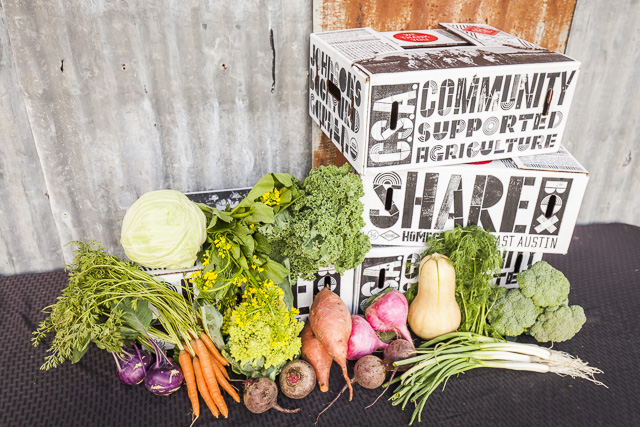 CSA bounty. Photo by Scott David Gordon.
CSA bounty. Photo by Scott David Gordon.
Let’s create intentions that set us up to attain overall better well-being. We could all do a little more for our bodies, and in 2018, why don’t we all aim to brighten our plates, make more meals, become more in tune with our environment, and ameliorate our diets once and for all. Easy enough, right? As we all strive for health in the new year, consider one life hack that is sure to bring welcome and easy change, our CSA! A simple and painless delivery service that ensures organic and fresh produce will be integrated into your diet week after week!
If you are a new customer or have been taking a hiatus, sign up now through the end of January and get your first box free! Yep, you heard us right, FREE! A new year means a new you. It’s a great way to integrate fresh, organic produce into your daily regimen. It’s the perfect nudge you’ve been waiting for, so don’t dally, the offer ends January 31st! To join (or rejoin) the CSA click here and use the promo code: getcookin2 or call the farm at 512.386.5273.
 Farmers Market CSA pickup. Photo by Scott David Gordon.
Farmers Market CSA pickup. Photo by Scott David Gordon.
Cultivated in East Austin and harvested no more than a day or two before reaching your doorstep, our certified organic fruits and vegetables (Over 200 varieties) are at peak nutrition and flavor. Getting a CSA share with JBG means you know exactly where your food is coming from and how it's grown. GMO? Heck no! You might even see a bunch of flowers in your share during certain months!
Eating locally connects you to the seasons, to the land, and to your own health and wellness. Cucumbers will cool you down in the summer, while braised collards will warm you up when the temperatures start to drop. Enjoy the best pico de gallo of your life during the short window when cilantro, onions, peppers, and tomatoes all overlap, and we promise you'll never go back to the store-bought stuff again. You'll get acclimated with the seasons on a whole new level, and learn about what naturally grows when and why. speaking of cooking: we love this challenge The idea is simple - cook all your meals at home for 30 days, and refrain from going out to eat or picking anything up, and with a weekly CSA the recipe options are endless!
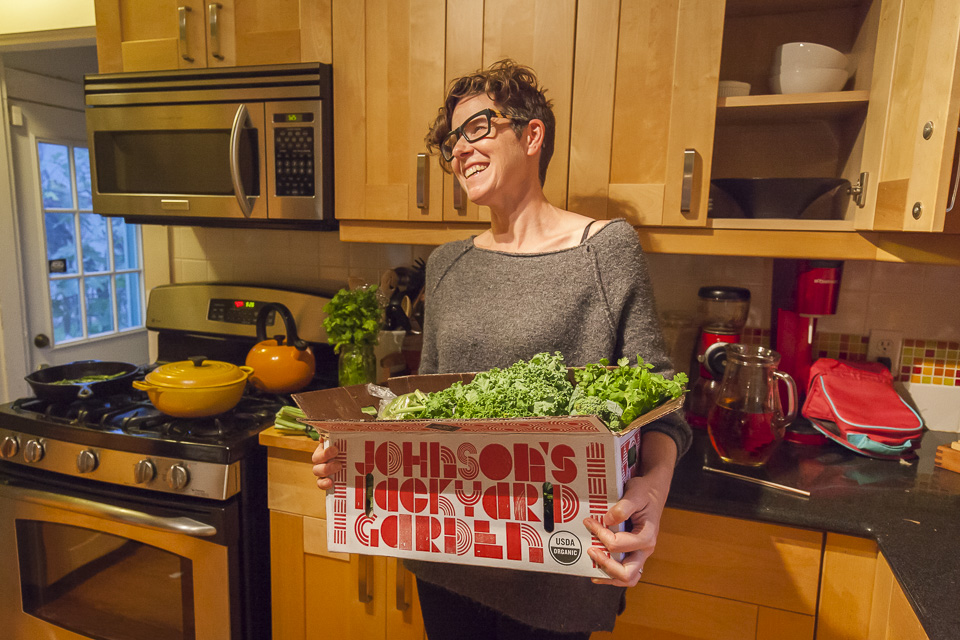 Longtime CSA Member, E. McQueen, enjoying her box at home. Photo by Scott David Gordon.
Longtime CSA Member, E. McQueen, enjoying her box at home. Photo by Scott David Gordon.
Beautifully put by our farm friend, Johannes Courtens: “'Community Supported Agriculture' is a commitment by people, not just for getting food as a reward for paying money, but it’s the idea that they are behind you, and believe in what you are doing. If the farm fails with something during the season, the finances are going to be okay since you have people backing the farm. By providing funds up front, the farm is able to run as efficiently as possible, and not being tied up by all the other clutter, like building the capital.
Trying to grow food first and then sell it is kind of an insane thing. Food is not a commodity, it’s a living thing, but it is a commodity in our economy. What CSA says is that it’s not a commodity, it’s a commitment. It’s something that’s hard to do. If people rally around a farm, it’s like crowdfunding. People are saying, I really think this product idea is awesome. It’s crowdfunding for food. The reward is high quality vegetables for weeks on end.”
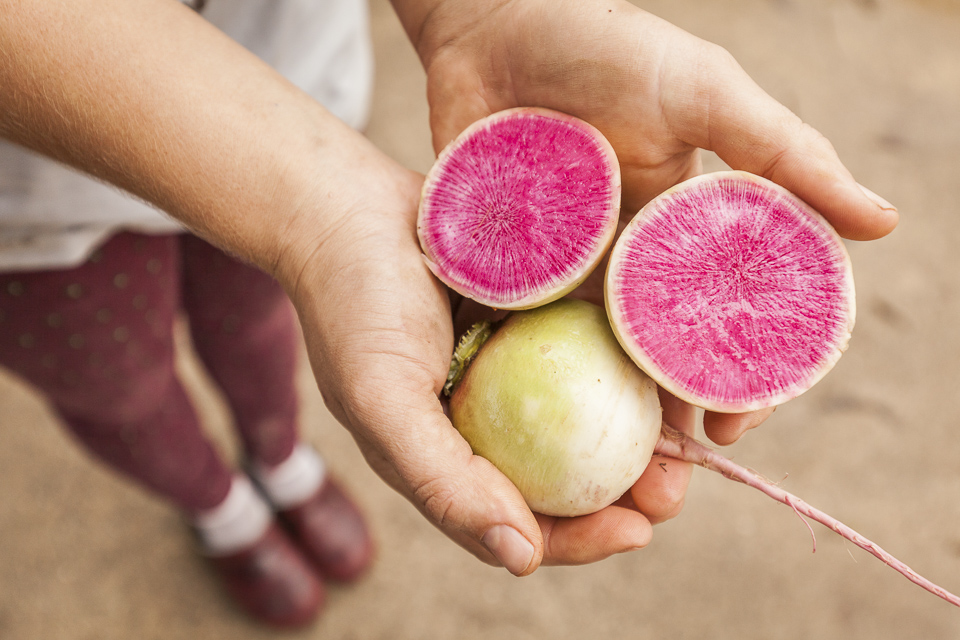 Beautiful watermelon radishes. Photo by Scott David Gordon.
Beautiful watermelon radishes. Photo by Scott David Gordon.
That being said, behind the veggies, are people. When you support our farm, you are supporting the people that toil ceaselessly week after week to plant, harvest, clean, pack, and deliver your veggies. In honor of those people, we thought that we would share some of our favorite seasonal recipes that utilize our favorite wintertime crops.
 Ada. Photo by Scott David Gordon.
Ada. Photo by Scott David Gordon.
ADA (Marketing and CSA Manager):
Thai flavors strike a cord with my pallet. The mixture of sweet, spicy, and sour when coupled with any degree of coconut milk is really like instant bliss in my mouth. A flavor party, perfect for winter nights. Growing up in a somewhat-traditional Cajun kitchen, everything gets served over short-grained rice. Sub the short-grain for jasmine or even brown, and you've got instant comfort food in my opinion. Cooking traditional Thai food intimidates me, but cooking with Thai flavors is something I do often. Below is less of a recipe, and more of a technique for emptying out your CSA box. Any melange of vegetables, cooked with coconut milk and a few "special" spices, and you've got dinner (and lunch for the next day if you're lucky).Winter Thai-ish Curry
All of the ingredients and measurements are suggestions! This recipe works best when you use it as a clean-out technique. Use what you have!
Ingredients:
- 1 1/4 cups of rice. brown, jasmine, or otherwise. I always make extra rice: leftover and somewhat stale rices makes the best stir fry, and believe it or not, cooked rice freezes well. Steam it in the microwave, top with veggies and a fried egg for a back-pocket meal.
- 1 tablespoon of coconut oil or vegetable oil.1 onion or 1 bunch of JBG spring onions, chopped
- 1 tablespoon of ginger, grated. Fresh works best, but I usually use a tablespoon of this that stays stocked in my fridge.
- 2 cloves of garlic, minced.
- 3 carrots, washed and sliced (rounds or matchsticks!)
- About 1/2 cup of sweet potatoes, washed and cubed
- 1-2 cups of kale, collards, or spinach (even cabbage!), chopped.
- Broccoli? Cauliflower? Gold Beets? Kohlrabi? These could all get thrown in as well!
- 2 tablespoons of Thai curry paste
- 1 can of regular coconut milk (not the reduced fat bs). I try to keep this stocked in my pantry for this very dish.
- 1 tablespoon of soy sauce
- Several dashes of fish sauce
- A generous glug of rice vinegar or fresh lime juice (preferable)
- Garnish with cilantro, green onions, or even a sliced watermelon radish. Basil if it's in season.
2. To make the curry, cook your onions in the oil. After soft, add the ginger and garlic and cook for another half minute, or so.
3. Add your carrots and sweet potatoes to the onion mixture. Add a dash of water to help steam those veggies and to prevent burning. After your carrots are about half-way done, add your curry paste and stir to combine.
4. Next, plop in the coconut milk, as well as a 1/2-1 cup of water or broth and a skimpy tablespoon of sugar. Add your greens, and any remaining vegetables. Bring to a simmer, reduce heat, and cook until all vegetables are tender-to your liking. Shouldn't be longer than 20 minutes, probably somewhere around 10.
5. Remove pot from the heat, and add the magic! Season with lime juice, soy sauce, and fish sauce. If it needs more sweet, add some honey or agave nectar. More spice? Top with yellowbird, chili oil, or red pepper flakes.
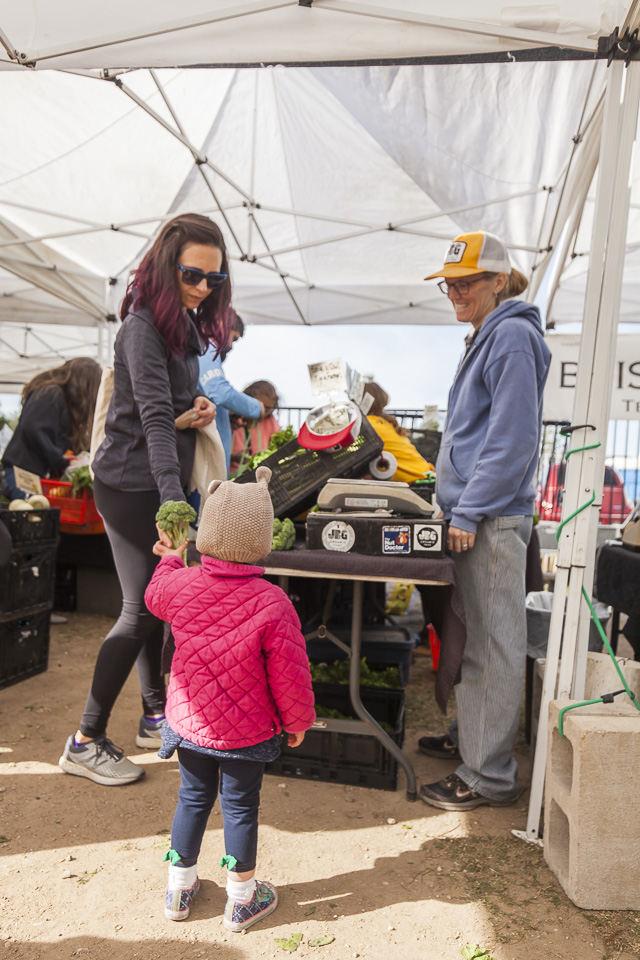 Fawn at the Farmers Market. Photo by Scott David Gordon.
Fawn at the Farmers Market. Photo by Scott David Gordon.
FAWN (Farmers Market Manager):
It's soup season! Attached: creamy carrot soup recipe! Using my own veggie broth, which includes JBG carrots, green onions, parsley, turnips, lemongrass, and really any "leftover" parts of veggies like rutabaga peelings, broccoli stems, fennel stems, carrot tops! Etc.Creamy Carrot Soup
- 1 tbsp butter or vegetable oil
- 1 small onion, chopped
- 1 lb carrots, diced (about 6 medium carrots)
- 2 cups vegetable broth
- 2 tbsp raw white rice
- 1 tsp salt
- Pepper to taste
- ½ tsp crumbled dried thyme
- Bay leaf
- ½ cup of milk
- Sour cream
- 1 tbsp chopped chives for garnish
- Lemongrass and garlic
With a slotted spoon, transfer the carrots and rice to the container of a blender or food processor, leaving as much of the cooking liquid behind you as you can. Puree the mixture. Then, with the machine still running, pour the cooking liquid in through the feed tube or hole in the lid of the container. Blend until the soup is very smooth. Pour the blended soup back into the saucepan and bring to a boil, stirring. Add the milk and heat through without boiling.
Serve soup sprinkled with chopped chives.
**Makes 4 servings
 Taylor spraying down the veggies. Photo by Scott David Gordon.
Taylor spraying down the veggies. Photo by Scott David Gordon.
TAYLOR (Spray Crew):
BBQ Black Eyed Pea Collard RollsBlack Eyed Pea Collard Rolls are hearty, healthy, tangy and plant-based! Bring on the BBQ y'all!
**Vegan + GF **Prep Time 45 minutes **Cook Time 25 minutes **Total Time 1 hour 10 minutes **Servings 8 -9 Rolls
**Author Traci York | Vanilla And Bean
Ingredients
For the Rolls:
- 2 Bunches of Collards enough for 9 Whole Large Leaves, and 3 C Chopped Collards (about
- 1.2lbs / 616g total)
- 1 tsp Coconut Oil
- 1 1/2 C (430g) Slow Cooked Black Eyed Peas drained*
- 2 C (150g) Crimini Mushrooms, stemmed and chopped in small dice
- 3 dashes of Tabasco, or to taste
- 1/8 tsp Salt
- 1/8 tsp Pepper
- 1 BBQ Sauce of choice, we used King's Hawaiian Kona Coffee BBQ Sauce
For the Filling:
Fill a large stockpot 2/3 full of water and bring to a boil. Rinse the collards well and chop off the stem at the base of all the collards. Choose the most intact 9 leaves available for the rolls, set aside. Chop enough of the remaining collards for 3 C packed to be used in the filling. Rinse these in a colander with plenty of water as collards tend to be a bit dirty. Set aside. Place the 9 whole collard leaves in the boiling water and boil for about 6 minutes. If you have a few whole leaves left, you can boil those too, using them to line the casserole dish. Carefully drain the whole leaves in a colander and rinse with cold water. Place a few kitchen towels or paper towels on the counter. Place each leaf, flat, on the towel. Be careful here as the leaves are tender and tear easily.
In a large sauté pan, melt down 1 Tbs of coconut oil. Cook the mushrooms on medium heat until softened and fragrant, stirring only occassionally for about 5 minutes, then add the chopped collards. Cook until just wilted. Turn the heat down to low and add the black eyed peas to the pan and stir to combine ingredients. Add 1/4 C (86g) of the BBQ sauce to the collard mixture. Now is a good time to adjust seasoning to taste. Include Tabasco and salt and pepper.
To Assemble the Rolls:
Preheat oven to 350F. Use pan spray (coconut oil) to coat the bottom and sides of a medium casserole dish. Line the casserole with any extra leaves. Take one collard leaf and place it flat on your work surface. Test the collard to see if the stem will easily bend, as if you're rolling up the collard. If not, gently slice the stem out of slice it so it's thinner. Take about 4 1/2 Tbs of the collard/mushroom/pea mixture and place it towards the base of the collard leaf. Very carefully, begin to roll up the collard leaf, folding the sides over the mixture while continuing to roll (think burrito). If the collard tears a bit, just keep folding and rolling. It will come together. Place the roll into the prepared casserole dish.
Repeat this process until all of the leaves and filling is used up. Cover the casserole dish with foil and bake for 25 minutes, or until the inside of each roll is heated throughly (use a fork to heat-test a roll). If they bake too long, the leaves will begin to lose their vibrant green color. Meanwhile, warm the remaining BBQ sauce in a pan on low for 5 minutes. Drizzle 1/2 of the remaining sauce on rolls and use the final 1/2 for anyone who wants extra! Serve with a side of Jalepenos Cheese Grits.
JALAPEÑO CHEESE GRITS
- 1/4 cup tamed jalapeños
- 1 Tablespoon butter
- 1 Tablespoon chopped garlic
- I box Quick Cooking Grits
- 1/2-1 cup shredded cheese of choice
- Fiesta Brand Jalapeño Salt (optional)
2. Add jalapeños and garlic and lightly smash with a fork into the butter.
3. Add box recommendations for preferred serving of chicken broth and Grits and cook according to box directions.
4. Once Grits have boiled and simmered, remove from heat and stir in cheese. Add Jalapeño Salt to taste and serve warm.
For a vegan option try substituting the broth with a Not Chik'n Bouillion cube mixed to package directions and Nutritional Yeast for the cheese.
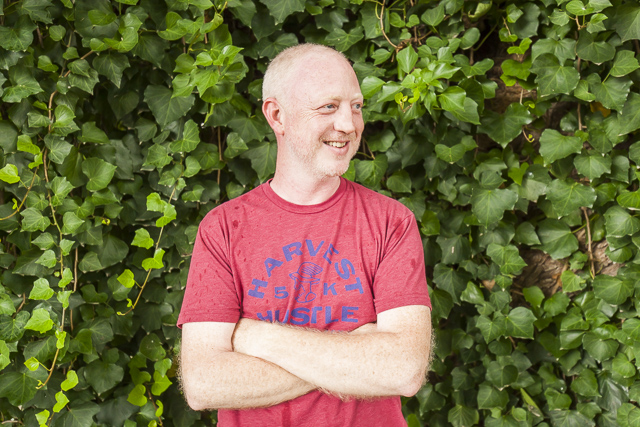 Mike Mo. Photo by Scott David Gordon.
Mike Mo. Photo by Scott David Gordon.
MIKE MO (Wholesale Manager):
This Kohlrabi and Apple Salad by Cookie and Kate is incredible and super simple. Check it out here. It’s yummy. Casey working hard, delivering food donations. Photo by Scott David Gordon.
Casey working hard, delivering food donations. Photo by Scott David Gordon.
CASEY (Customer Service Extraordinaire):
My mom is a CSA member in Houston and she sent me a recipe she likes using our fennel and carrots.Carrot-Fennel Salad
**Makes 8 servings
**Prep time: 20 minutes
- 3 tbsp olive oil
- 3 tbsp white wine vinegar
- 2 tsp Dijon mustard
- ½ tsp salt
- ⅛ tsp black pepper
- 1 large fennel bulb or 2 small bulbs, very thinly sliced
- 1 lb carrots, shaved with vegetable peeler
- ½ cup shelled, unsalted pistachios
- ⅓ cup fresh parsley, chopped
Also, here's a bit about simple veggie fermenting:
Take a mix of whatever veggies you have on hand, I used broccoli, cauliflower, cabbage, carrots and garlic.
Add whatever seasoning you want. I did crushed red pepper and black pepper.
Add all the veggies and seasoning to a jar with a tight sealing lid.
Make a brine (enough to cover all the veggies) of a ratio of 2 cups of water to 1.5 Tbsp of sea salt.
Pour the brine into the jar and seal it tightly.
Let it sit at room temperature for 3-5 days. The longer it ferments, the more flavor and softer the veggies will be.
Be sure to de-gas the mason jar by opening it a couple times during the process since gas will build up inside the jar.
ENJOY!
Your commitment provides so much for the farm - upfront costs for seeds, fuel, and labor to grow the best organic vegetables around, improvements to our CSA offerings like customization and flex scheduling, and wiggle room to invest in larger improvements. There are so many more projects we'd love to take on to continue improving, but we can't do it without your support. Here's to a healthy and happy 2018! 'Til next time!
CSA BOX CONTENTS WEEK OF JAN 8TH
01/08/18 — Scott
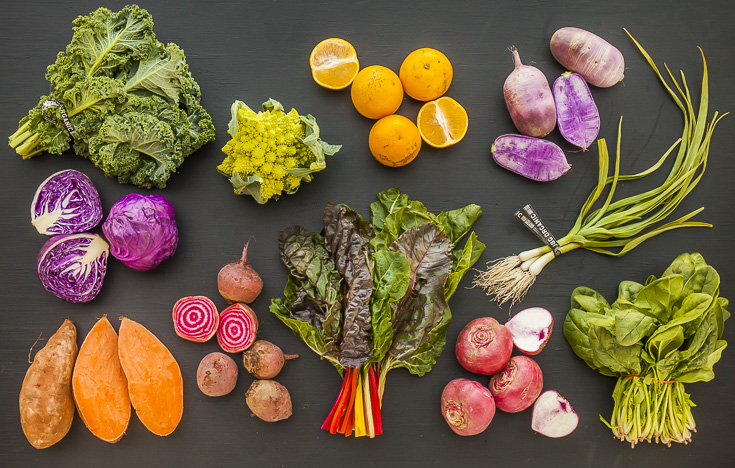 CSA Box Contents Week of Jan 8th
CSA Box Contents Week of Jan 8th
Large Box
Beet, Golden
Broccoli
Carrot, Orange
Citrus, Mixed
Garlic, Green
Greens, Collards
Greens, Kale, Dino
Kohlrabi, Purple
Lettuce, Romaine
Onion, Spring Red
Potato, Sweet
Turnip, Rutabaga
Beet, Golden
Broccoli
Carrot, Orange
Citrus, Mixed
Garlic, Green
Greens, Collards
Greens, Kale, Dino
Kohlrabi, Purple
Lettuce, Romaine
Onion, Spring Red
Potato, Sweet
Turnip, Rutabaga
Medium Box
Beet, Golden
Carrot, Orange
Cauliflower, Romanesco
Garlic, Green
Greens, Kale, Curly
Greens, Spinach
Kohlrabi, Purple
Turnip, Rutabaga
Beet, Golden
Carrot, Orange
Cauliflower, Romanesco
Garlic, Green
Greens, Kale, Curly
Greens, Spinach
Kohlrabi, Purple
Turnip, Rutabaga
Small Box
Broccoli
Carrot, Orange
Greens, Kale, Dino
Greens, Spinach
Onion, Spring Red
Potato, Sweet
Radish, Purple Daikon
Broccoli
Carrot, Orange
Greens, Kale, Dino
Greens, Spinach
Onion, Spring Red
Potato, Sweet
Radish, Purple Daikon
Individual Box
Carrot, Orange
Greens, Collards
Lettuce, Romaine
Potato, Sweet
Radish, Purple Daikon
Carrot, Orange
Greens, Collards
Lettuce, Romaine
Potato, Sweet
Radish, Purple Daikon
CSA BOX CONTENTS WEEK OF JAN 8TH
01/09/18 — Scott
 CSA Box Contents Week of Jan 8th
CSA Box Contents Week of Jan 8th
Large Box
Beet, Chioggia
Cabbage, Red
Carrot, Orange
Cauliflower, Romanesco
Citrus, Oranges
Garlic, Green
Greens, Chard, Rainbow
Greens, Kale, Curly
Greens, Spinach
Potato, Sweet
Radish, Purple Daikon
Turnip, Scarlett
MOROCCAN-STYLE SPINACH SALAD WITH GRILLED SALMON AND CRUNCHY ROOT VEGETABLES
01/11/18 — Heydon Hatcher
Recipe and Photo by Nadia Tamby
Perhaps you made a resolution to eat healthier this year? Maybe you already eat plenty salads and you’re looking for something a little different. I recently traveled for the holidays and came back with some exotic spices to mix up my meals – but don’t worry, you should be able to find all of these at your local grocery store. This salad has so many interesting flavors, components, and textures. You can prepare ahead by grilling the salmon (or protein of your choice) up to two days before (and serving it cold, if you’re into that), or you can grill it the day of and serve it warm on the salad. The dressing is addictive - make double or triple the dressing and use it to top grilled or roasted vegetables later in the week to spice up the rest of your CSA box!
![]()
Ingredients:
Dressing:
Topping:
Instructions:
Zest and juice the lemon into a bowl and add grated garlic (if using), salt and pepper and honey.
Using a mortar and pestle or spice grinder, coarsely grind the cumin and coriander seeds. In a small sauté pan, heat up olive oil then add all 4 spices and fry until fragrant. This should only take a minute, so keep an eye on it. Remove from the heat and drizzle into the lemon-honey mixture and whisk to emulsify (the honey helps to keep the oil and citrus juice from separating too much). I like to use a Microplane grater for the citrus zest and follow up with the garlic clove – and it saves you from the tedious task of chopping garlic.
Use the same sauté pan to toast the pine nuts until lightly browned (watch them carefully as well – they will burn quickly!)
Cut preserved lemons into quarters to make it easier to remove and discard the flesh. Stack up the 4 quarters and slice them very thinly.
Serve the greens and arrange the sliced vegetables and chunks of grilled salmon on each plate.
Drizzle the dressing on the salad and top with the toasted pine nuts and sliced preserved lemon.
Perhaps you made a resolution to eat healthier this year? Maybe you already eat plenty salads and you’re looking for something a little different. I recently traveled for the holidays and came back with some exotic spices to mix up my meals – but don’t worry, you should be able to find all of these at your local grocery store. This salad has so many interesting flavors, components, and textures. You can prepare ahead by grilling the salmon (or protein of your choice) up to two days before (and serving it cold, if you’re into that), or you can grill it the day of and serve it warm on the salad. The dressing is addictive - make double or triple the dressing and use it to top grilled or roasted vegetables later in the week to spice up the rest of your CSA box!
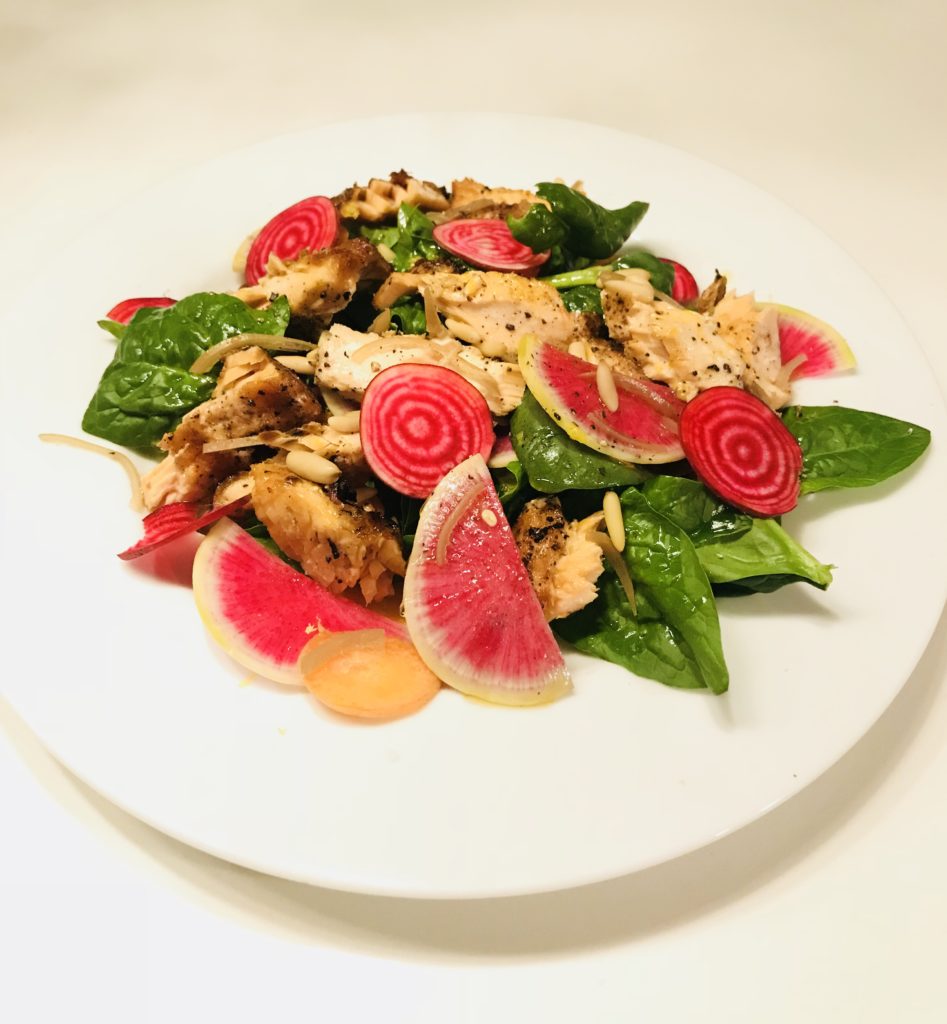
Ingredients:
- Grilled salmon fillet (about 1/3 lb per person)
- 1 bunch spinach, washed and dried, thick stems removed
- Assortment of colorful vegetables cut into different shapes (for this salad I used raw sliced carrots, watermelon radish and Chioggia beets*)
- ½ cup cooked quinoa or other grain
- Salt and pepper, to taste
Dressing:
- 1/3 cup extra virgin olive oil
- ½ teaspoon of each (whole spices): cumin, coriander
- ½ teaspoon of each (ground): cinnamon, paprika (spicy or mild, your choice)
- 1 lemon, zest and juice
- 2 tablespoons raw honey
- 1 garlic clove, grated (optional)
- Salt and pepper, to taste
Topping:
- 1 tablespoon finely sliced preserved lemon* (remove flesh and discard first – you only want to use the peel)
- 2 tablespoons toasted pine nuts
Instructions:
Zest and juice the lemon into a bowl and add grated garlic (if using), salt and pepper and honey.
Using a mortar and pestle or spice grinder, coarsely grind the cumin and coriander seeds. In a small sauté pan, heat up olive oil then add all 4 spices and fry until fragrant. This should only take a minute, so keep an eye on it. Remove from the heat and drizzle into the lemon-honey mixture and whisk to emulsify (the honey helps to keep the oil and citrus juice from separating too much). I like to use a Microplane grater for the citrus zest and follow up with the garlic clove – and it saves you from the tedious task of chopping garlic.
Use the same sauté pan to toast the pine nuts until lightly browned (watch them carefully as well – they will burn quickly!)
Cut preserved lemons into quarters to make it easier to remove and discard the flesh. Stack up the 4 quarters and slice them very thinly.
Serve the greens and arrange the sliced vegetables and chunks of grilled salmon on each plate.
Drizzle the dressing on the salad and top with the toasted pine nuts and sliced preserved lemon.
GAP AUDIT + NICS ORGANIC CERTIFICATION AT JBG!
01/12/18 — Heydon Hatcher
At the end of 2017, we got Good Agricultural Practices or GAP audit certified! Why does this matter, you ask? Well for a handful of reasons. Put simply and pulled from the GAP site: "GAP is a voluntary audit that verifies that fruits and vegetables are produced, packed, handled, and stored as safely as possible to minimize risks of microbial food safety hazards. GAP & GHP audits verify adherence to the recommendations made in the U.S. Food and Drug Administration’s Guide to Minimize Microbial Food Safety Hazards for Fresh Fruits and Vegetables and industry recognized food safety practices." Even as a certified organic farm, it doesn’t mean that things are going to be microbially safe. So, this audit certification ensures an extra layer of trust to our customers. We opted for a third party to come in and make sure that we are sticking to the highest standard of cleanliness possible, and we passed with flying colors.
![]() Krishna showing Ada the Food Safety Policy Plan. Photo by Scott David Gordon.
Krishna showing Ada the Food Safety Policy Plan. Photo by Scott David Gordon.
GAP audit certification not only makes sure that we are adhering to vital food safety practices but also prepares us for the FDA's Food Safety Modernization Act that Obama signed into legislation during his tenure. This is a sweeping reform that tries to prevent contamination instead of responding to it when it occurs. Hardie's Fresh Foods, a produce distributor in town, sponsored us to get audit certified because not only does it make them more reputable in distributing to businesses in the region, but they provide produce to the Austin Independent School District, and no one wants children getting potentially unsafe foods! In conjunction with Greener Fields Together, which is a program run and administered by PRO*ACT that “engages and involves farmers, distributors, foodservice operators and retail locations in efforts to work toward safer produce from seed to fork,” they helped coach us through the whole process. Despite being sponsored, this was something that we have been interested in obtaining for a long time. With two locations and a number of different employees, it’s beneficial to have good standards on procedures, and in turn aids in the process of better mainline training our staff.
Since we didn't have a written down Food Safety Plan prior to the audit, Our Operations Manager, Krishna Raghavan took the lead in writing up a JBG Food Safety Plan along with our Barn Manager, Tracy Whitehead, and our Farm Manager, Becky. The whole process took more than two months to complete. We had procedures in place, but had not gone through each step and written out the standard operating procedures for all aspects of the farm in both locations and in all departments. Needless to say, this has been quite the logistical feat. Tracy, our Barn Manager, went through the Produce Safety Alliance Grower Training, and was deeply vital in preparing the SOPs and aiding in training all the other JBG employees on the New Food Safety Guidelines as a part of FSMA. This includes everything from how we sanitize bins, check temperatures in the coolers, ensuring water is managed properly, hand washing methods and frequency, dress code, scenarios on how to deal with sickness and injury, how we manage and rotate produce, where we keep supplies, how to sanitize supplies, how to transport vegetables, and the list goes on. The work is decentralized, so everyone does their bit to adhere to the guidelines.
![]() Tracy cleaning the tools. Photo by Scott David Gordon.
Tracy cleaning the tools. Photo by Scott David Gordon.
Not only did this audit occur at the Hergotz barn, but also out at the River Road farm. Becky was immensely integral in educating the farm about implementing GAP procedures. Out at the River Road location, we had to provide field history, water system information, soil amendments information and procedure, sanitation of farm vehicles and equipment, harvest crew hygiene, storage of tools, and so on.
We even had to do a mock recall of kale and retrace the “contaminated” vegetable from the customer back to the field. Our Operations Manager, Krishna, was most proud of this feat. Starting from our Wholesale Manager, Mike Mo, we have such detailed documentation that it is possible to track the vegetable back to the exact tract of land from whence it came. We can figure out when it was fertilized, what kind of fertilizer was used and how often, if it was transplanted or direct seeded, and even where the seeds came from initially. Pretty wild, right?
![]() Krishna and Becky with the NICS inspector.
Krishna and Becky with the NICS inspector.
After we went through the GAP Audit on November 15th, it was time for us to get ready for the annual NICS Organic Certification Inspection. This is our annual inspection to ensure that we are using organic practices in all aspects of the farm from seed to harvest. Just in case you were wondering, we are certified organic by Nature's International Certification Services (NICS), based out of Wisconson. The NICS inspector started off with a thorough inspection of the seeds cooler and the storage shed where we keep our fertilization and spray supplies. She also inspected the facilities, tools, amendments, soils, etc. After the field visit, the inspection continued to the barn / packing shed and conducted a sit-down inspection / interview with Krishna on all our records from the previous year (on all the inputs, to make sure the seeds are organic and or untreated and the inputs are compatible with organic certification guidelines). We also had a walk through audit of a crop: tracking the purchase of seed through our greenhouse and planting in the field, to weeding and pest management, to harvest and finally to the customer (the opposite of the GAP audit which warrants a tracking from customer to seed). We went into the details of everything from our buffer zones around the farm, to logo colors and placement on our CSA boxes. It's an extremely long and detailed process, but thanks to a hard working staff, we have all of our ducks in a row.
After the organic certification inspection, Krishna went through the exit interview with the inspector and all the concerns if any were listed by the inspector. We are proud that this year we did not have any issues listed at the time of exit interview and all the documents were submitted to the inspector's satisfaction. Yeehaw! So enjoy those certified veggies, folks. 'Til next time!
![]() Krishna with the JBG Food Safety Policy Plan. Photo by Scott David Gordon.
Krishna with the JBG Food Safety Policy Plan. Photo by Scott David Gordon.
 Krishna showing Ada the Food Safety Policy Plan. Photo by Scott David Gordon.
Krishna showing Ada the Food Safety Policy Plan. Photo by Scott David Gordon.
GAP audit certification not only makes sure that we are adhering to vital food safety practices but also prepares us for the FDA's Food Safety Modernization Act that Obama signed into legislation during his tenure. This is a sweeping reform that tries to prevent contamination instead of responding to it when it occurs. Hardie's Fresh Foods, a produce distributor in town, sponsored us to get audit certified because not only does it make them more reputable in distributing to businesses in the region, but they provide produce to the Austin Independent School District, and no one wants children getting potentially unsafe foods! In conjunction with Greener Fields Together, which is a program run and administered by PRO*ACT that “engages and involves farmers, distributors, foodservice operators and retail locations in efforts to work toward safer produce from seed to fork,” they helped coach us through the whole process. Despite being sponsored, this was something that we have been interested in obtaining for a long time. With two locations and a number of different employees, it’s beneficial to have good standards on procedures, and in turn aids in the process of better mainline training our staff.
Since we didn't have a written down Food Safety Plan prior to the audit, Our Operations Manager, Krishna Raghavan took the lead in writing up a JBG Food Safety Plan along with our Barn Manager, Tracy Whitehead, and our Farm Manager, Becky. The whole process took more than two months to complete. We had procedures in place, but had not gone through each step and written out the standard operating procedures for all aspects of the farm in both locations and in all departments. Needless to say, this has been quite the logistical feat. Tracy, our Barn Manager, went through the Produce Safety Alliance Grower Training, and was deeply vital in preparing the SOPs and aiding in training all the other JBG employees on the New Food Safety Guidelines as a part of FSMA. This includes everything from how we sanitize bins, check temperatures in the coolers, ensuring water is managed properly, hand washing methods and frequency, dress code, scenarios on how to deal with sickness and injury, how we manage and rotate produce, where we keep supplies, how to sanitize supplies, how to transport vegetables, and the list goes on. The work is decentralized, so everyone does their bit to adhere to the guidelines.
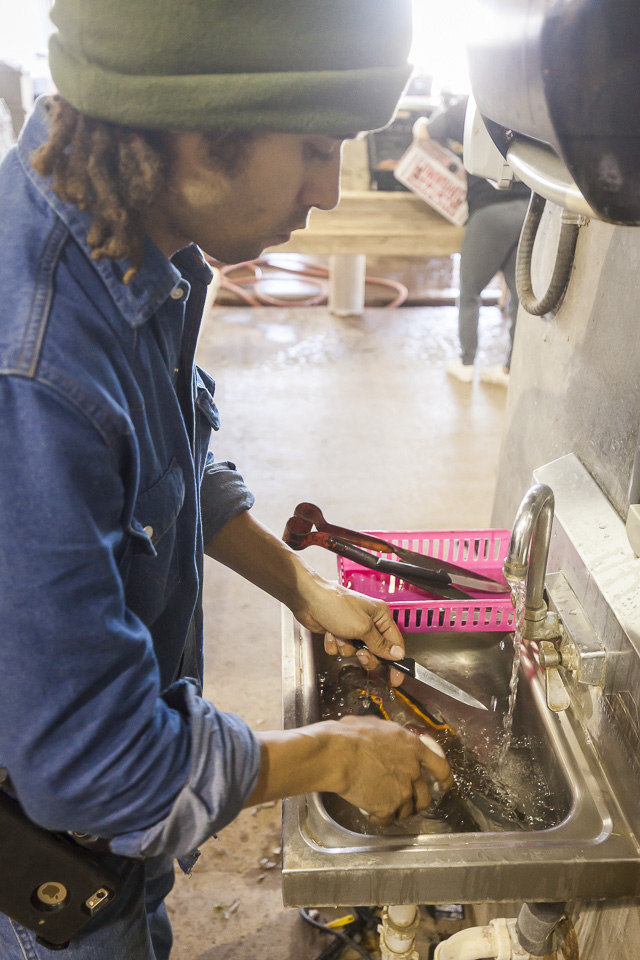 Tracy cleaning the tools. Photo by Scott David Gordon.
Tracy cleaning the tools. Photo by Scott David Gordon.
Not only did this audit occur at the Hergotz barn, but also out at the River Road farm. Becky was immensely integral in educating the farm about implementing GAP procedures. Out at the River Road location, we had to provide field history, water system information, soil amendments information and procedure, sanitation of farm vehicles and equipment, harvest crew hygiene, storage of tools, and so on.
We even had to do a mock recall of kale and retrace the “contaminated” vegetable from the customer back to the field. Our Operations Manager, Krishna, was most proud of this feat. Starting from our Wholesale Manager, Mike Mo, we have such detailed documentation that it is possible to track the vegetable back to the exact tract of land from whence it came. We can figure out when it was fertilized, what kind of fertilizer was used and how often, if it was transplanted or direct seeded, and even where the seeds came from initially. Pretty wild, right?
 Krishna and Becky with the NICS inspector.
Krishna and Becky with the NICS inspector.
After we went through the GAP Audit on November 15th, it was time for us to get ready for the annual NICS Organic Certification Inspection. This is our annual inspection to ensure that we are using organic practices in all aspects of the farm from seed to harvest. Just in case you were wondering, we are certified organic by Nature's International Certification Services (NICS), based out of Wisconson. The NICS inspector started off with a thorough inspection of the seeds cooler and the storage shed where we keep our fertilization and spray supplies. She also inspected the facilities, tools, amendments, soils, etc. After the field visit, the inspection continued to the barn / packing shed and conducted a sit-down inspection / interview with Krishna on all our records from the previous year (on all the inputs, to make sure the seeds are organic and or untreated and the inputs are compatible with organic certification guidelines). We also had a walk through audit of a crop: tracking the purchase of seed through our greenhouse and planting in the field, to weeding and pest management, to harvest and finally to the customer (the opposite of the GAP audit which warrants a tracking from customer to seed). We went into the details of everything from our buffer zones around the farm, to logo colors and placement on our CSA boxes. It's an extremely long and detailed process, but thanks to a hard working staff, we have all of our ducks in a row.
After the organic certification inspection, Krishna went through the exit interview with the inspector and all the concerns if any were listed by the inspector. We are proud that this year we did not have any issues listed at the time of exit interview and all the documents were submitted to the inspector's satisfaction. Yeehaw! So enjoy those certified veggies, folks. 'Til next time!
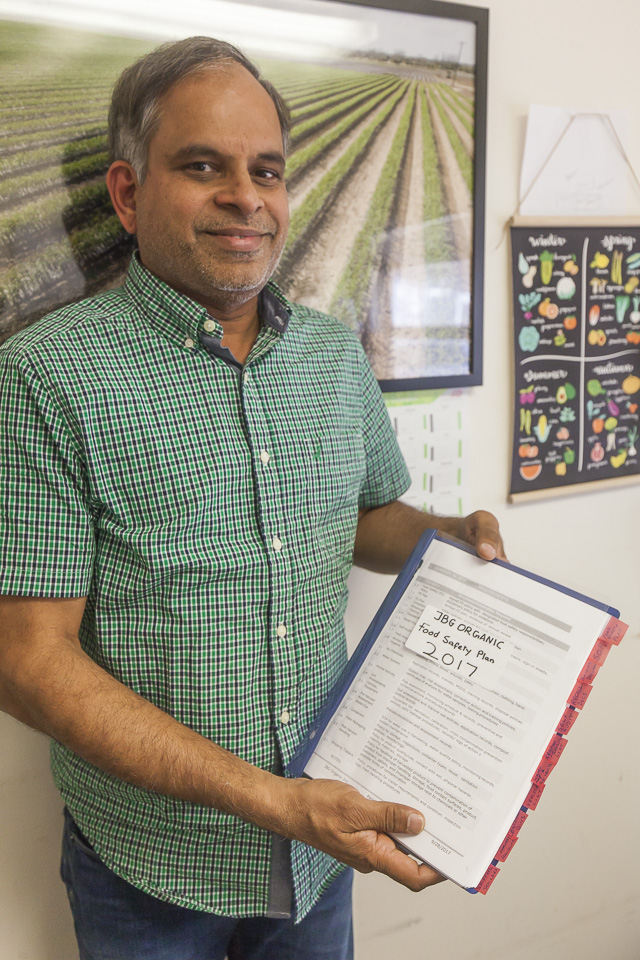 Krishna with the JBG Food Safety Policy Plan. Photo by Scott David Gordon.
Krishna with the JBG Food Safety Policy Plan. Photo by Scott David Gordon.WEEK 2 IN PHOTOS
01/12/18 — Heydon Hatcher
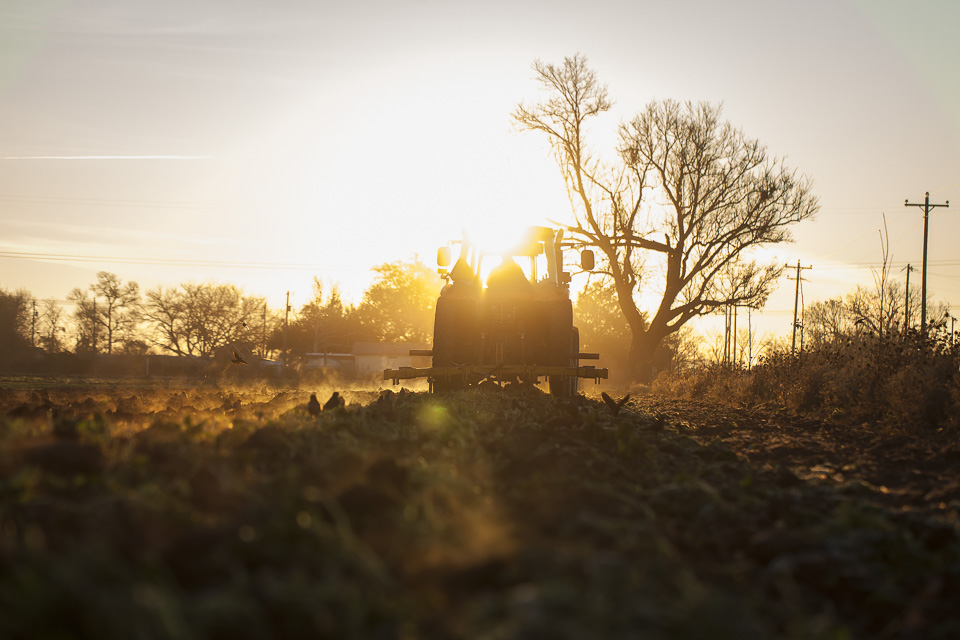 Montana at the helm. Photo by Scott David Gordon.
Montana at the helm. Photo by Scott David Gordon.
Week 2 has us enjoying Spring-like weather, transplanting, reveling in the year past, and planning for the one ahead. We are prepping beds and readying for a busy planting season ahead. Our CSA boxes are of optimal quality and beauty currently. Have you heard that if you join the CSA this month, you get your first box free? Check it out here.
 Montana at the helm. Photo by Scott David Gordon.
Montana at the helm. Photo by Scott David Gordon.
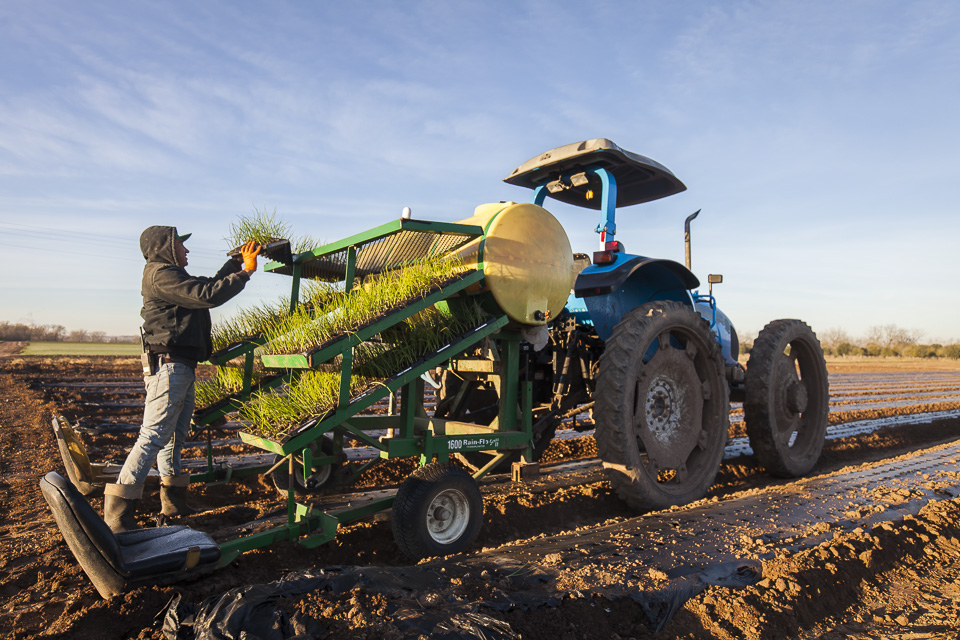 Getting the transplants ready. Photo by Scott David Gordon.
Getting the transplants ready. Photo by Scott David Gordon.
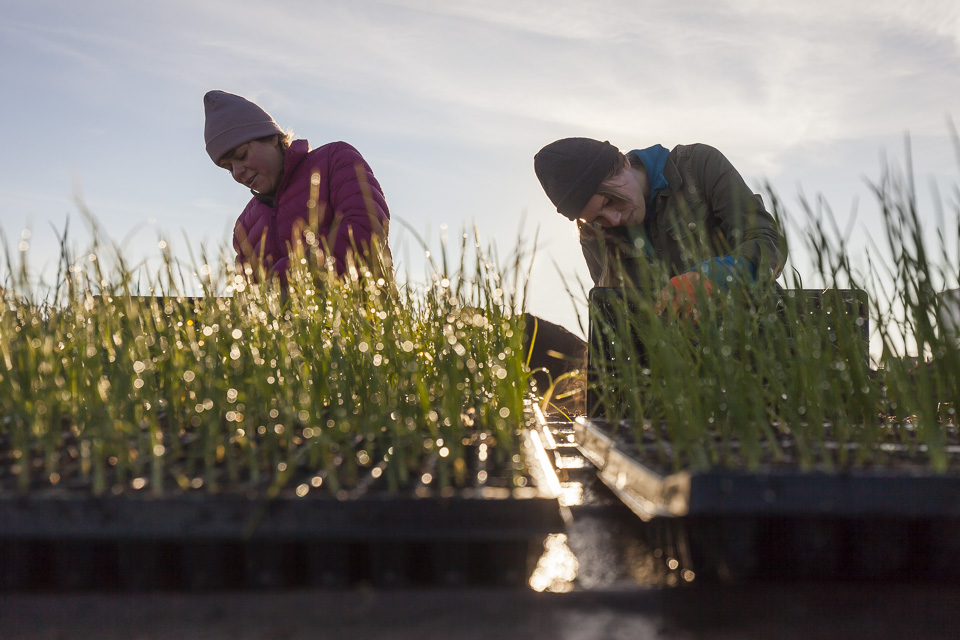 Transplant work. Photo by Scott David Gordon.
Transplant work. Photo by Scott David Gordon.
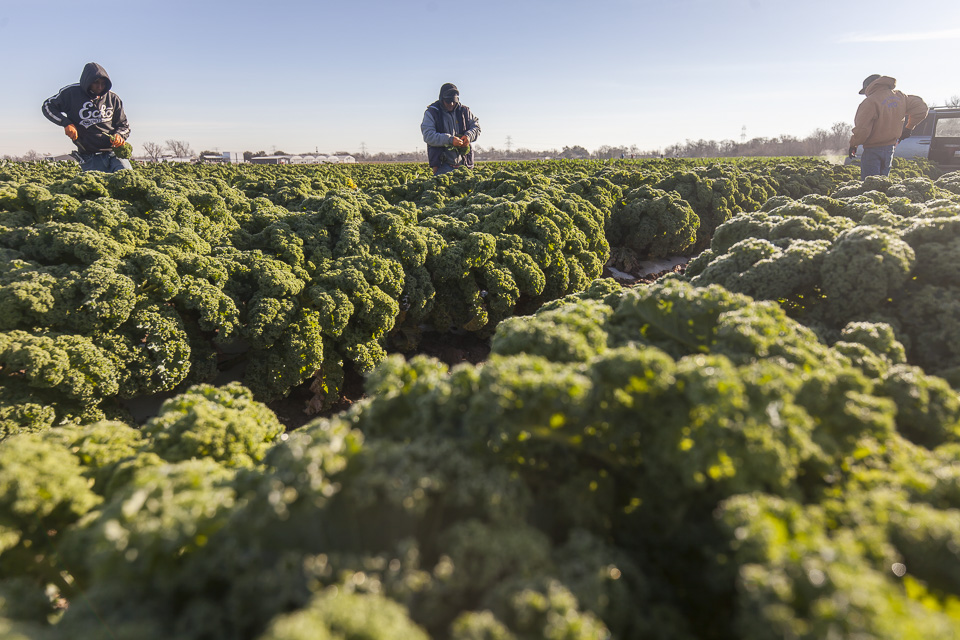 Kale field glory. Photo by Scott David Gordon.
Kale field glory. Photo by Scott David Gordon.
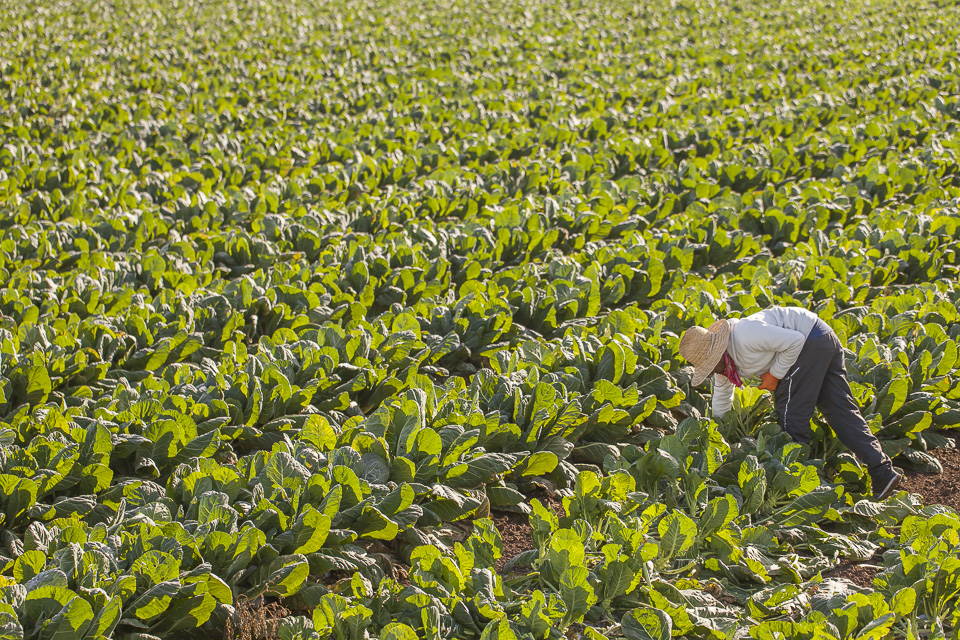 Harvesting. Photo by Scott David Gordon.
Harvesting. Photo by Scott David Gordon.
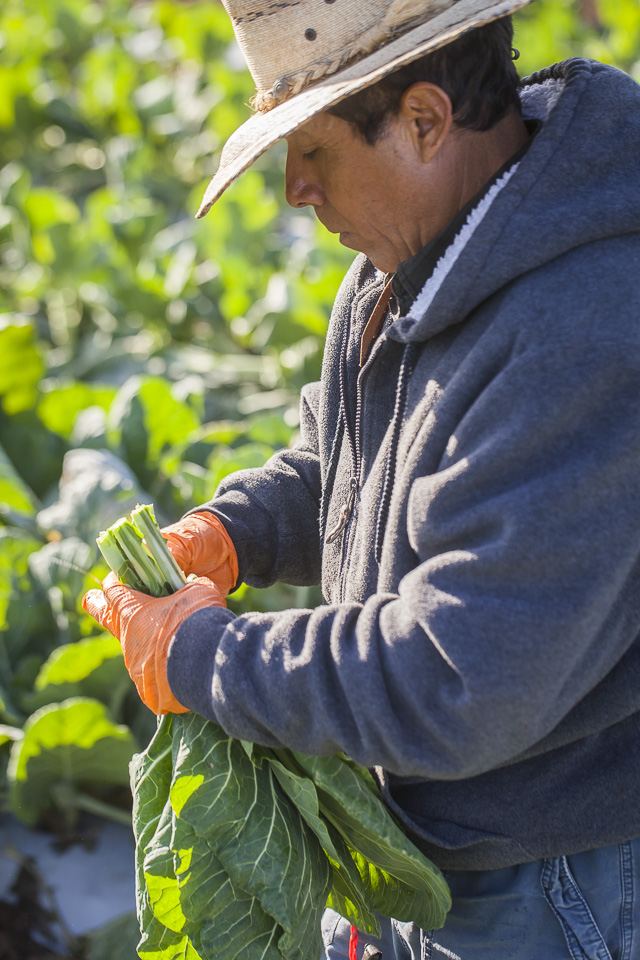 Tying up collard bunches. Photo by Scott David Gordon.
Tying up collard bunches. Photo by Scott David Gordon.
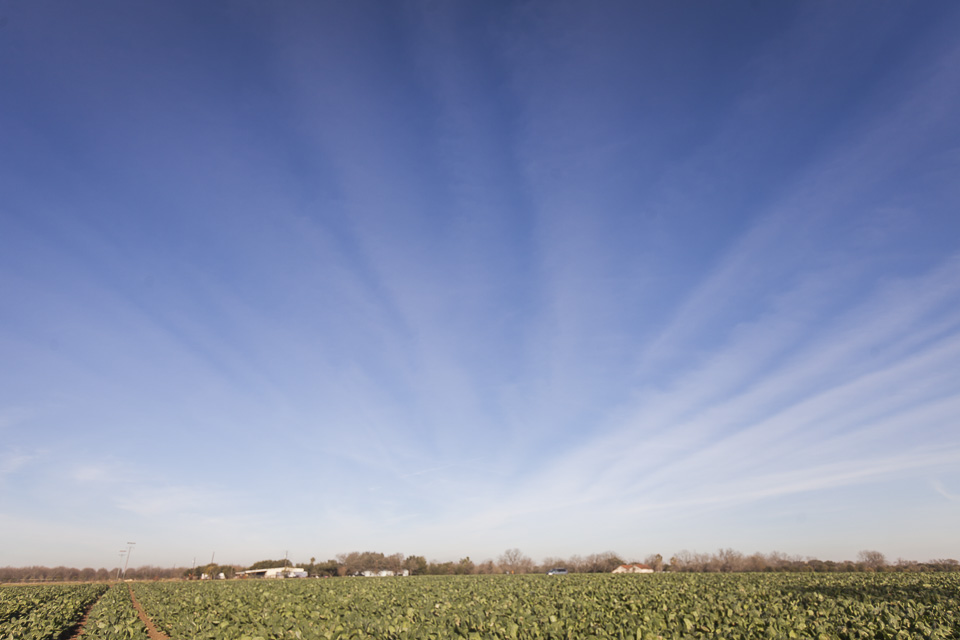 Vast blue skies. Photo by Scott David Gordon.
Vast blue skies. Photo by Scott David Gordon.
 Ada and her chioggia eyes. Photo by Scott David Gordon.
Ada and her chioggia eyes. Photo by Scott David Gordon.CSA BOX CONTENTS WEEK OF JAN 15TH
01/16/18 — Scott
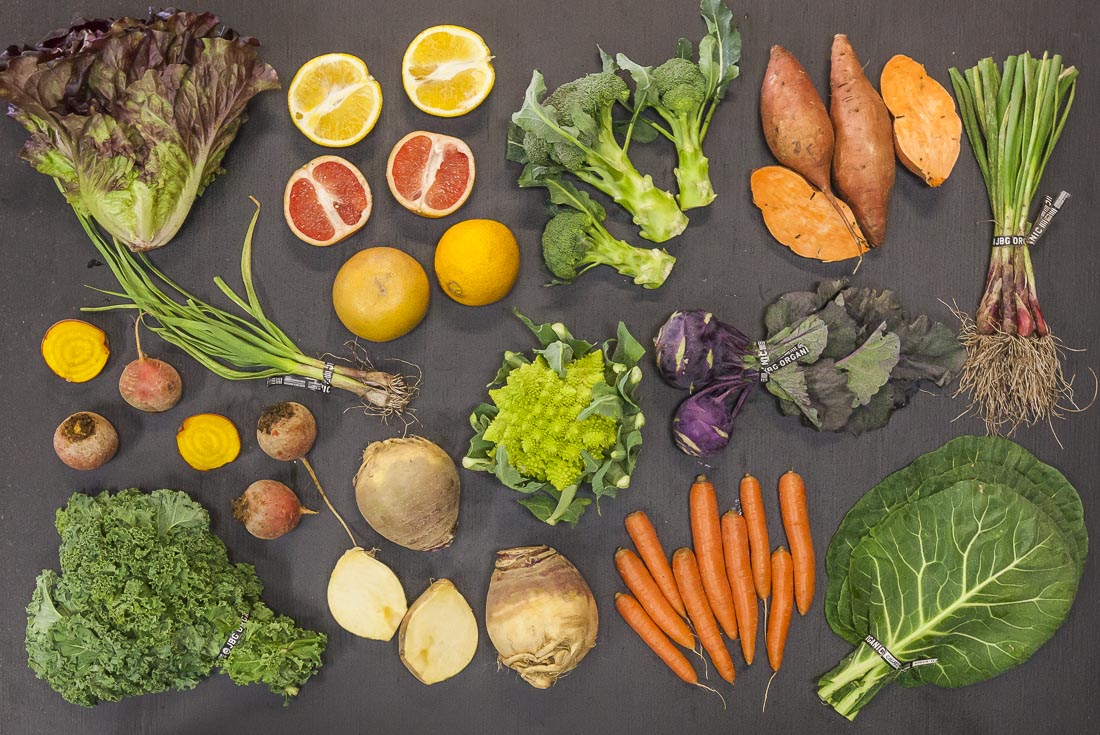 CSA Box Contents Week of Jan 15th
CSA Box Contents Week of Jan 15th
Large Box
Brussels Sprouts
Carrot, Orange
Cauliflower
Citrus, Mixed
Greens, Collards
Greens, Kale, Curly
Lettuce, Romaine
Onion, Spring Red
Potato, Sweet
Radish, Purple Daikon
Squash, Butternut
Turnip, Scarlett
Brussels Sprouts
Carrot, Orange
Cauliflower
Citrus, Mixed
Greens, Collards
Greens, Kale, Curly
Lettuce, Romaine
Onion, Spring Red
Potato, Sweet
Radish, Purple Daikon
Squash, Butternut
Turnip, Scarlett
Medium Box
Brussels Sprouts
Carrot, Orange
Citrus, Mixed
Greens, Collards
Lettuce, Romaine
Onion, Spring Red
Potato, Sweet
Radish, Purple Daikon
Squash, Butternut
Brussels Sprouts
Carrot, Orange
Citrus, Mixed
Greens, Collards
Lettuce, Romaine
Onion, Spring Red
Potato, Sweet
Radish, Purple Daikon
Squash, Butternut
Small Box
Garlic, Green
Greens, Collards
Greens, Kale, Red
Kohlrabi, Purple
Lettuce, Red Leaf
Potato, Sweet
Turnip, Rutabaga
Garlic, Green
Greens, Collards
Greens, Kale, Red
Kohlrabi, Purple
Lettuce, Red Leaf
Potato, Sweet
Turnip, Rutabaga
Individual Box
Broccoli
Greens, Collards
Lettuce, Red Leaf
Potato, Sweet
Turnip, Scarlett
Broccoli
Greens, Collards
Lettuce, Red Leaf
Potato, Sweet
Turnip, Scarlett
CSA BOX CONTENTS WEEK OF JAN 15TH
01/16/18 — Scott
 CSA Box Contents Week of Jan 15th
CSA Box Contents Week of Jan 15th
Large Box
Beet, Golden
Broccoli
Carrot, Orange
Citrus, Mixed
Garlic, Green
Greens, Collards
Greens, Kale, Dino
Kohlrabi, Purple
Lettuce, Romaine
Onion, Spring Red
Potato, Sweet
Turnip, Rutabaga
A SALAD THING
01/18/18 — Heydon Hatcher
Recipe and Photo by Mackenzie Smith
Megan Winfrey said something about culinary genius when I shared a picture of this salad thing on Instagram yesterday afternoon. Blushing (and swooning; Megan is so cool), I quickly assured her this meal had less to do with genius and more to do with Sunday prep.
I keep a few ingredients available for meals that come together very quickly. As I typed my response, I realized my take-10-minutes-and-compose-a-pretty-salad thing is more formulaic than anything.
![]()
Full-fat Greek yogurt + grain + green + roasted veg + avocado + citrus + egg + something crunchy + flaky sea salt + one more color = a pretty salad thing.
When I am doing life the way I should, I roast a big batch of veggies on Sunday afternoon. As they sizzle in the oven, a few cups of quinoa, farro or brown rice simmer on the stove while a dozen eggs boil for 6.5-7 minutes, all to to stow away for the week ahead.
A quick swoop of a heaping tablespoonful of yogurt onto the plate before loading it with veggies is a creamy punch of tang to everything I pile on top. Yesterday’s lunch had it all, but there is always room to riff:
Shaving one or two rainbow carrots into a quick salad is fun for another burst of color -- these were marinated in meyer lemon, maple syrup, olive oil and salt. Grapefruit is such a treat this time of year, so I try to make sure a few slices or supremes land in a meal a day at the peak of their season.
Right now I have pecans, pepitas, sesame and walnuts in glass jars out in my kitchen to sprinkle on everything for crunch and protein. This dish needed more green, so raw pepitas were sprinkled on top. Sometimes the only crunch around is the last of a bag of tortilla chips (dare I say, hot cheetos!) and those will be sprinkled on top just as delicately as the nuts and seeds. I keep a jar of dried cornflowers out to sprinkle on everything. I’ve heard they are good for eye health, but I use them because I am delighted by their periwinkle hue.
When I have an abundance of herbs, and those will go into the salad, either sprinkled on top and mixed in with the grains. All this to say, starting your week with cooked grains, roasted veggies and boiled eggs at the ready is a good foundation for genius salad thing math. Choose your own adventure, y’all!
Megan Winfrey said something about culinary genius when I shared a picture of this salad thing on Instagram yesterday afternoon. Blushing (and swooning; Megan is so cool), I quickly assured her this meal had less to do with genius and more to do with Sunday prep.
I keep a few ingredients available for meals that come together very quickly. As I typed my response, I realized my take-10-minutes-and-compose-a-pretty-salad thing is more formulaic than anything.
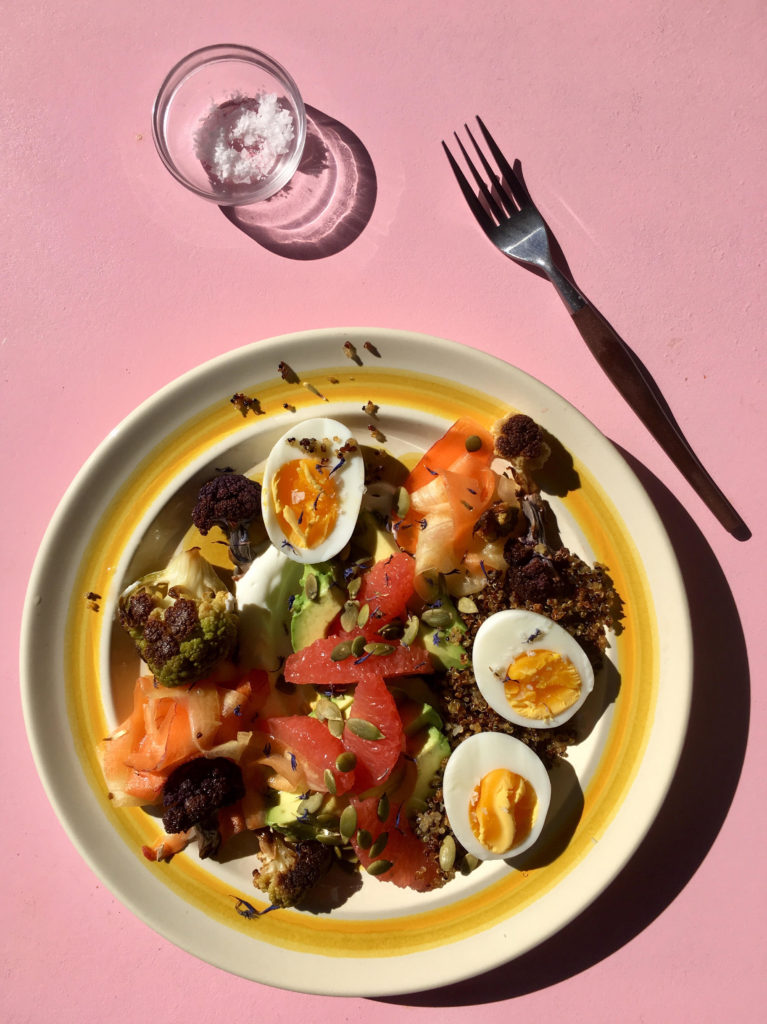
Full-fat Greek yogurt + grain + green + roasted veg + avocado + citrus + egg + something crunchy + flaky sea salt + one more color = a pretty salad thing.
When I am doing life the way I should, I roast a big batch of veggies on Sunday afternoon. As they sizzle in the oven, a few cups of quinoa, farro or brown rice simmer on the stove while a dozen eggs boil for 6.5-7 minutes, all to to stow away for the week ahead.
A quick swoop of a heaping tablespoonful of yogurt onto the plate before loading it with veggies is a creamy punch of tang to everything I pile on top. Yesterday’s lunch had it all, but there is always room to riff:
Shaving one or two rainbow carrots into a quick salad is fun for another burst of color -- these were marinated in meyer lemon, maple syrup, olive oil and salt. Grapefruit is such a treat this time of year, so I try to make sure a few slices or supremes land in a meal a day at the peak of their season.
Right now I have pecans, pepitas, sesame and walnuts in glass jars out in my kitchen to sprinkle on everything for crunch and protein. This dish needed more green, so raw pepitas were sprinkled on top. Sometimes the only crunch around is the last of a bag of tortilla chips (dare I say, hot cheetos!) and those will be sprinkled on top just as delicately as the nuts and seeds. I keep a jar of dried cornflowers out to sprinkle on everything. I’ve heard they are good for eye health, but I use them because I am delighted by their periwinkle hue.
When I have an abundance of herbs, and those will go into the salad, either sprinkled on top and mixed in with the grains. All this to say, starting your week with cooked grains, roasted veggies and boiled eggs at the ready is a good foundation for genius salad thing math. Choose your own adventure, y’all!
CHEF SPOTLIGHT: GABE ERALES OF DAI DUE TAQUERIA
01/19/18 — Heydon Hatcher
This week we are honored to have had the immense pleasure of conducting our inaugural Chef Spotlight series with the highly skilled and seemingly ubiquitous, Gabe Erales. Hailing from El Paso with deep familial roots in the Yucatan, Gabe is a Renaissance family man trained as a mechanical engineer. He is also the head chef for the freshly opened, Dai Due Taqueria at the new FareGround food hall in the heart of Downtown Austin.
We met at the new downtown location (lauded by Money Inc as one of the seven most anticipated food hall openings in the world) shortly before the grand opening this week, a stunning space designed by none other than Michael Hsu, and learned all about Gabe's cooking tenure, his influences, and his undying passion for a bona fide and carefully constructed taco. Get to know this guy, and get down to the new Dai Due Taqueria pronto, you won't regret it.
![]() Gabe Erales leaning on the corn grinder in the Dai Due Taqueria kitchen. Photo by Timothy Patrick Clancy.
Gabe Erales leaning on the corn grinder in the Dai Due Taqueria kitchen. Photo by Timothy Patrick Clancy.
Where are you from and how did you get into cooking?
I grew up in El Paso, Texas… west Texas on the border. I got into cooking mostly because of the influence of Mexican cooking from my mom and dad. My family actually came from Mexico in the Yucatan peninsula, Quintana Roo, to El Paso. My mom was always cooking for a big family. I have 5 brothers and a sister, there are 7 of us in total. She was always doing large format style cooking to keep us all fed. One thing that stands out in my mind is she would make cochinita pibil which is something that we have on the menu here. It’s really special to me, it’s a pork braise that is wrapped in banana leaves and cooked in sour oranges, annatto seeds, chiles (it’s bright red), and served with pickled onions and habaneros. We are doing the same thing here but with feral hog. It’s delicious. That kind of stuff, tamales and general Mexican preparations that she grew up eating and feeding to me, really sparked my interested in cooking. Above all, I started working in kitchens when I was 15 because my older brothers were already working in restaurants as their after school jobs. That was my way of making money ever since I started cooking with an exception of a brief period after school… I started as a busboy at Steak and Ale, moved to prep, and worked in restaurants all through high school. I moved to Austin to attend UT and was supporting myself in restaurants while I was studying engineering. I actually have a Bachelors and Masters in mechanical engineering. While I was studying, I was working in restaurants and basically running from school to work, and from work to studying. After I graduated from UT, I was working for General Motors in Detroit doing design. I started really missing cooking and being in the kitchen, so I got back into it and it's kind of been full speed ever since. I've always been doing a million things at once it's always been a good balance for me.
![]() Yummy meats on a spit. Photo by Timothy Patrick Clancy.
Yummy meats on a spit. Photo by Timothy Patrick Clancy.
Where all have you cooked in town?
I've worked at Fonda San Miguel, and that was a really big influence for me because I feel like because they were the institution of Mexican cooking in town. They were probably the first people to do nixtamalization and fresh masa in house daily, which most people use flour maseca… fresh masa in house makes a huge difference. They have incredible moles, and very authentic regional preparations. Miguel Ravago, the founder, owner, and chef, who recently passed away last year, was involved with a lot of really notable chefs and would involve them in his menu. A lot of great chefs have passed through that establishment. Diana Kennedy was always there consulting on moles which is huge, huge, huge. I worked at La Condesa (under Rene Ortiz) which also had a ton of great chefs passing through there as well. Their food is amazing... Rick, who is still the chef there, is doing an amazing job. I worked at Odd Duck and Qui. I helped open Dai Due - the sister restaurant to this Taqueria, and I helped open up the Geraldine’s restaurant in the Hotel Van Zandt (was there for about two years, as sous chef). I left there to go work in the test kitchen for the Noma Mexico team with Rene Redzepi and helped with the menu development in Tulum. When I returned I was focusing on this project, and that’s what I’ve been involved with ever since.
Tell us about your newest project!
Well, this is the Dai Due Taqueria. It’s located in the new FareGround food hall on Cesar Chavez and Congress. There are 6 permanent restaurants here along with a full bar. I'm head chef here. Jesse Griffith obviously is still the chef and owner at both restaurants, but as far as menu and the day to day operations, I'm your guy.
![]() Dai Due Taqueria at FareGround. Photo by Timothy Patrick Clancy.
Dai Due Taqueria at FareGround. Photo by Timothy Patrick Clancy.
What item are you most excited about on your menu?
There are two things. Number one is the trumpo, it’s the meat over there that looks like a gyro meat. We call it the trompo al pastor. It's very special because we're cooking over Texas charcoal, which a friend of mine makes here in town. The actual meat is wild boar, it's been brined and marinated. I think everyone loves an al pastor taco, so this is really, really special. Also, there's a torta called a pambazo. It's essentially a torta bread that's been dipped in very spicy chili broth. We take bone broth and infuse it with a lot of chiles. It's really bright red and really thick with a lot of body, kind of like a ramen broth. Then we get the torta, and fill it with wild boar chorizo, potatoes, avocado, and cheese. All of that gets melted together, then dipped in that broth, and then regrilled on a flat top. It’s this bright red sandwich that's crispy, has some char marks, and when you bite into it you get this really nice crispy cabbage and radish taste, too. It’s a very Mexico City style torta. I've yet to see one of those in the city here in Austin so I'm really excited that we're kind of introducing our version of it to people.
![]() The trompo meat. Photo by Timothy Patrick Clancy.
The trompo meat. Photo by Timothy Patrick Clancy.
What is the most surprising thing about working with farms?
I think the most surprising thing to me is that for the longest time people just accepted what was sold. You go to the farmers market, there's carrots, cabbage, cauliflower, garlic, and onions… and you worked with that. However, the relationship between the farmer and the chef has grown so much. Now we partner together, I tell a farmer what I want for my menu, and then they in turn buy seed and try to grow ingredients accordingly. People are growing stuff that you would have never seen grown in Texas previously! There's a girl here in town who's growing extremely rare chiles, chihuacles, and those are even rare in Mexico. So, for them to be grown in Austin is mind-blowing and exciting. I'm working with other people here that are growing some special Mexican herbs, and I have stuff that I brought back from Mexico, a wild mexican spinach.
Tell us about your relationship with JBG?
My first introduction to local farmers was through Johnson's Backyard Garden, back when y’all were extremely small. Brent was at all the Farmers Markets himself, and hosting everybody on the farm very often. So, that's why I still do business with JBG... it's really special to me, and I think a lot of the product is just really amazing. Y’all have grown so much - I hear you deliver to Houston, Dallas, San Antonio… wild.
![]() JBG produce in the kitchen. Photo by Timothy Patrick Clancy.
JBG produce in the kitchen. Photo by Timothy Patrick Clancy.
What is the most difficult part about working with farms and sourcing locally?
The most difficult part is the commercial and logistical side of things. People like Farm to Table have changed the game in that it's a one stop shop. You can call them and be like, “I need beets,” and if you have a good relationship with them then they'll send you the best unless you tell them you want some of the cheapest beets they have, and they send you that. It’s a one stop shop, so you aren’t calling 6 different farmers. You aren’t worried about if and when the farm is going to deliver, but on the same token you're paying a premium, so food cost is a big issue. You have to take the extra effort to call all five different farmers instead of just getting the consolidated service from Farm to Table. With farms, schedules and availability can be an issue. It’s first come, first serve, and sometimes when you are planning a menu around a certain veggie and something happens with the harvest or they sell out it can be difficult. However, if you go directly to the farm you’re going to get a better product. There's a lot of farmers that just don't deliver, too, but have amazing product. In a day-to-day operation, it's really hard to break free and go pick up veggies at a farm. You can't really do that all the time… but, there are people who do that in town! Barley Swine’s kitchen goes to the farmers market every Saturday religiously. I admire Bryce and Mark for doing that. It's amazing and there's a special intimacy there. It's hard for everyone to be on that level after long hours the night before in the kitchen.
How do you decide where to source from?
It's always going to be a balance of quality and price. So, if I am using a product that's going to be the showcase of the dish or the meal, then I'm obviously going to be willing to pay a little more premium on a product. If it's something that's going to be cooked and blitzed into a sauce or a garnish that doesn't need to be as robust of a flavor, then you don’t need to spend as much. It's just a give and take. You have to evaluate what the food cost of a plate is versus overall food cost in general, and how much more of a return on your investment you're going to get. If I were to buy Johnson's sweet potatoes versus Tecolote’s, how much better is the flavor for an extra 50 cents? It also depends on availability. I like to provide loyalty to farms, too. If Johnson’s is taking care of me and is always on time, I’m going to keep my commitment to support them. It’s always a relationship, and I feel like in this day and age there are so many farmers that take it really personally. In this day of social media, people’s feelings can really get hurt if you get, let’s say carrots, from someone else. You gotta tread lightly.
![]() Spices at the Taqueria. Photo by Timothy Patrick Clancy.
Spices at the Taqueria. Photo by Timothy Patrick Clancy.
What is the best part about working with local farms?
Obviously, I feel like the sustainability aspect and the return to the community. It's a closed loop cycle. It's really great to have the same farmers that are delivering your food be the same people you're feeding. You get to know their family and their kids, and it goes back to the intimate relationship of working with them and them growing special ingredients for you. Going through US Foods or Sysco, I guarantee you're never going to meet the face of where your product comes from. You don’t know what they’re going through to grow that product or how much care is going into that product. So, I feel like to understand the relationship and intimacy of the farm and how it’s being raised is really special. Same thing goes for animals, too. We use feral hog on the menu because it’s delicious, but also an invasive species. The Spanish brought these pigs hundreds of years ago, and they eventually procreated and took over Texas along with other parts of the country. They cause hundreds of millions of dollars of damage to farms, urban residences, and cemeteries all over the place. They are called wild boar, a little misleading, they are actually out in the wild; however, after they are trapped and killed, they are inspected. It’s not like Jesse goes out and hunts feral hog and just brings it in and throws it on the grill... people actually ask that all the time. He’s an amazing hunter and goes often, but he doesn’t kill these hogs. It’s all about sustainability, there’s tons of feral hog and they are delicious. They love acorns, and it adds this nice malty, nutty flavor to the protein that we cook, too.
Is there anything that you think our readers would be surprised to know about day to day in the kitchen?
The amount of technique that goes into making a taco. I feel like the community's been so inundated with, and not to take anything away from Taco Deli or Torchy's, places that pump out a lot of tacos everyday. You go and wait in line and get your tacos ten minutes later, not to say they're not good, but I don't think the amount of technique and care that's going into making those is on the same level of what we're doing here. We're bringing in Mexican heirloom corn that gets cooked, ground, and made into fresh tortillas daily. It's a lot different than having a truckload of tacos dropped off, and you just reheat them. In my opinion, a taco is only as good as the tortilla it’s served on. You can have a delicious filling, but if the tortilla that’s holding it together is falling apart… it’s not that great. The taco was founded on corn, and that’s the backbone of it all. So we really prize ourselves on our masa program. Day to day, the amount of technique that goes into the sauces, the meat, the butchery… everything.
![]() Heirloom corn. Photo by Timothy Patrick Clancy.
Heirloom corn. Photo by Timothy Patrick Clancy.
![]() Tortilla making process. Photo by Timothy Patrick Clancy.
Tortilla making process. Photo by Timothy Patrick Clancy.
![]() Tortilla making process. Photo by Timothy Patrick Clancy.
Tortilla making process. Photo by Timothy Patrick Clancy.
What’s your favorite vegetable to work with and least favorite?
Easy - I love chiles. I grew up eating chiles with my parents influence. Even as a kid I was eating raw habaneros macerated in lime and salt. Cooking with chiles is really special to me. I love carrots, and I really love corn obviously. It’s also really special to me, and I relish all the different ways it’s used. My least favorite is dandelion greens. I’ve tried cooking them tons of different ways, but they are just a little too bitter for me.
What advice would you give to a home chef who is trying to learn to cook with more seasonal vegetables?
I would say go to the farmers market and pick up something you have never cooked with before. Get on the internet and use it as a resource or use food magazines, like Bon Appetit and Food & Wine. They always have a lot of the latest food recipes and trends for seasonal vegetables. There's a lot of creative stuff that their staff puts together for recipes... it's really inventive and delicious. For savory cooking it doesn't need to be quite as accurate, and you can improvise a lot more. Be adventurous!
![]() Kitchen scenes at the Taqueria. Photo by Timothy Patrick Clancy.
Kitchen scenes at the Taqueria. Photo by Timothy Patrick Clancy.
Any quick recipe or technique you’d like to share with our readers (with something in season)?
I really think right now sweet potatoes are really, really delicious. Something that we're doing on our cochinita pibil taco is pickling them fresh. So, since we don't have red onion right now, we're using sweet potatoes, julienned fresh and then pickled with chile piquin. That pickled sweet potato goes as a garnish on the taco, and it makes an amazing pickled item. My Sous chef, Mike Diaz, came up with the idea. Give it a try!
A huge thank you to Gabe Erales for taking the time to speak with us this week and Timothy Clancy for the amazing photos! Find more photos on his site or on his Instagram.
We met at the new downtown location (lauded by Money Inc as one of the seven most anticipated food hall openings in the world) shortly before the grand opening this week, a stunning space designed by none other than Michael Hsu, and learned all about Gabe's cooking tenure, his influences, and his undying passion for a bona fide and carefully constructed taco. Get to know this guy, and get down to the new Dai Due Taqueria pronto, you won't regret it.
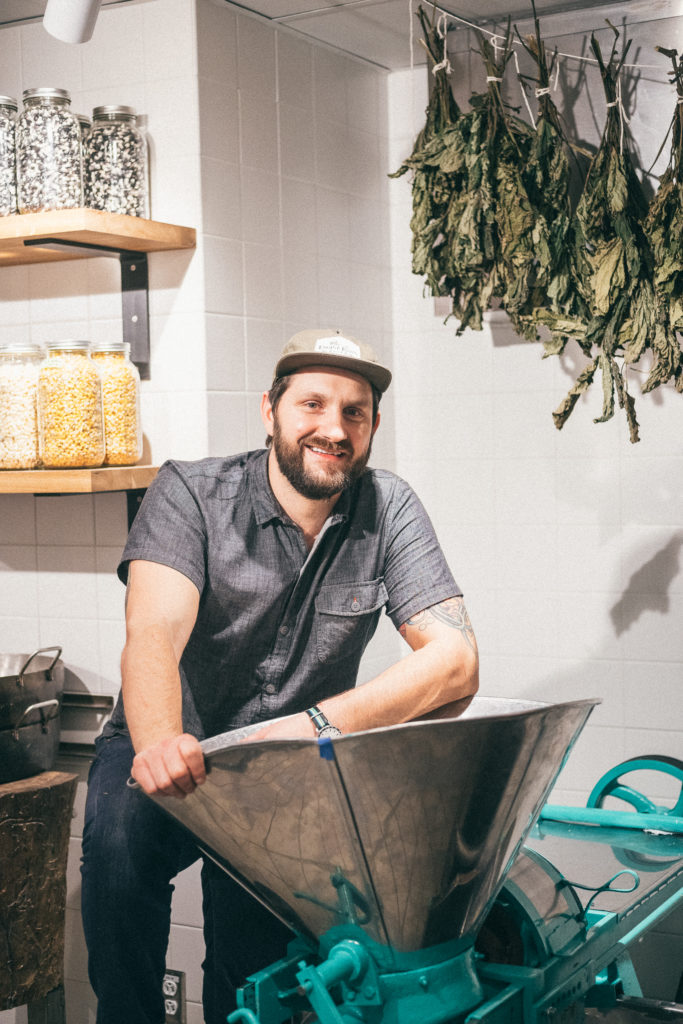 Gabe Erales leaning on the corn grinder in the Dai Due Taqueria kitchen. Photo by Timothy Patrick Clancy.
Gabe Erales leaning on the corn grinder in the Dai Due Taqueria kitchen. Photo by Timothy Patrick Clancy.
Where are you from and how did you get into cooking?
I grew up in El Paso, Texas… west Texas on the border. I got into cooking mostly because of the influence of Mexican cooking from my mom and dad. My family actually came from Mexico in the Yucatan peninsula, Quintana Roo, to El Paso. My mom was always cooking for a big family. I have 5 brothers and a sister, there are 7 of us in total. She was always doing large format style cooking to keep us all fed. One thing that stands out in my mind is she would make cochinita pibil which is something that we have on the menu here. It’s really special to me, it’s a pork braise that is wrapped in banana leaves and cooked in sour oranges, annatto seeds, chiles (it’s bright red), and served with pickled onions and habaneros. We are doing the same thing here but with feral hog. It’s delicious. That kind of stuff, tamales and general Mexican preparations that she grew up eating and feeding to me, really sparked my interested in cooking. Above all, I started working in kitchens when I was 15 because my older brothers were already working in restaurants as their after school jobs. That was my way of making money ever since I started cooking with an exception of a brief period after school… I started as a busboy at Steak and Ale, moved to prep, and worked in restaurants all through high school. I moved to Austin to attend UT and was supporting myself in restaurants while I was studying engineering. I actually have a Bachelors and Masters in mechanical engineering. While I was studying, I was working in restaurants and basically running from school to work, and from work to studying. After I graduated from UT, I was working for General Motors in Detroit doing design. I started really missing cooking and being in the kitchen, so I got back into it and it's kind of been full speed ever since. I've always been doing a million things at once it's always been a good balance for me.
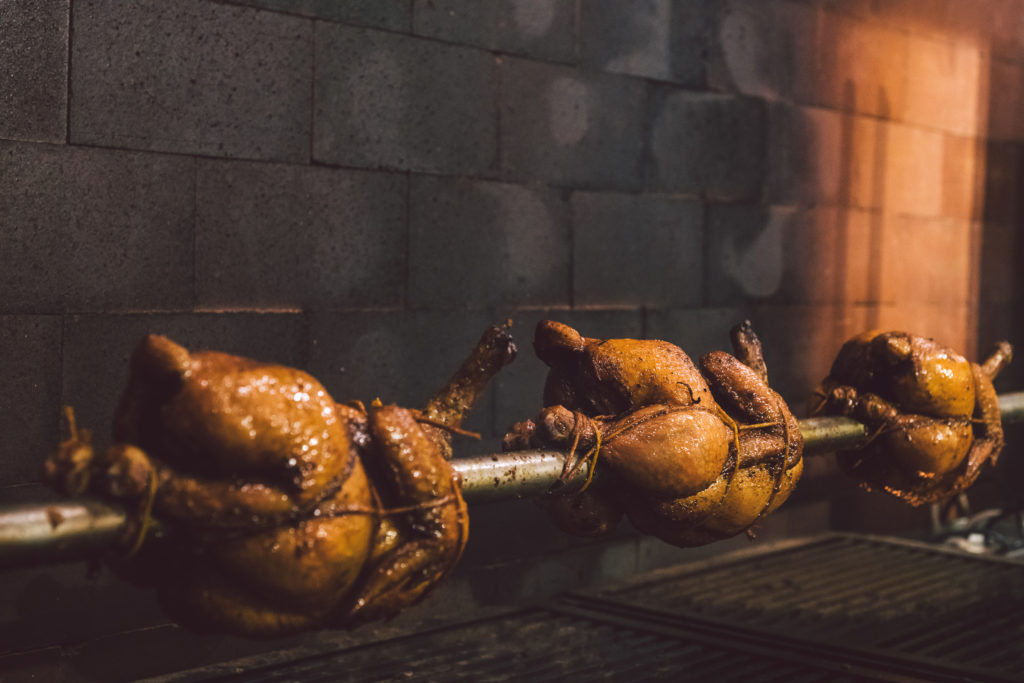 Yummy meats on a spit. Photo by Timothy Patrick Clancy.
Yummy meats on a spit. Photo by Timothy Patrick Clancy.
Where all have you cooked in town?
I've worked at Fonda San Miguel, and that was a really big influence for me because I feel like because they were the institution of Mexican cooking in town. They were probably the first people to do nixtamalization and fresh masa in house daily, which most people use flour maseca… fresh masa in house makes a huge difference. They have incredible moles, and very authentic regional preparations. Miguel Ravago, the founder, owner, and chef, who recently passed away last year, was involved with a lot of really notable chefs and would involve them in his menu. A lot of great chefs have passed through that establishment. Diana Kennedy was always there consulting on moles which is huge, huge, huge. I worked at La Condesa (under Rene Ortiz) which also had a ton of great chefs passing through there as well. Their food is amazing... Rick, who is still the chef there, is doing an amazing job. I worked at Odd Duck and Qui. I helped open Dai Due - the sister restaurant to this Taqueria, and I helped open up the Geraldine’s restaurant in the Hotel Van Zandt (was there for about two years, as sous chef). I left there to go work in the test kitchen for the Noma Mexico team with Rene Redzepi and helped with the menu development in Tulum. When I returned I was focusing on this project, and that’s what I’ve been involved with ever since.
Tell us about your newest project!
Well, this is the Dai Due Taqueria. It’s located in the new FareGround food hall on Cesar Chavez and Congress. There are 6 permanent restaurants here along with a full bar. I'm head chef here. Jesse Griffith obviously is still the chef and owner at both restaurants, but as far as menu and the day to day operations, I'm your guy.
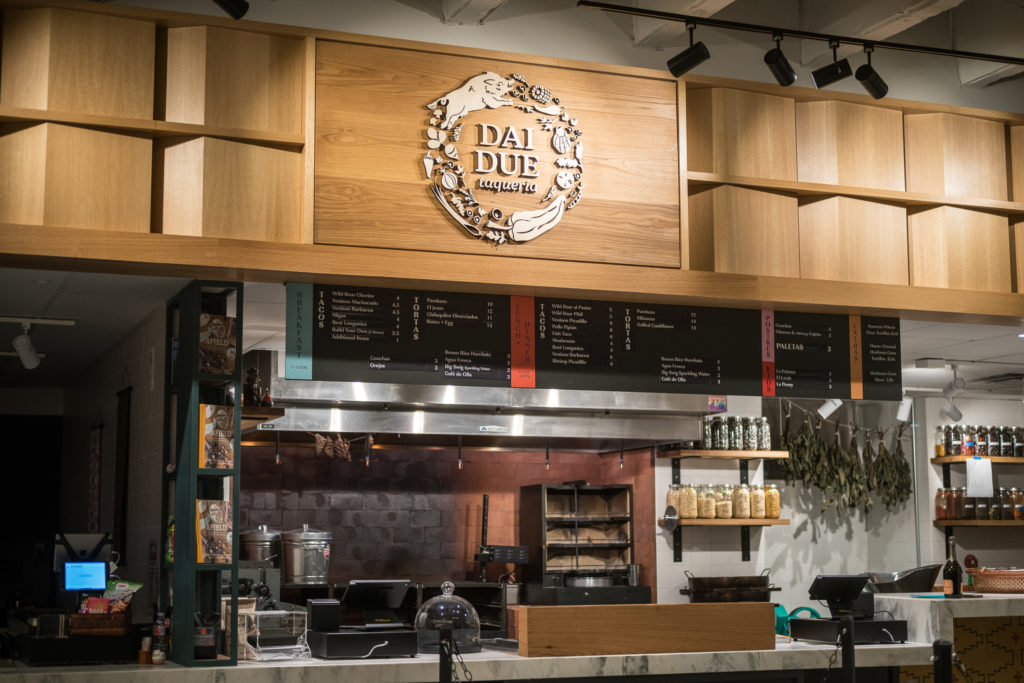 Dai Due Taqueria at FareGround. Photo by Timothy Patrick Clancy.
Dai Due Taqueria at FareGround. Photo by Timothy Patrick Clancy.
What item are you most excited about on your menu?
There are two things. Number one is the trumpo, it’s the meat over there that looks like a gyro meat. We call it the trompo al pastor. It's very special because we're cooking over Texas charcoal, which a friend of mine makes here in town. The actual meat is wild boar, it's been brined and marinated. I think everyone loves an al pastor taco, so this is really, really special. Also, there's a torta called a pambazo. It's essentially a torta bread that's been dipped in very spicy chili broth. We take bone broth and infuse it with a lot of chiles. It's really bright red and really thick with a lot of body, kind of like a ramen broth. Then we get the torta, and fill it with wild boar chorizo, potatoes, avocado, and cheese. All of that gets melted together, then dipped in that broth, and then regrilled on a flat top. It’s this bright red sandwich that's crispy, has some char marks, and when you bite into it you get this really nice crispy cabbage and radish taste, too. It’s a very Mexico City style torta. I've yet to see one of those in the city here in Austin so I'm really excited that we're kind of introducing our version of it to people.
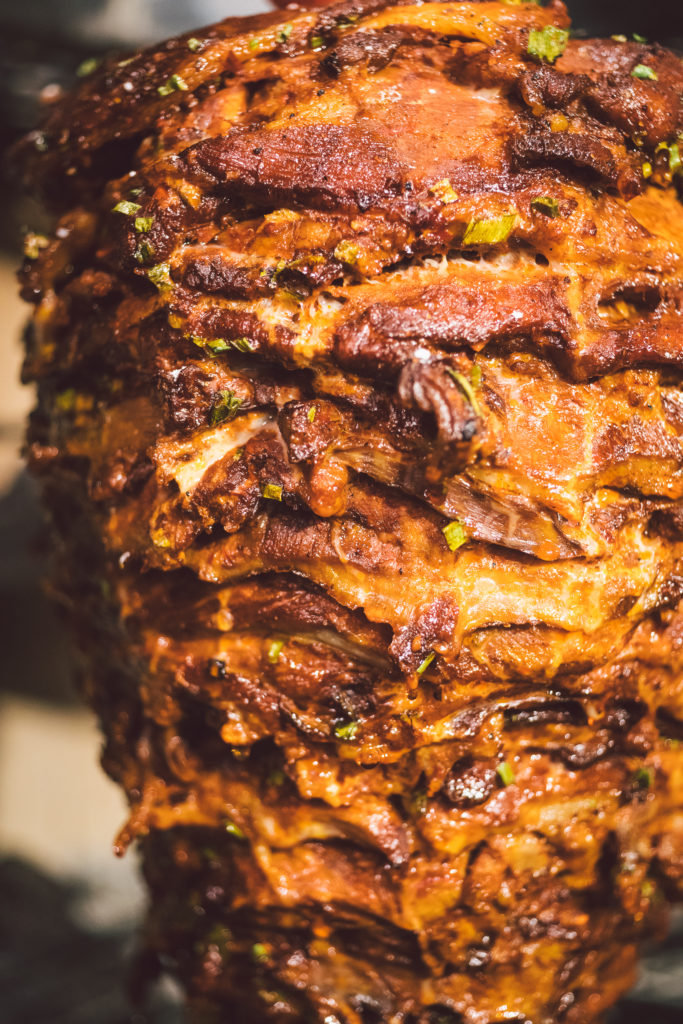 The trompo meat. Photo by Timothy Patrick Clancy.
The trompo meat. Photo by Timothy Patrick Clancy.
What is the most surprising thing about working with farms?
I think the most surprising thing to me is that for the longest time people just accepted what was sold. You go to the farmers market, there's carrots, cabbage, cauliflower, garlic, and onions… and you worked with that. However, the relationship between the farmer and the chef has grown so much. Now we partner together, I tell a farmer what I want for my menu, and then they in turn buy seed and try to grow ingredients accordingly. People are growing stuff that you would have never seen grown in Texas previously! There's a girl here in town who's growing extremely rare chiles, chihuacles, and those are even rare in Mexico. So, for them to be grown in Austin is mind-blowing and exciting. I'm working with other people here that are growing some special Mexican herbs, and I have stuff that I brought back from Mexico, a wild mexican spinach.
Tell us about your relationship with JBG?
My first introduction to local farmers was through Johnson's Backyard Garden, back when y’all were extremely small. Brent was at all the Farmers Markets himself, and hosting everybody on the farm very often. So, that's why I still do business with JBG... it's really special to me, and I think a lot of the product is just really amazing. Y’all have grown so much - I hear you deliver to Houston, Dallas, San Antonio… wild.
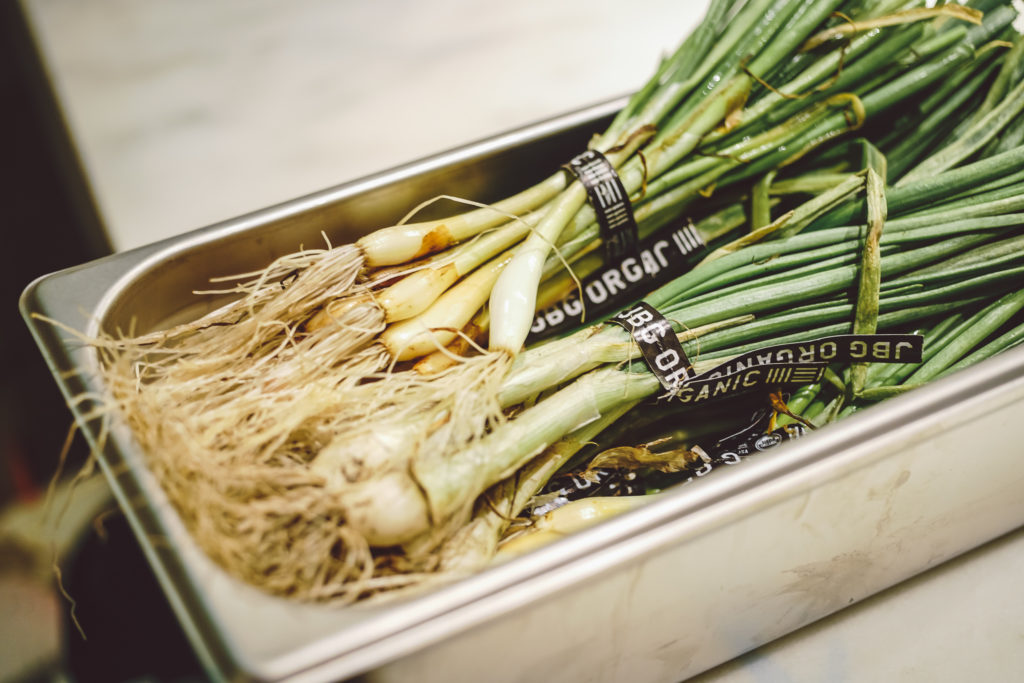 JBG produce in the kitchen. Photo by Timothy Patrick Clancy.
JBG produce in the kitchen. Photo by Timothy Patrick Clancy.
What is the most difficult part about working with farms and sourcing locally?
The most difficult part is the commercial and logistical side of things. People like Farm to Table have changed the game in that it's a one stop shop. You can call them and be like, “I need beets,” and if you have a good relationship with them then they'll send you the best unless you tell them you want some of the cheapest beets they have, and they send you that. It’s a one stop shop, so you aren’t calling 6 different farmers. You aren’t worried about if and when the farm is going to deliver, but on the same token you're paying a premium, so food cost is a big issue. You have to take the extra effort to call all five different farmers instead of just getting the consolidated service from Farm to Table. With farms, schedules and availability can be an issue. It’s first come, first serve, and sometimes when you are planning a menu around a certain veggie and something happens with the harvest or they sell out it can be difficult. However, if you go directly to the farm you’re going to get a better product. There's a lot of farmers that just don't deliver, too, but have amazing product. In a day-to-day operation, it's really hard to break free and go pick up veggies at a farm. You can't really do that all the time… but, there are people who do that in town! Barley Swine’s kitchen goes to the farmers market every Saturday religiously. I admire Bryce and Mark for doing that. It's amazing and there's a special intimacy there. It's hard for everyone to be on that level after long hours the night before in the kitchen.
How do you decide where to source from?
It's always going to be a balance of quality and price. So, if I am using a product that's going to be the showcase of the dish or the meal, then I'm obviously going to be willing to pay a little more premium on a product. If it's something that's going to be cooked and blitzed into a sauce or a garnish that doesn't need to be as robust of a flavor, then you don’t need to spend as much. It's just a give and take. You have to evaluate what the food cost of a plate is versus overall food cost in general, and how much more of a return on your investment you're going to get. If I were to buy Johnson's sweet potatoes versus Tecolote’s, how much better is the flavor for an extra 50 cents? It also depends on availability. I like to provide loyalty to farms, too. If Johnson’s is taking care of me and is always on time, I’m going to keep my commitment to support them. It’s always a relationship, and I feel like in this day and age there are so many farmers that take it really personally. In this day of social media, people’s feelings can really get hurt if you get, let’s say carrots, from someone else. You gotta tread lightly.
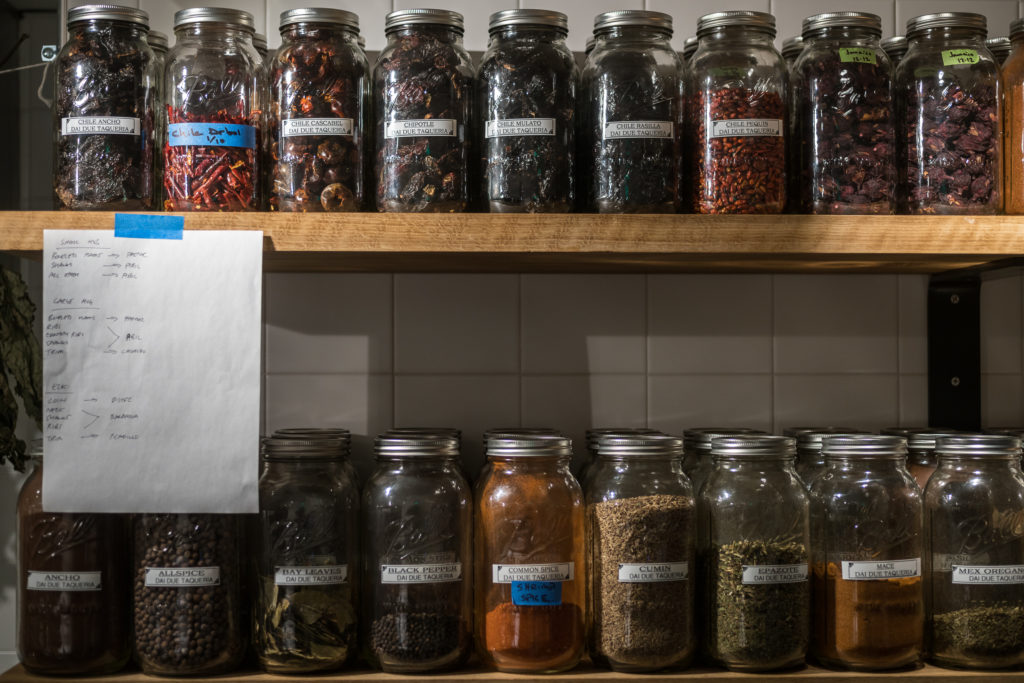 Spices at the Taqueria. Photo by Timothy Patrick Clancy.
Spices at the Taqueria. Photo by Timothy Patrick Clancy.
What is the best part about working with local farms?
Obviously, I feel like the sustainability aspect and the return to the community. It's a closed loop cycle. It's really great to have the same farmers that are delivering your food be the same people you're feeding. You get to know their family and their kids, and it goes back to the intimate relationship of working with them and them growing special ingredients for you. Going through US Foods or Sysco, I guarantee you're never going to meet the face of where your product comes from. You don’t know what they’re going through to grow that product or how much care is going into that product. So, I feel like to understand the relationship and intimacy of the farm and how it’s being raised is really special. Same thing goes for animals, too. We use feral hog on the menu because it’s delicious, but also an invasive species. The Spanish brought these pigs hundreds of years ago, and they eventually procreated and took over Texas along with other parts of the country. They cause hundreds of millions of dollars of damage to farms, urban residences, and cemeteries all over the place. They are called wild boar, a little misleading, they are actually out in the wild; however, after they are trapped and killed, they are inspected. It’s not like Jesse goes out and hunts feral hog and just brings it in and throws it on the grill... people actually ask that all the time. He’s an amazing hunter and goes often, but he doesn’t kill these hogs. It’s all about sustainability, there’s tons of feral hog and they are delicious. They love acorns, and it adds this nice malty, nutty flavor to the protein that we cook, too.
Is there anything that you think our readers would be surprised to know about day to day in the kitchen?
The amount of technique that goes into making a taco. I feel like the community's been so inundated with, and not to take anything away from Taco Deli or Torchy's, places that pump out a lot of tacos everyday. You go and wait in line and get your tacos ten minutes later, not to say they're not good, but I don't think the amount of technique and care that's going into making those is on the same level of what we're doing here. We're bringing in Mexican heirloom corn that gets cooked, ground, and made into fresh tortillas daily. It's a lot different than having a truckload of tacos dropped off, and you just reheat them. In my opinion, a taco is only as good as the tortilla it’s served on. You can have a delicious filling, but if the tortilla that’s holding it together is falling apart… it’s not that great. The taco was founded on corn, and that’s the backbone of it all. So we really prize ourselves on our masa program. Day to day, the amount of technique that goes into the sauces, the meat, the butchery… everything.
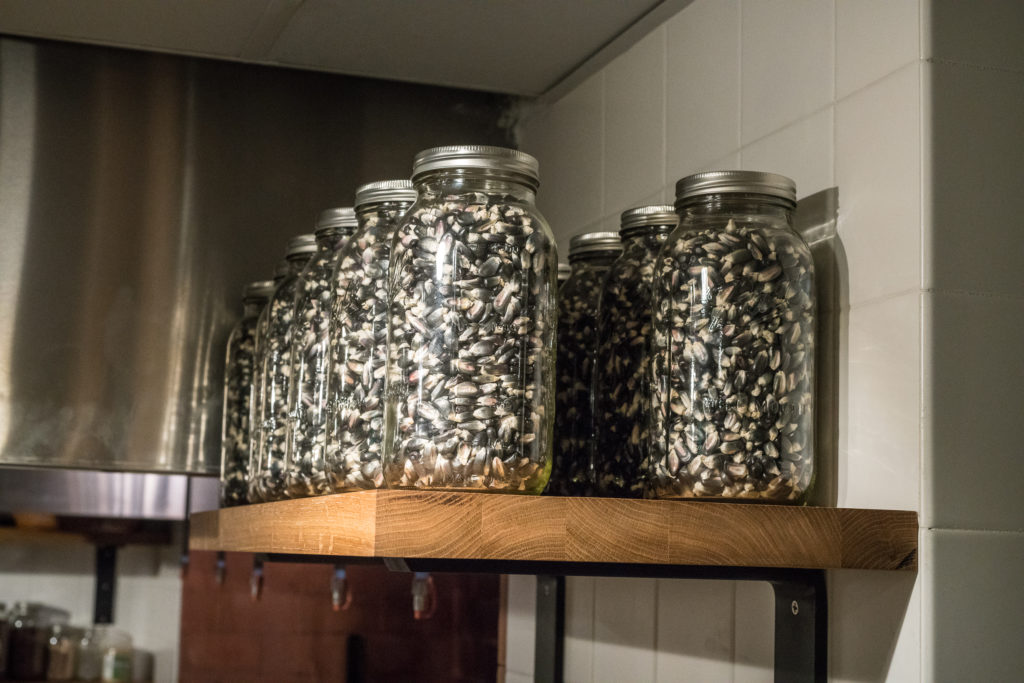 Heirloom corn. Photo by Timothy Patrick Clancy.
Heirloom corn. Photo by Timothy Patrick Clancy.
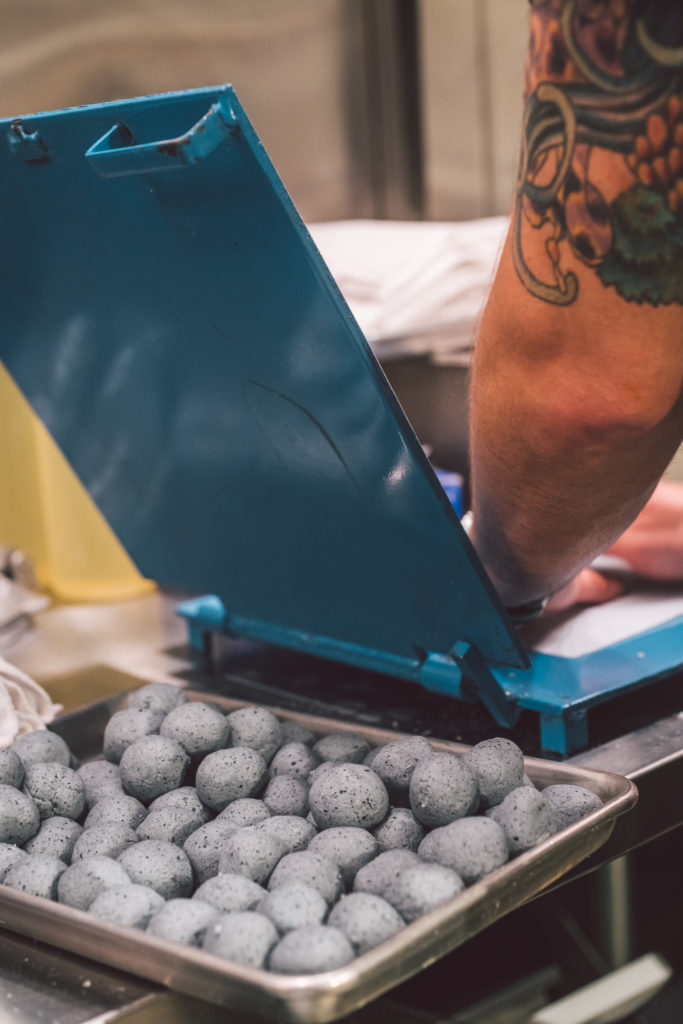 Tortilla making process. Photo by Timothy Patrick Clancy.
Tortilla making process. Photo by Timothy Patrick Clancy.
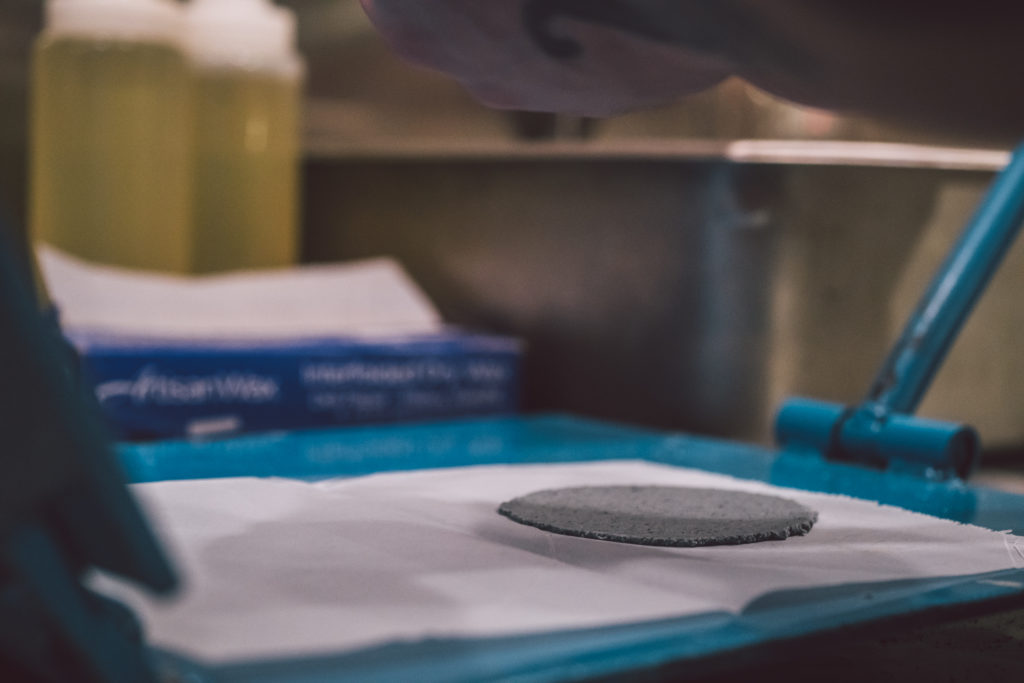 Tortilla making process. Photo by Timothy Patrick Clancy.
Tortilla making process. Photo by Timothy Patrick Clancy.
What’s your favorite vegetable to work with and least favorite?
Easy - I love chiles. I grew up eating chiles with my parents influence. Even as a kid I was eating raw habaneros macerated in lime and salt. Cooking with chiles is really special to me. I love carrots, and I really love corn obviously. It’s also really special to me, and I relish all the different ways it’s used. My least favorite is dandelion greens. I’ve tried cooking them tons of different ways, but they are just a little too bitter for me.
What advice would you give to a home chef who is trying to learn to cook with more seasonal vegetables?
I would say go to the farmers market and pick up something you have never cooked with before. Get on the internet and use it as a resource or use food magazines, like Bon Appetit and Food & Wine. They always have a lot of the latest food recipes and trends for seasonal vegetables. There's a lot of creative stuff that their staff puts together for recipes... it's really inventive and delicious. For savory cooking it doesn't need to be quite as accurate, and you can improvise a lot more. Be adventurous!
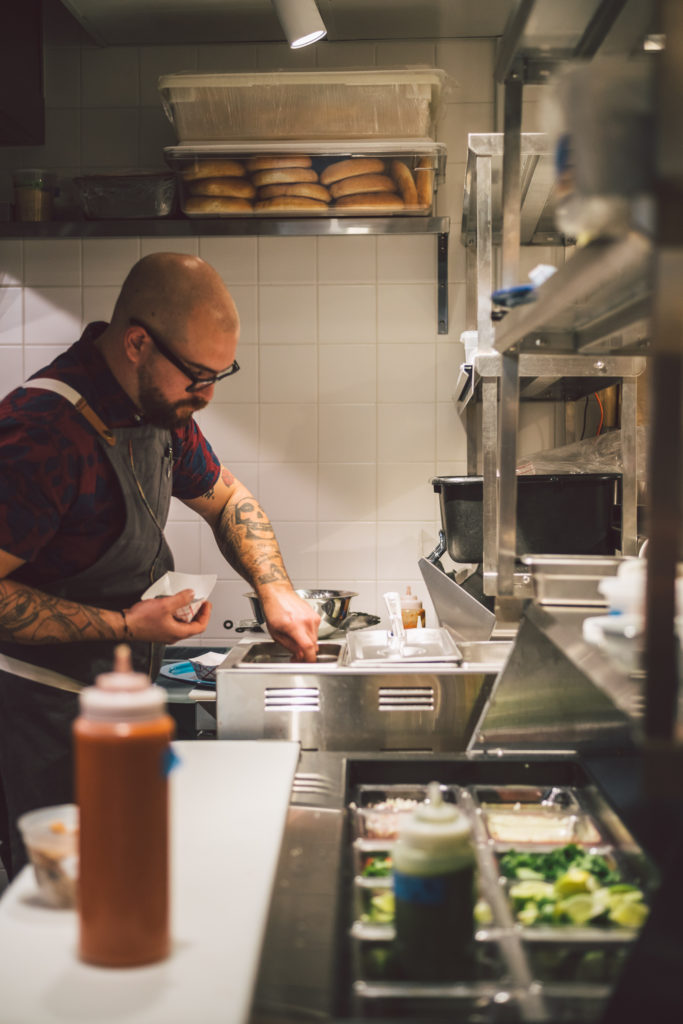 Kitchen scenes at the Taqueria. Photo by Timothy Patrick Clancy.
Kitchen scenes at the Taqueria. Photo by Timothy Patrick Clancy.
Any quick recipe or technique you’d like to share with our readers (with something in season)?
I really think right now sweet potatoes are really, really delicious. Something that we're doing on our cochinita pibil taco is pickling them fresh. So, since we don't have red onion right now, we're using sweet potatoes, julienned fresh and then pickled with chile piquin. That pickled sweet potato goes as a garnish on the taco, and it makes an amazing pickled item. My Sous chef, Mike Diaz, came up with the idea. Give it a try!
A huge thank you to Gabe Erales for taking the time to speak with us this week and Timothy Clancy for the amazing photos! Find more photos on his site or on his Instagram.
WEEK 3 IN PHOTOS
01/19/18 — Heydon Hatcher
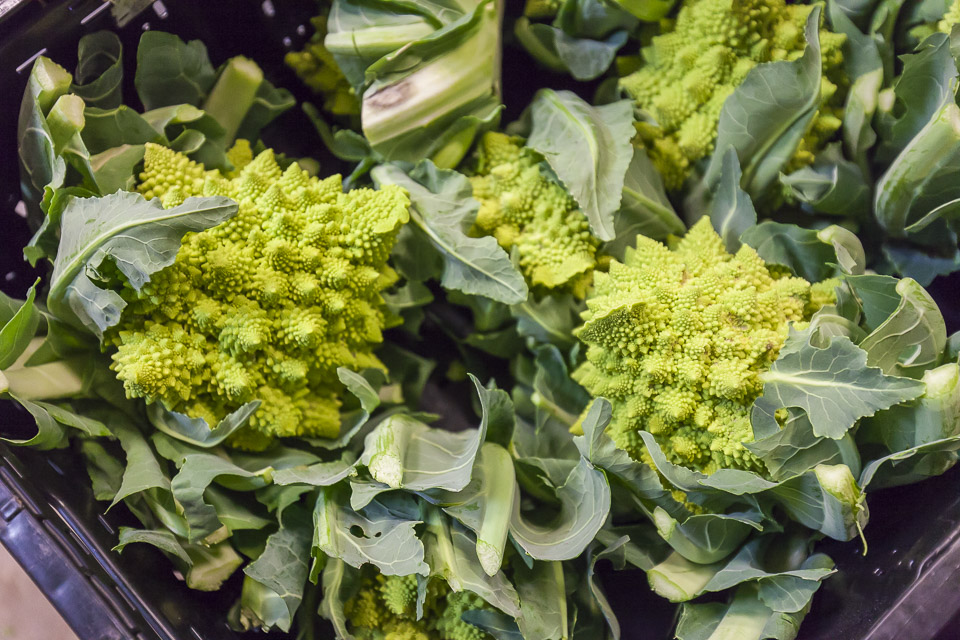 Romanesco. Photo by Scott David Gordon.
Romanesco. Photo by Scott David Gordon.
This week was COLD. Everyone pitched in on Monday to harvest before the freezing weather arrived. We banded together and worked until dusk, and gathered enough veggies for the rest of the week. Then the harvest crew took off Tuesday and Wednesday, while the packing crew continued cruising through their work even on the freezing snow day! Damage-wise, looks like the veggies fared alright! Stay warm and see you at the markets this weekend!
 Packing crew braving the cold. Photo by Scott David Gordon.
Packing crew braving the cold. Photo by Scott David Gordon.
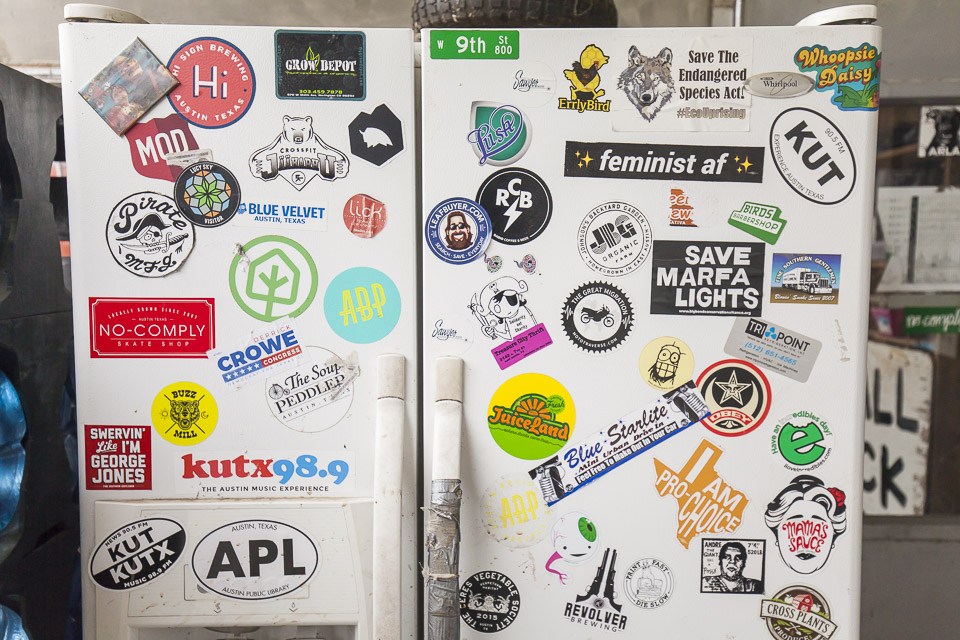 OIur barn fridge filling up with stickers. Photo by Scott David Gordon.
OIur barn fridge filling up with stickers. Photo by Scott David Gordon.
 Frozen grill on the delivery vehicle. Photo by Scott David Gordon.
Frozen grill on the delivery vehicle. Photo by Scott David Gordon.
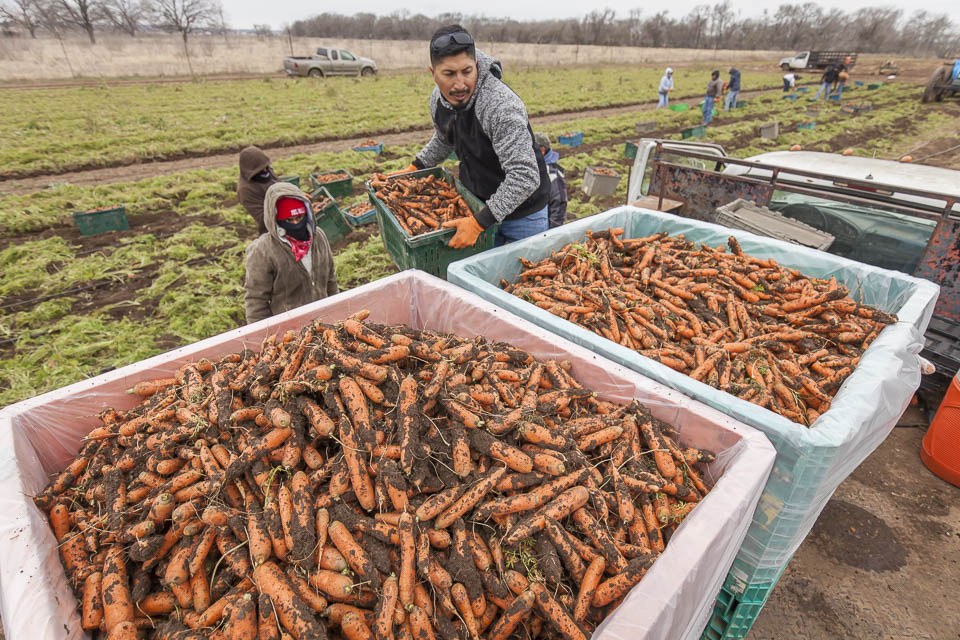 Harvesting carrots on a freezing cold day. Photo by Scott David Gordon.
Harvesting carrots on a freezing cold day. Photo by Scott David Gordon.
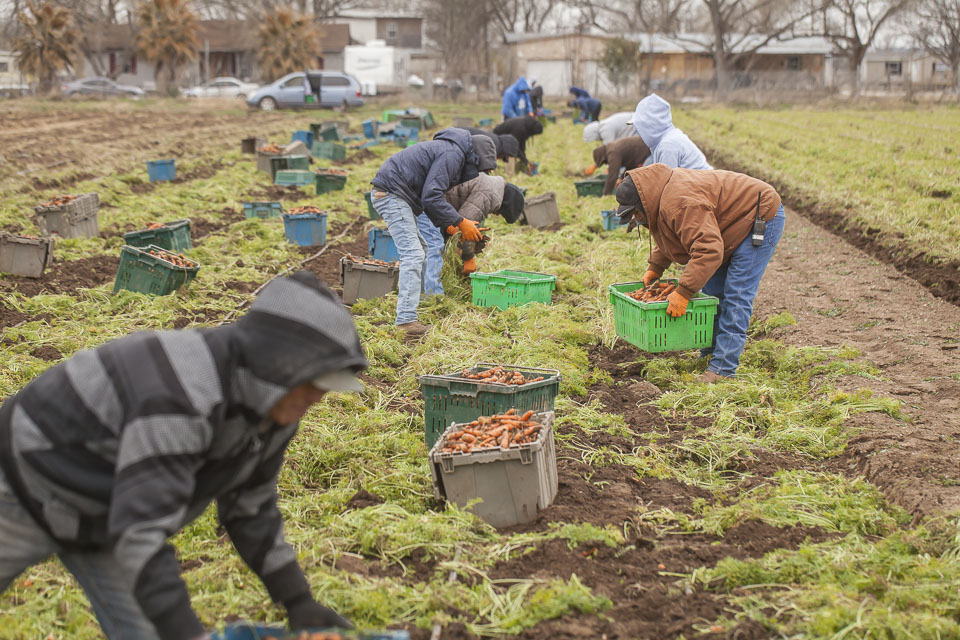 Everyone harvesting carrots since everything else is too frozen. Photo by Scott David Gordon.
Everyone harvesting carrots since everything else is too frozen. Photo by Scott David Gordon.
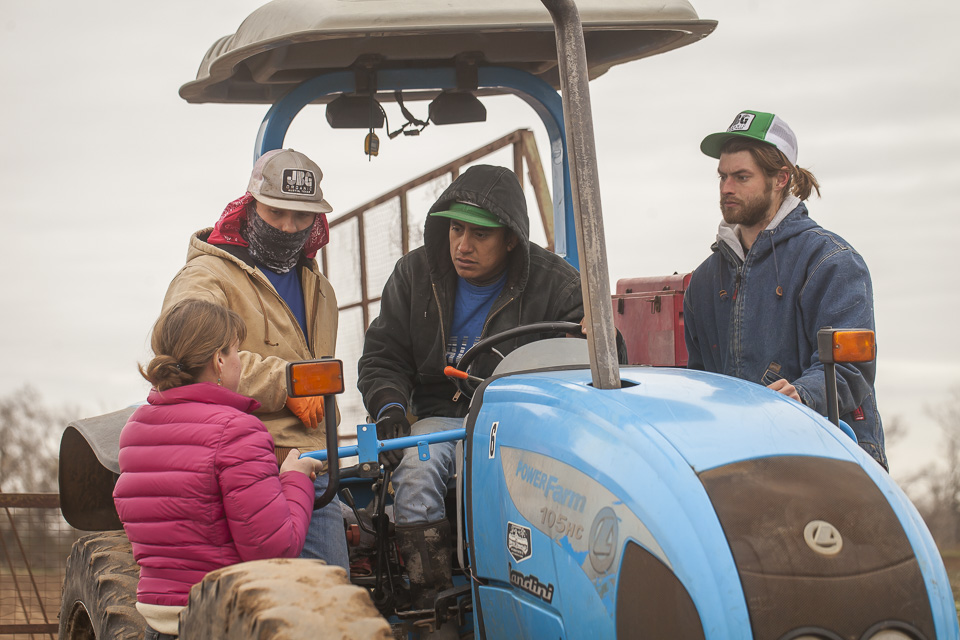 Farm meeting. Photo by Scott David Gordon.
Farm meeting. Photo by Scott David Gordon.
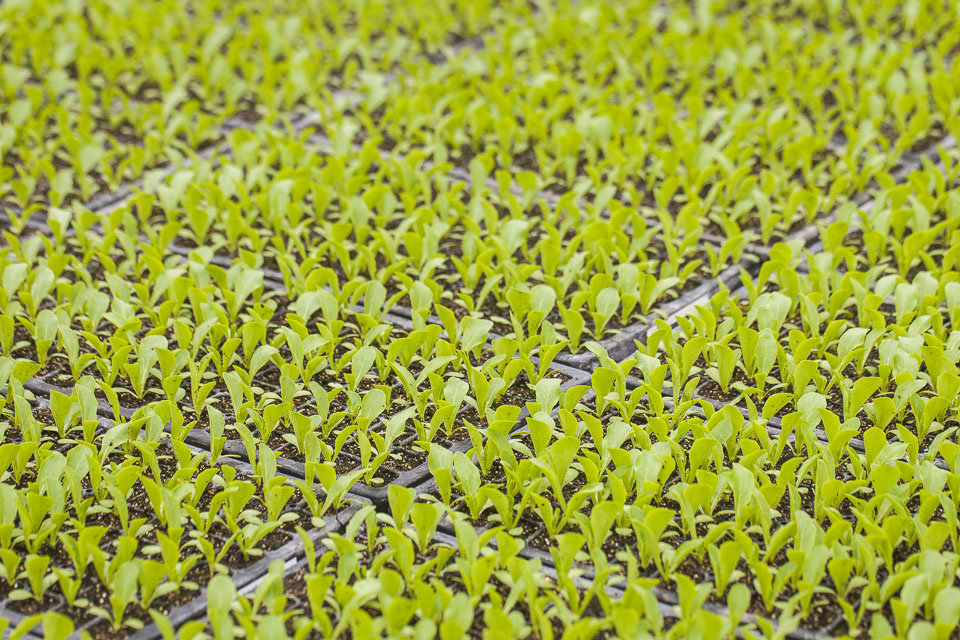 Transplants. Photo by Scott David Gordon.
Transplants. Photo by Scott David Gordon.
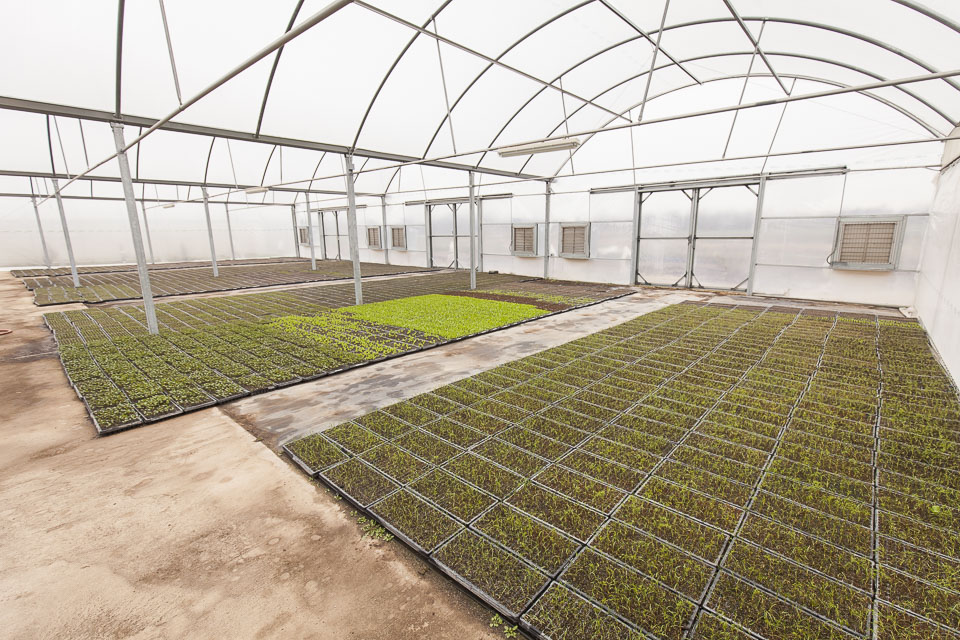 Tons of transplants in the greenhouse. Photo by Scott David Gordon.
Tons of transplants in the greenhouse. Photo by Scott David Gordon.21 REASONS TO JOIN (OR RE-JOIN) OUR CSA THIS FALL
01/19/18 — Heydon Hatcher

This week we sat down and listed a handful of reasons why you should sign up for a CSA with us! Are you a lapsed CSA member? Maybe it's time to ponder re-joining us! We miss you! With the influx of delectable leafy-green-heavy crops and spring right around the corner, 'tis the season to join our farm community and get yourself a CSA share!
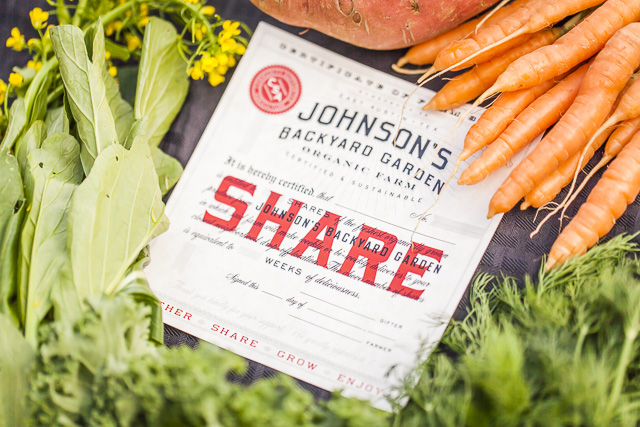 Photo by Scott David Gordon.
Photo by Scott David Gordon.
1. SUPPORT LOCAL
By joining our CSA, you are supporting a locally owned and operated business. Buying local helps our economy as well as supply jobs and support the livelihood of fellow Austinites. Unique local businesses are part of what makes Austin and Texas so special!
Our CSA can augment your regular weekly shopping list, ensuring that you have some of that scrumptious local produce in your diet, too! A little goes a long way!
2. Good for your Health
Farm-fresh vegetables are jam packed with vitamins and minerals that are essential to maintaining a healthy lifestyle. Two and a half cups a day says the FDA? Ain’t no thang with a CSA headed your way.
3. Freshest-Possible Veggies
Cultivated in East Austin and harvested no more than a day or two before reaching your doorstep, these vegetables are at peak nutrition and flavor. Getting a CSA share with JBG means you know exactly where your food is coming from and how it's grown. GMO? Heck no! Come out for a volunteer day, see your crops in the field, and ask your farmers about it!
 Photo by Scott David Gordon.
Photo by Scott David Gordon.
4. Know your Seasons
Eating locally connects you to the seasons, to the land, and to your own health and wellness. Cucumbers will cool you down in the summer, while braised collards will warm you up when the temperatures start to drop. Enjoy the best pico de gallo of your life during the short window when cilantro, onions, peppers, and tomatoes all overlap, and we promise you'll never go back to the store-bought stuff again. You'll get acclimated with the seasons on a whole new level, and learn about what naturally grows when and why.
5. Try New Foods
With farmers who are constantly chompin’ at the bit to try a new crop, who knows what will show up in your CSA box. From the array of Asian greens to the broad pepper spectrum, keep your mind wide open to a whole new world of vegetables you never even knew existed.
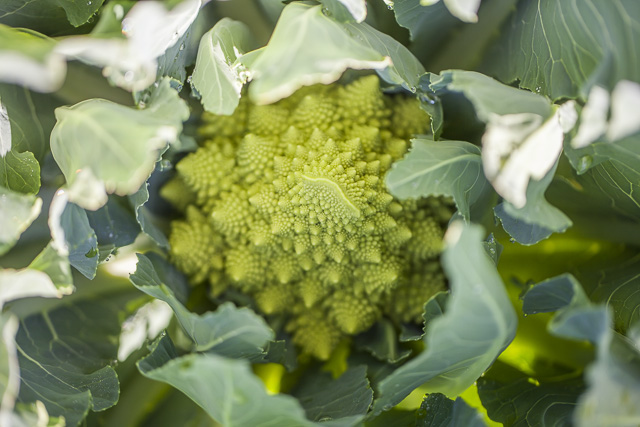 Photo by Scott David Gordon.
Photo by Scott David Gordon.
6. Experiment in the Kitchen
With JBG veggies arriving every week, you will have to innovate in the kitchen. Get out of your comfort zone and try something new!
7. Protecting our Environment
By supporting JBG, you are ensuring sustainable land management, and organic certification guarantees that we never spray harmful chemicals on the farm.
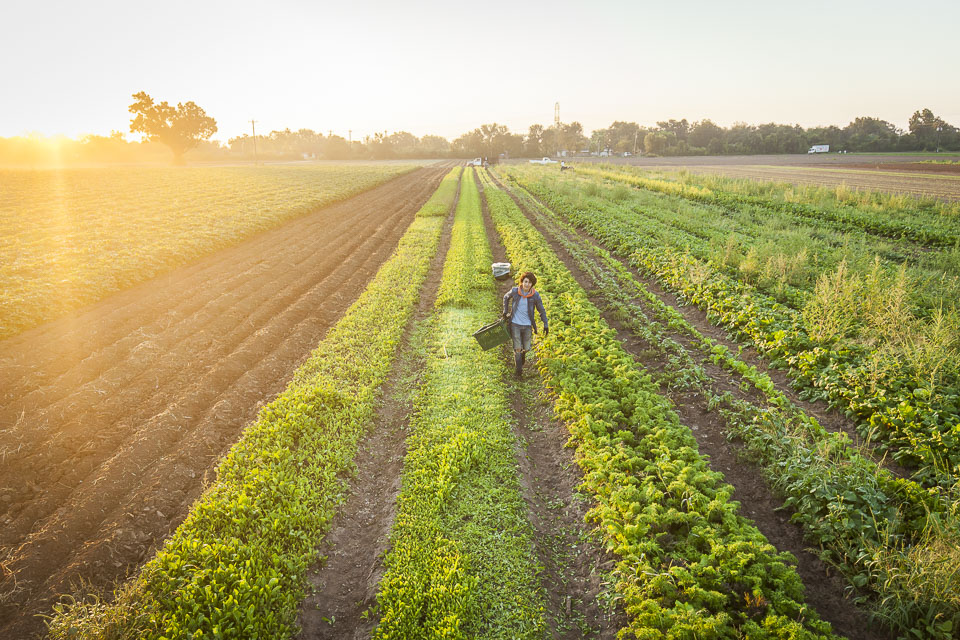 Photo by Scott David Gordon.
Photo by Scott David Gordon.
8. Reduce Food Miles
It's estimated that the average American meal travels over 1500 miles before making it to a dinner plate. With all of that fuel, even a plant-based meal might not be so eco-friendly. We do wave at the planes going by, though, our farm is just 10 miles east of the Austin-Bergstrom airport!
9. Flexibility
Gone on vacation for a week or a month? No problemo, we make it super easy to postpone your weekly deliveries. Got a big family, or just feeding yourself? We have 4 different box sizes that cater to your lifestyle. JBG also offers add-ons of local eggs from pasture-raised hens, and small batch locally roasted coffee as well. Customize your box with your favorite veggie and ditch the ones you aren’t keen on.
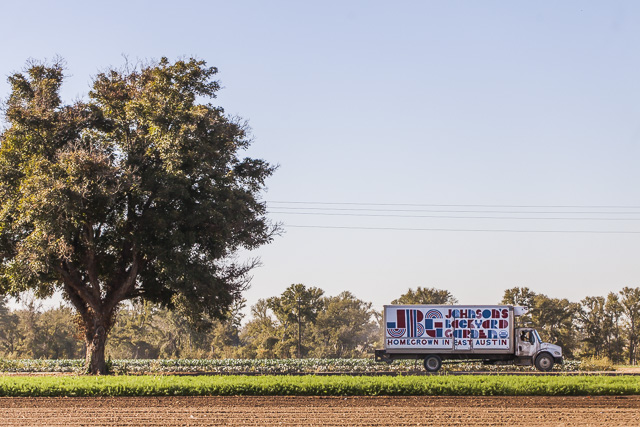 Photo by Scott David Gordon.
Photo by Scott David Gordon.
10. Get involved with our CSA Community
With member-only dinners, happy hours, plant sales, cooking classes, yoga + races at the farm, PYO-events, we really emphasize the “C” of CSA. We want the farm to connect awesome people, whether at one of the aforementioned events or at your community pick-up site! Speaking of exclusive farm events, be on the lookout for our Spring Transplant Sale and Picnic!
11. JBG on the WWW
On our website, you can stay current on farm events, sign up for our weekly newsletter, grab storage tips from our veggie guide, check out the weekly CSA content list, peruse weekly photo-updates from the field, and check out our recipe blogger’s latest CSA culinary exploration.
12. Farm Community on the WWW
If our website isn’t enough, our CSA community loves sharing how they innovate with their veggies on social media outlets. Check out our Instagram or FB, we love re-posting awesome recipes, photos, and videos from the community. Running low on recipe ideas, and want to see what other folks are doing with our produce? Check out our jbgorganic hashtag!
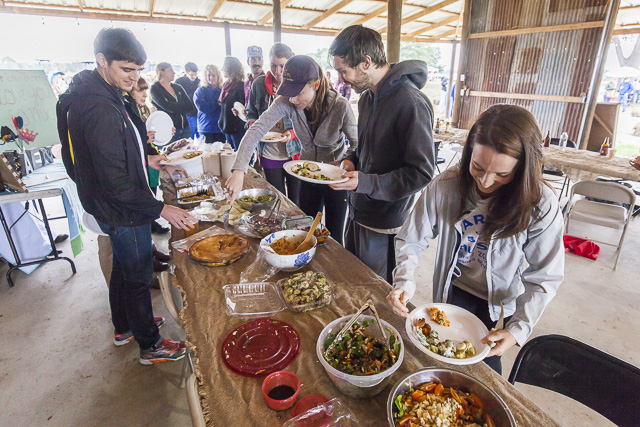 Potluck. Photo by Scott David Gordon.
Potluck. Photo by Scott David Gordon.
13. Farm Access
Located on the Colorado River, JBG’s 200 acres of verdant crops and brilliant blooms are often otherworldly. As a CSA member, you will have access to our little oasis of wilderness whether it be at a JBG CSA event, or through volunteering!
14. Know your Farmers
Montana seeds the crops, Ada champions our marketing efforts, Brenton and Charlotte manage the fields, Krishna crunches numbers, Matt and his crew carefully pack every single CSA box... we love our people, and think you will, too. Come and meet us, we are regular Austin folks, just like you.
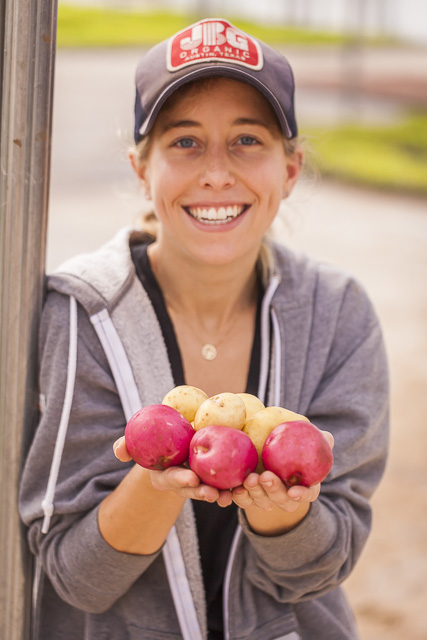 Charlotte. Photo by Scott David Gordon.
Charlotte. Photo by Scott David Gordon.
15. Farmers Markets
If you pick up at one of our many farmer’s markets, you have the ability to switch out veggies that you aren't fond of with the bounty we offer at our FM stands. Pretty cool, right? On top of that, it’ll get you outside interacting with people, and who knows what hip and healthy folks you’ll meet!
16. Farmers Market Staff
Our FM staff is the best in the biz (okay, okay, we are super biased), but seriously, introduce yourself! They know all the veggie hacks, hail from all over the place, and have all kinds of talents and alter-egos. Artists, teachers, law students, musicians, dreamers, writers, you name it! Bop on by and learn something new while browsing through our market crops!
17. Feed Those in Need
Thanks to the support of our CSA members, JBG is able to donate thousands of pounds of produce every year to large operations like SafePlace, Central Texas Food Bank, as well as grassroots efforts like Nubian Queen Lola who are all helping to keep Austin’s hungry, nurtured and fed.
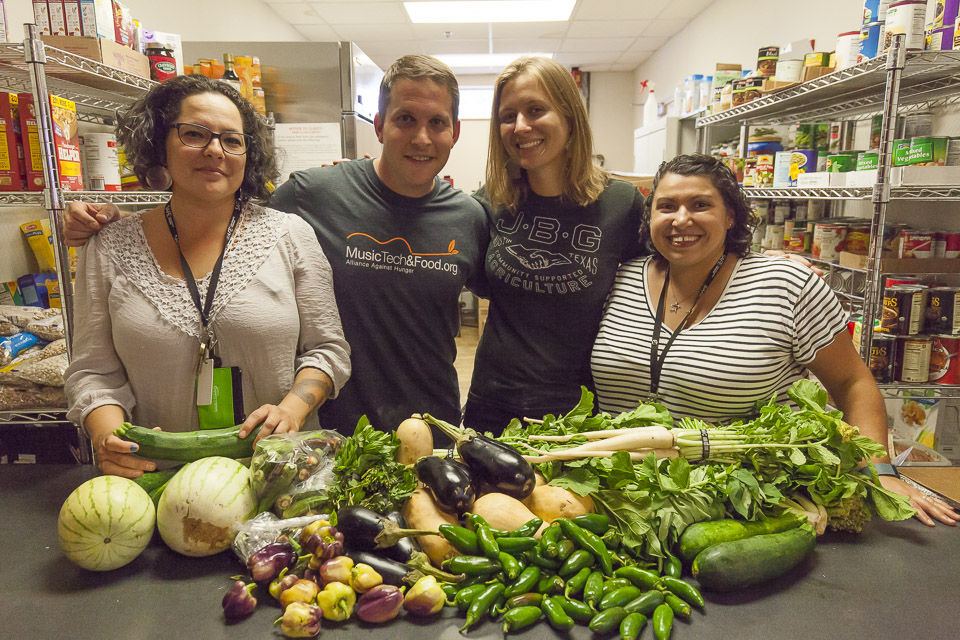 SafePlace. Photo by Scott David Gordon.
SafePlace. Photo by Scott David Gordon.
18. WACKY and WONKY FRUITS and VEGGIES
19. JBG hats
Reppin’ on your head but not on your plate? Add some JBG veggies to your diet and see what we’re all about.
20. FOOD MAIL!?
In a world where the fast-paced, high tech lifestyle seems ubiquitous, who doesn’t love a box full of veg-surprises on your doorstep?! It’s like food snail mail! We sometimes even leave little personal notes about what's going on with the crops and/or upcoming events!
21. Farm Work-out Videos!
Eat healthy AND get movin'! Check out more of the actual video here.#tbt to the glorious day, about a year ago, when Erica Nix and her amazing flock jazzed up the farm.
A photo posted by Johnson's Backyard Garden (@jbgorganic) on
Think you know a friend who needs some reasons to join the CSA? Please consider sharing this article with them!
***Contributions by Nellie Stephenson + Ada Broussard
CSA BOX CONTENTS WEEK OF JAN 22ND
01/23/18 — Scott
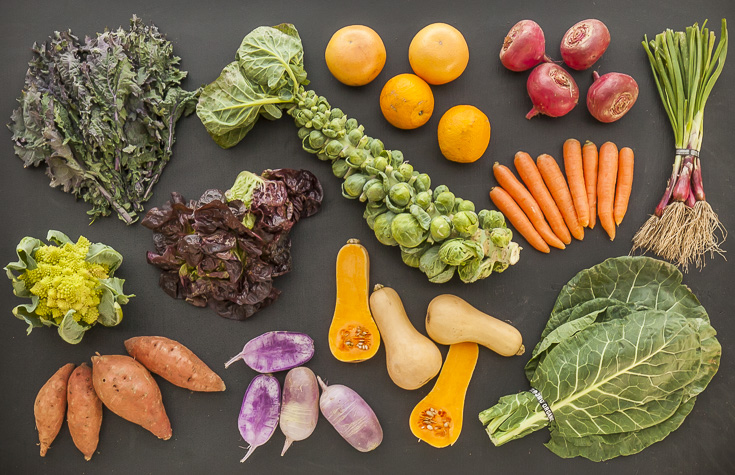 CSA Box Contents Week of Jan 2nd
CSA Box Contents Week of Jan 2nd
Large Box
Brussels Sprouts
Carrot, Orange
Cauliflower
Citrus, Mixed
Greens, Collards
Greens, Kale, Curly
Lettuce, Romaine
Onion, Spring Red
Potato, Sweet
Radish, Purple Daikon
Squash, Butternut
Turnip, Scarlett
Brussels Sprouts
Carrot, Orange
Cauliflower
Citrus, Mixed
Greens, Collards
Greens, Kale, Curly
Lettuce, Romaine
Onion, Spring Red
Potato, Sweet
Radish, Purple Daikon
Squash, Butternut
Turnip, Scarlett
Medium Box
Carrot, Orange
Citrus, Mixed
Greens, Collards
Greens, Kale, Red
Lettuce, Romaine
Onion, Spring Red
Potato, Sweet
Radish, Purple Daikon
Squash, Butternut
Carrot, Orange
Citrus, Mixed
Greens, Collards
Greens, Kale, Red
Lettuce, Romaine
Onion, Spring Red
Potato, Sweet
Radish, Purple Daikon
Squash, Butternut
Small Box
Garlic, Green
Greens, Collards
Greens, Kale, Curly
Kohlrabi, Purple
Lettuce, Romaine
Potato, Sweet
Turnip, Rutabaga
Garlic, Green
Greens, Collards
Greens, Kale, Curly
Kohlrabi, Purple
Lettuce, Romaine
Potato, Sweet
Turnip, Rutabaga
Individual Box
Broccoli
Greens, Collards
Lettuce, Romaine
Potato, Sweet
Turnip, Scarlett
Broccoli
Greens, Collards
Lettuce, Romaine
Potato, Sweet
Turnip, Scarlett
CSA BOX CONTENTS WEEK OF JAN 22ND
01/23/18 — Scott
 CSA Box Contents Week of Jan 2nd
CSA Box Contents Week of Jan 2nd
Large Box
Brussels Sprouts
Carrot, Orange
Cauliflower
Citrus, Mixed
Greens, Collards
Greens, Kale, Curly
Lettuce, Romaine
Onion, Spring Red
Potato, Sweet
Radish, Purple Daikon
Squash, Butternut
Turnip, Scarlett
CABBAGE RICE WITH TOMATOES
01/24/18 — Heydon Hatcher
Recipe and Photo by Megan Winfrey
During the colder months, cabbage becomes a staple in our CSA boxes. Week after week, I find myself trying to figure out a new way to use it. There's just SO MUCH OF IT!
On one of those nights when the fridge was practically empty, I plugged what I had into Google. "Cabbage and rice side dish." (yes, the fridge was that empty)
I found a recipe from Amy on the "All Recipes" page that I could work with. It sounded a little bland, so I spiced it up a bit and let me tell you - I'll be making this and variations of it on the regular.
You can substitute basically any spice or marinade mixture and add the gamut of diced veggies to the versatile side dish. Cabbage and rice are such a clean palate, you could really take this dish in almost any direction!
I haven't been this excited about cabbage since I mastered my sauerkraut recipe.
Cabbage Rice with Tomatoes![]()
Start by bringing the water to a boil in a saucepan. Add the rice and butter then stir, cover, and lower to a simmer. Allow the rice to cook for 15 minutes or until the water is absorbed. Remove the rice from the heat but leave covered.
In a large pot, heat the olive oil over medium high. Add the onion and garlic and cook until fragrant, about 3 minutes. Add the cabbage, vinegar, and spices and cook, stirring occasionally, for about 10 minutes.
Once the cabbage is cooked down, mix in the tomatoes and cooked rice. Combine well and serve. I served mine with braised short ribs and gravy.
During the colder months, cabbage becomes a staple in our CSA boxes. Week after week, I find myself trying to figure out a new way to use it. There's just SO MUCH OF IT!
On one of those nights when the fridge was practically empty, I plugged what I had into Google. "Cabbage and rice side dish." (yes, the fridge was that empty)
I found a recipe from Amy on the "All Recipes" page that I could work with. It sounded a little bland, so I spiced it up a bit and let me tell you - I'll be making this and variations of it on the regular.
You can substitute basically any spice or marinade mixture and add the gamut of diced veggies to the versatile side dish. Cabbage and rice are such a clean palate, you could really take this dish in almost any direction!
I haven't been this excited about cabbage since I mastered my sauerkraut recipe.
Cabbage Rice with Tomatoes
- 1 head cabbage, cored and shredded
- 1 cup jasmine rice
- 1/2 cups water
- 1 tsp. salted butter
- 2 tbs. olive oil
- 1 large onion, chopped
- 3 cloves garlic, minced
- 1 can diced tomatoes
- 1 tsp. onion powder
- 1 tsp. lemon pepper
- 1 tsp. rice vinegar
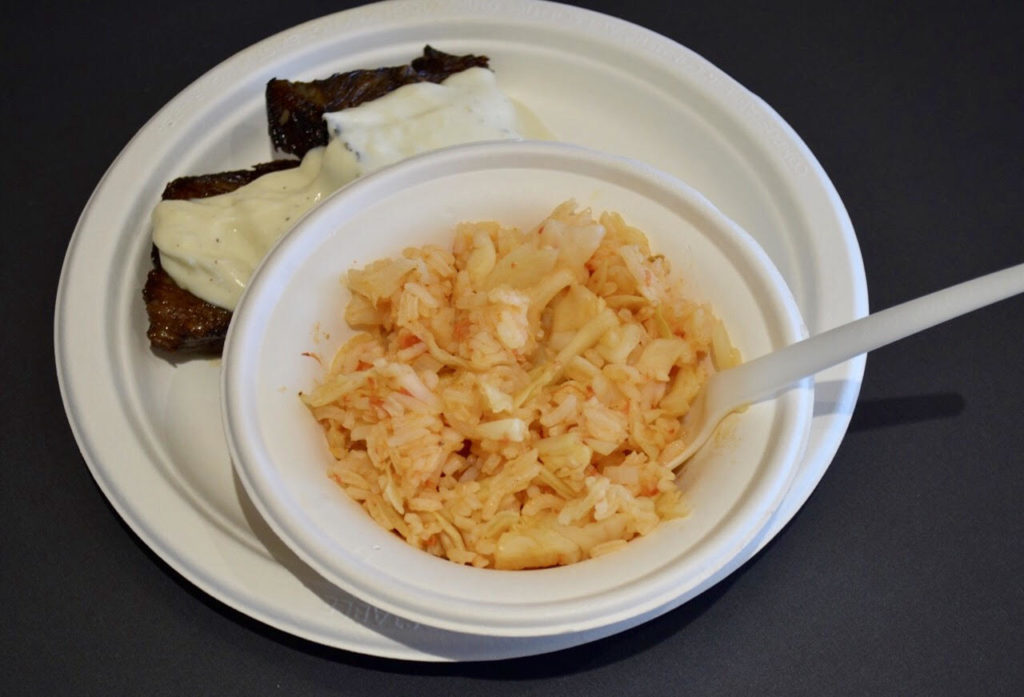
Start by bringing the water to a boil in a saucepan. Add the rice and butter then stir, cover, and lower to a simmer. Allow the rice to cook for 15 minutes or until the water is absorbed. Remove the rice from the heat but leave covered.
In a large pot, heat the olive oil over medium high. Add the onion and garlic and cook until fragrant, about 3 minutes. Add the cabbage, vinegar, and spices and cook, stirring occasionally, for about 10 minutes.
Once the cabbage is cooked down, mix in the tomatoes and cooked rice. Combine well and serve. I served mine with braised short ribs and gravy.
LAST CALL FOR THE CSA NEW YEAR PROMO!
01/26/18 — Heydon Hatcher
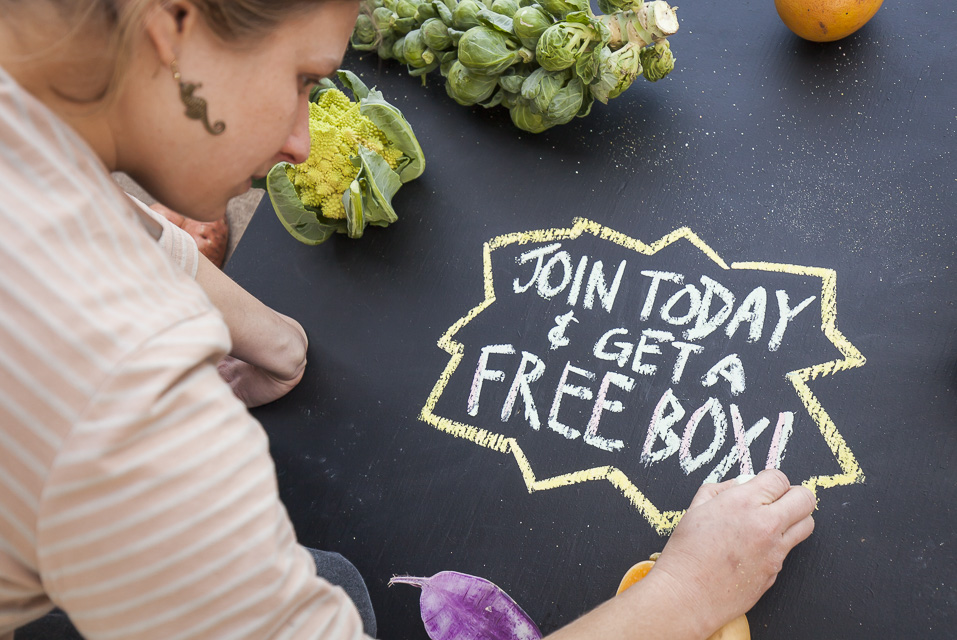 Photo by Scott David Gordon.
Photo by Scott David Gordon.
All you have been hearing from us this New Years is this persistent message: "Join the CSA! Join the CSA!" And well, we still stand by that (PS - You have less than a week left to seize the wonderful opportunity to get your first box free upon joining this month), but we wanted to take a minute to illustrate some of the magic around our CSA community. The best part of joining the CSA is, undoubtedly, the delicious food that you can make with our local and organic veggies. Food can be a tool to nourish our bodies, but also to create and strengthen community. It brings family and friends together time and time again, and we think that our CSA members do that the best - bring people together. We wanted to portray what a CSA really looks like for our members through the incredible culinary creations they make and share on social media every day. Take a gander below. **Disclaimer: it might make you hungry**

The collage above shows quick sandwiches and easy tacos to elaborate dumplings, stunning bento boxes and warming soups, all done with the vegetables from our CSA boxes! Whether you have an entire night to leisurely cook, or a quick fifteen minutes to throw something together before running out the door, there are recipes aplenty for your specific lifestyle. Joining the CSA is obviously a wonderful opportunity to brighten your plates and ameliorate your overall health, but on top of that, our CSA members love sharing brilliant and delectable recipes online, just check out our instagram, our tagged photos, or peruse our hashtag - #jbgorganic for some new ideas. Just when you think you've tried everything with those ubiquitous beets? Think again, our CSA community is a gaggle of innovative folks. Click here to sign up now, and don't forget to use the code: getcookin2.
Here is what the CSA means to some of our long-term members:
"We've been JBG members for years now and love it. It makes us feel connected to our home in a meaningful way, watching the veggies in the box change with the seasons. But what I love most now, as our family has grown, is going through our box and teaching my two-year old son the names of veggies and trying the news ones together as a family." -Joanna
"When we first moved to Austin, we joined another CSA (Johnson's wasn't around then), and for various reasons, JBG is the 3rd CSA we have been a member of. And they are the best! I remember when we first joined that I was so impressed with the condition of the veggies we received, they were so clean and fresh! We picked them in part because they provided veggies all year around, and we could choose to receive a box every week or every other week. Since then, the farm has continued to make improvements for members and provide different options." -Christina
"Mostly, though, we eat those vegetables in ways that I've always loved and in new ways: migas with collards, veggie tortilla soup, frittatas, greens soup, roasted root veggies, butternut soup, zucchini soup, baked crispy okra with onions, and eggplant every way. I don't know which I love more, that I'm eating healthy, organic food; that I'm buying local and I know the names of the farmers who grow my food; or that I'm providing an insurance policy for Johnson's Backyard Garden with my CSA. Maybe it's just that my CSA is another way I can try to help save our planet." -Alana
"In the passed 5 years I've gone from a busy professional to a busy stay-at-home Mom of two. During that time one thing that has remained constant has been our yearly subscription to JBG. It's like putting "healthy eating" on autopilot. I know when I open the fridge I always have organic, locally grown, FRESH vegetables to feed my family ...and I am so incredibly grateful!" - Stephanie
"JBG has added some very helpful features over the years. The swap/add features lets you trade out a couple of choices for preferred items and the add option gives easy access to organic eggs and citrus as needed. You can postpone a delivery if you’re busy or traveling. You can order as few as 4 weeks of delivery." -Genoka
 Gals and their carrots. Photo by Scott David Gordon.
Gals and their carrots. Photo by Scott David Gordon.
Thanks to: @mackannecheese, @banananads, @remythecook, @mattft33, @tmgrayless, @christykramer, @tacodeli, @eatthegains, @gourmettexaspasta, @bentopicnic, @sheenaspickles, @skullandcakebones, @bigals_kitchen, @_worldinapocket, @adrianapalucci, @plantbasedschool, @christielynnclarke, @localcreativeedibles, and @themigonikitchen for your incredible food photos!
WEEK 4 IN PHOTOS
01/26/18 — Heydon Hatcher
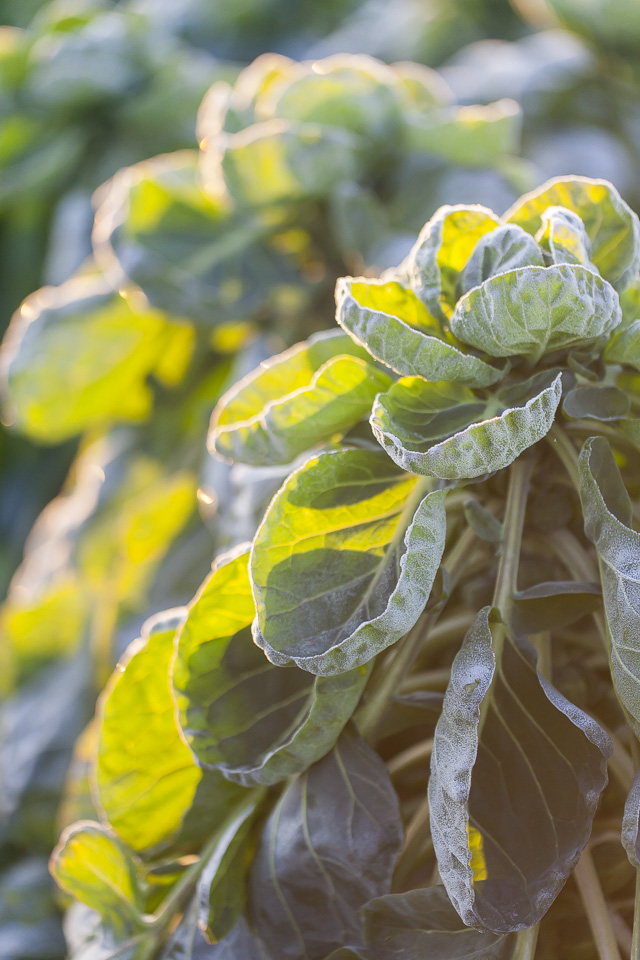 Frost on the crops. Photo by Scott David Gordon.
Frost on the crops. Photo by Scott David Gordon.
Every morning this week was either at freezing or below. The harvest crew has been focusing on harvesting root crops until everything else has been warmed up by the sun. Some of the crops have damage from the freezing temperatures, and some have fared the cold quite well. There wasn't much planting done this week, but the bed preparation continues.
We also visited the HOPE Farmers Market this past weekend, too. Check it out this Sunday at Plaza Saltillo!
 Frost on the greens. Photo by Scott David Gordon.
Frost on the greens. Photo by Scott David Gordon.
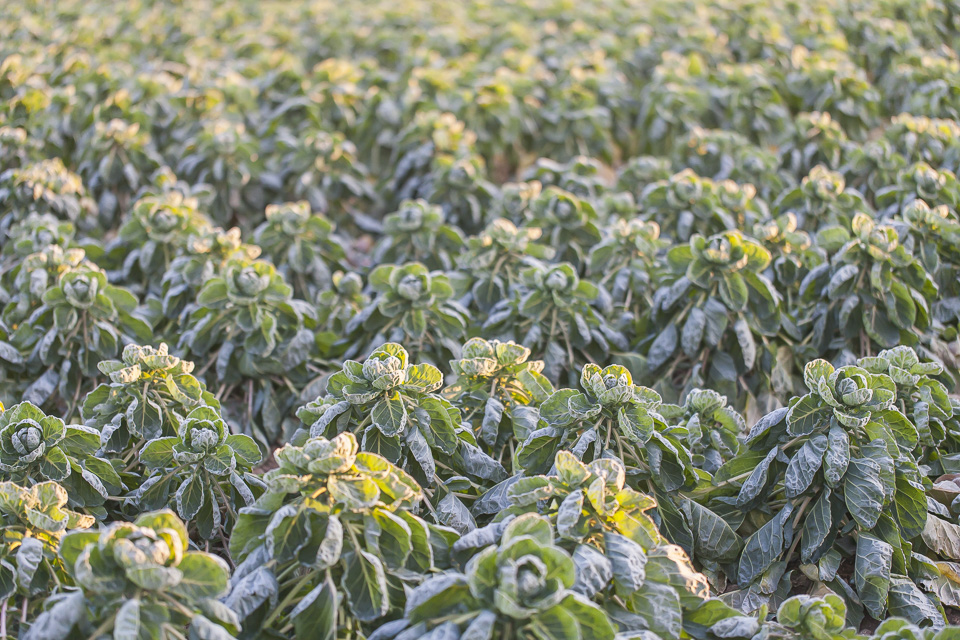 Frost on the crops. Photo by Scott David Gordon.
Frost on the crops. Photo by Scott David Gordon.
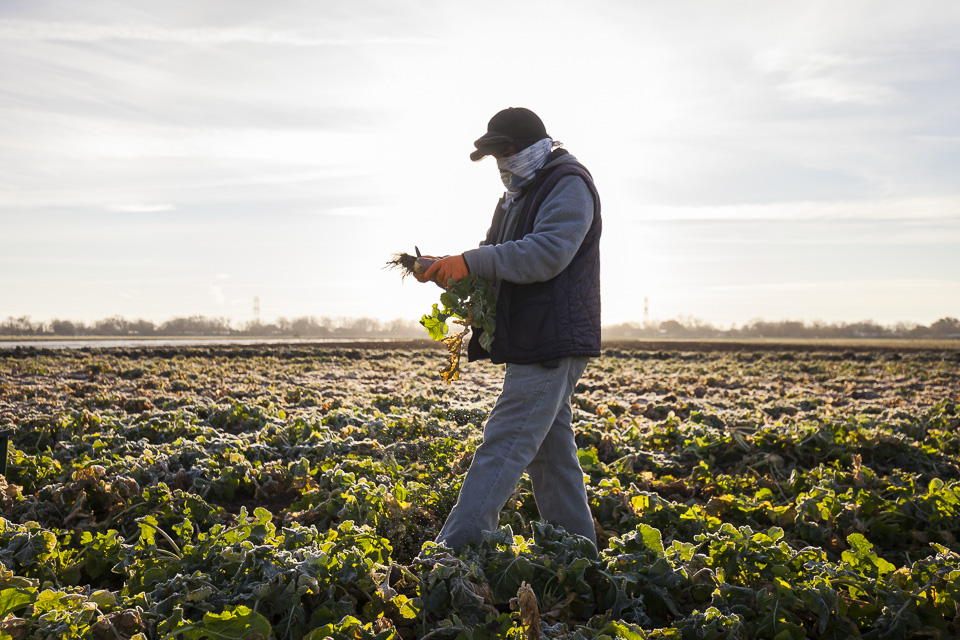 Harvesting roots. Photo by Scott David Gordon.
Harvesting roots. Photo by Scott David Gordon.
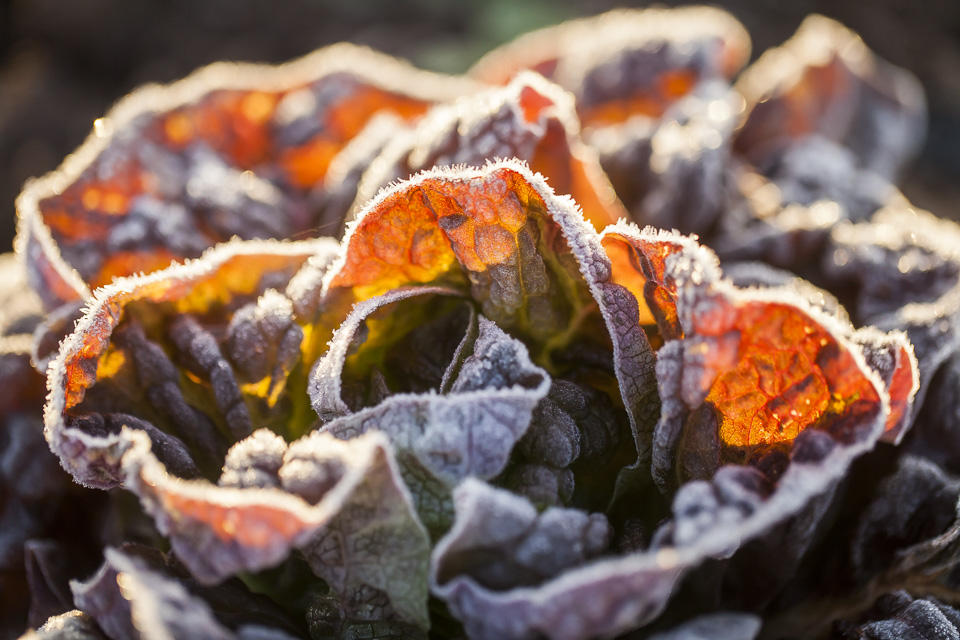 Frost on the lettuce. Photo by Scott David Gordon.
Frost on the lettuce. Photo by Scott David Gordon.
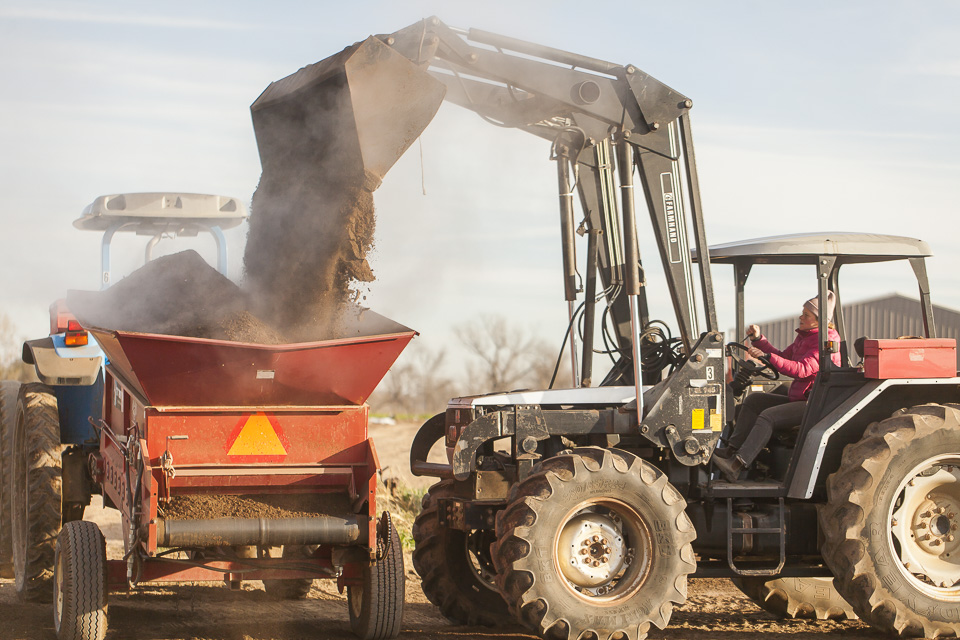 Filling up the compost spreader for bed prep. Photo by Scott David Gordon.
Filling up the compost spreader for bed prep. Photo by Scott David Gordon.
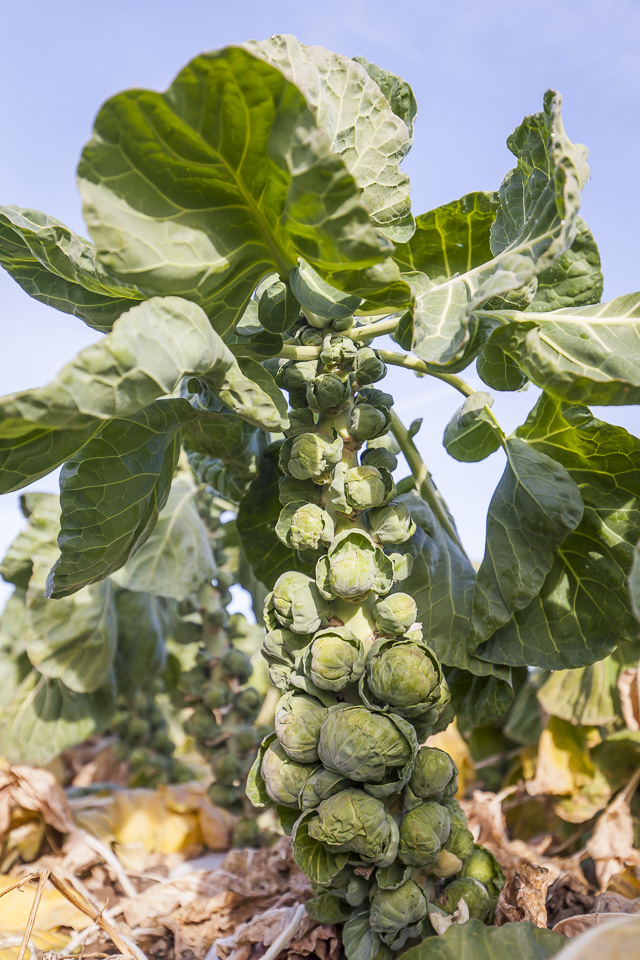 Glorious brussels. Photo by Scott David Gordon.
Glorious brussels. Photo by Scott David Gordon.
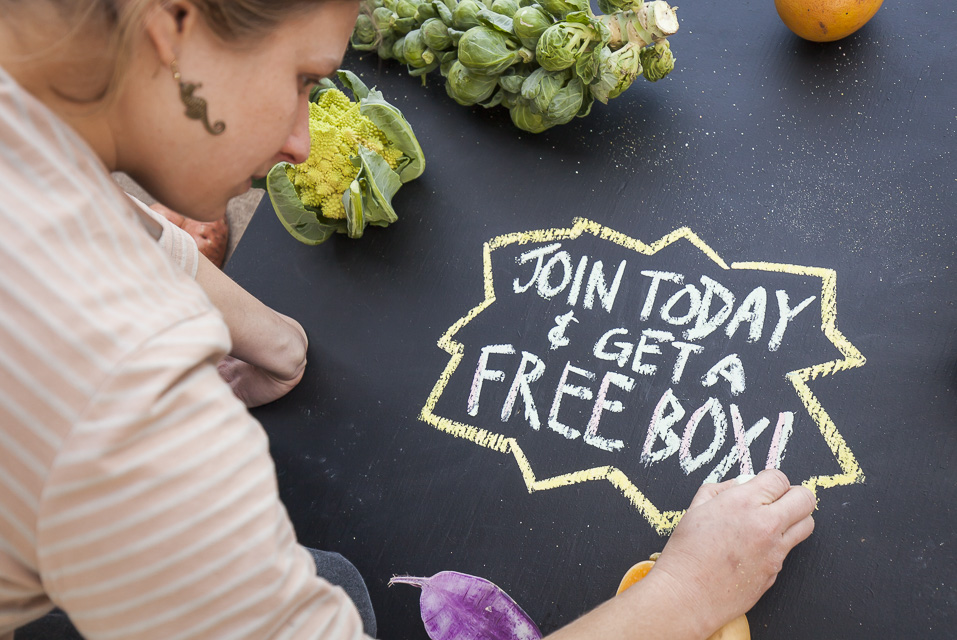 Ada, our marketing manager, getting the word out. Photo by Scott David Gordon.
Ada, our marketing manager, getting the word out. Photo by Scott David Gordon.
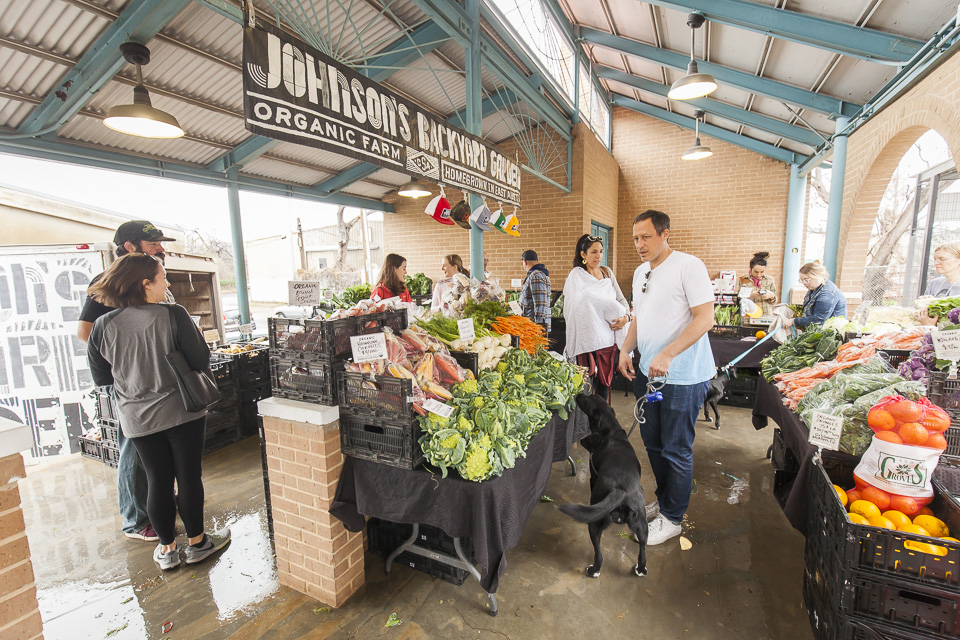 HOPE Farmers Market stand. Photo by Scott David Gordon.
HOPE Farmers Market stand. Photo by Scott David Gordon.
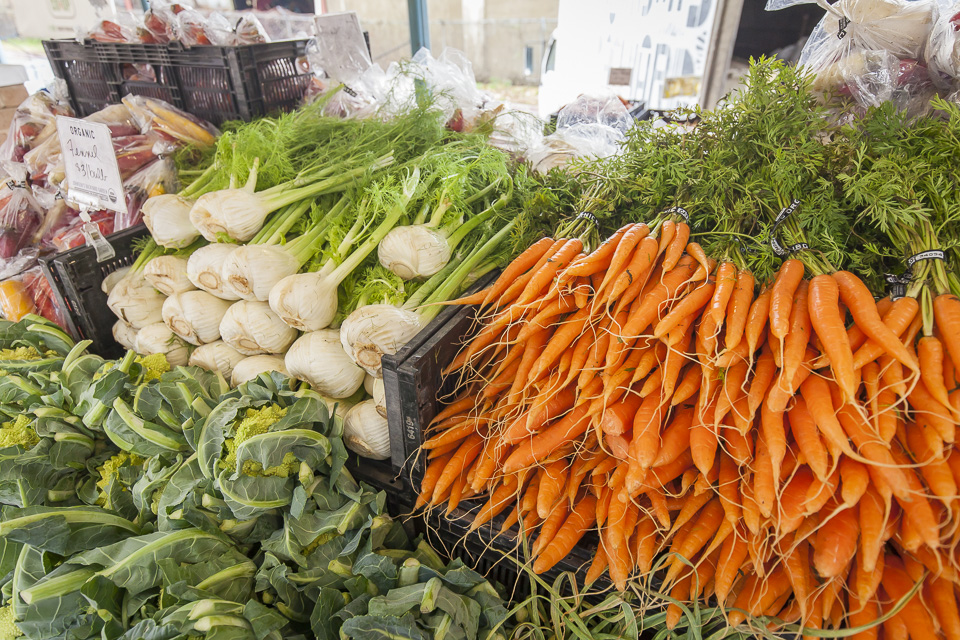 Some of the market spread. Photo by Scott David Gordon.
Some of the market spread. Photo by Scott David Gordon.
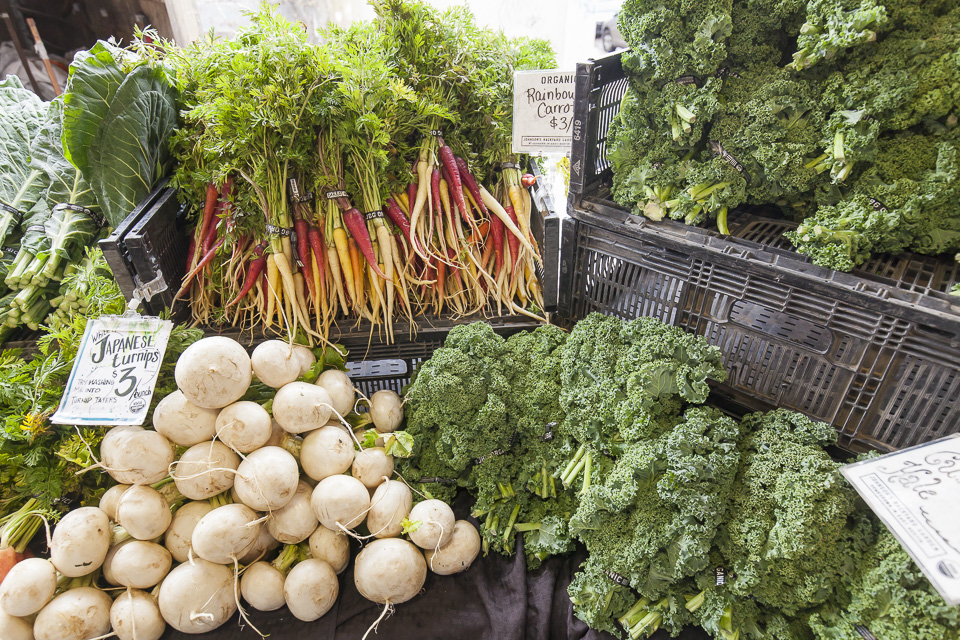 Some of the market spread. Photo by Scott David Gordon.
Some of the market spread. Photo by Scott David Gordon.
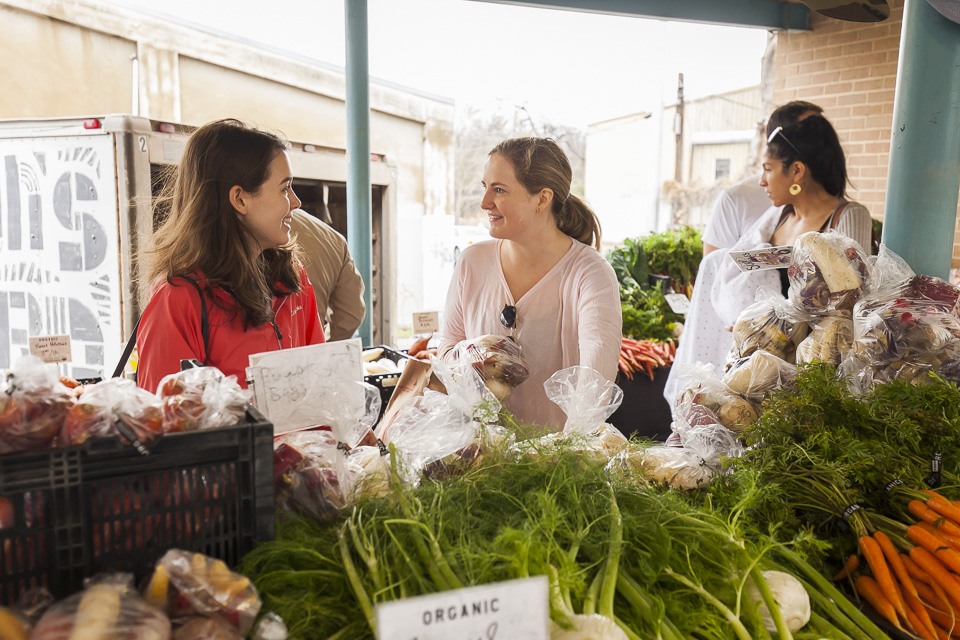 Interactions at the farmers market stand. Photo by Scott David Gordon.
Interactions at the farmers market stand. Photo by Scott David Gordon.
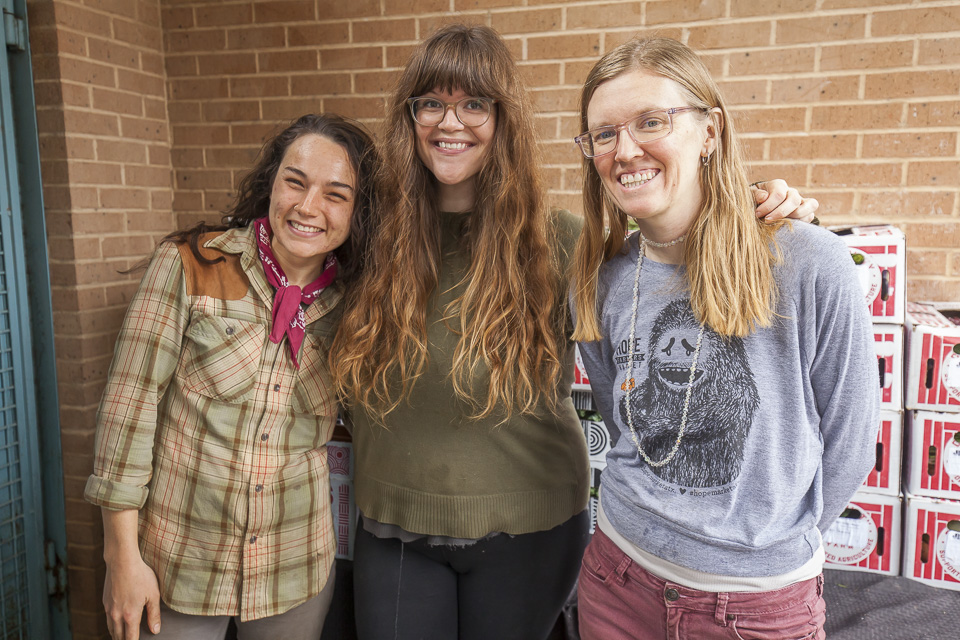 The hard-working HOPE farmers market staff. Photo by Scott David Gordon.
The hard-working HOPE farmers market staff. Photo by Scott David Gordon.
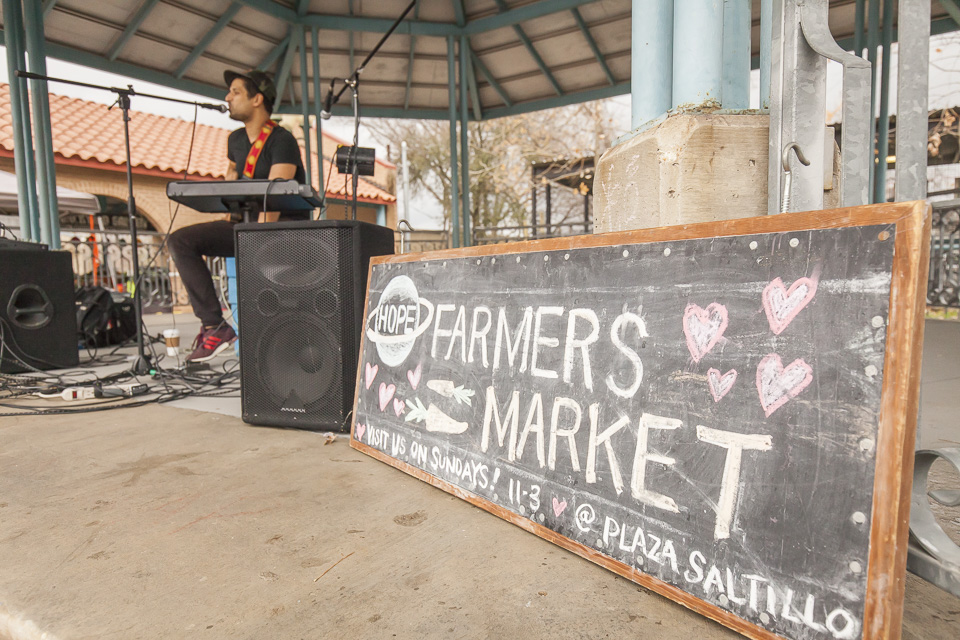 Tunes at HOPE. Photo by Scott David Gordon.
Tunes at HOPE. Photo by Scott David Gordon.TURNIP AND SPINACH GRATIN WITH ANCHOVY ROSEMARY BUTTER BREADCRUMBS
01/31/18 — Heydon Hatcher
Recipe and Photos by Nadia Tamby
You can make this dish with any other root vegetable or green as well. Our basket this week came with rutabagas, beets, and kohlrabi – all of them (or a mélange of any combination) would be great in this dish. Cooking the turnips in this way with cream mellows out the sharpness of the vegetable and the anchovy breadcrumbs are just salty and crunchy enough to give the dish some contrast. Don’t be afraid of the anchovies – you can’t see them once they melt into the butter and aren’t fishy at all in this dish – the umami flavor they contribute is perfect. Originally, we made the breadcrumbs to top roasted broccoli, so make extra and top leftover veggies or pasta dishes with the breadcrumbs for a little extra flavor and crunch. They should keep in the fridge for about a week. This dish is filling enough to serve with a salad, but is also a delicious side dish to roasted chicken/fish or a unique alternative to scalloped potatoes. I also love a dish like this because you can assemble it ahead of time and on a busy weeknight, all you need to do is turn the oven on to have a comforting gratin ready in less than an hour!
![]()
Ingredients:
Gratin:
Breadcrumbs:
Instructions:
Preheat the oven to 400F.
Melt butter in a sauté pan, then add the anchovies and mash with a spoon into the butter until they have “dissolved.” Add the grated garlic and the bread and toss until breadcrumbs are golden brown. Transfer to a bowl and mix in the chopped rosemary and set aside.
In the same pan, add the chopped garlic cloves and sauté until they are softened (add a drizzle of olive oil a bit more butter if needed), then add the spinach and toss until wilted. Remove from the heat.
Coat a gratin dish or glass baking dish with the softened butter. If you have extra just leave it in the dish as it will melt into it. Layer the sliced turnips or other root vegetables on the bottom, slightly overlapping them, then drizzle some cream and sprinkle salt and pepper on top. Spoon some of the spinach mixture on top and spread as evenly as you can (perfection isn’t necessary for this dish!). Repeat these steps until you have used all the turnips and spinach.
![]()
Cover the dish with foil and bake for about 35 minutes (at 400F). Do not add the breadcrumbs yet or else they will burn! I cover the dish with foil so that everything steams and cooks evenly. Remove the foil and look at the dish – if it seems like there is excessive liquid, bake it for another 5-10 minutes uncovered. Once the gratin is creamy without being too moist, add the breadcrumbs and increase the temperature to 425F. Bake for another 10 minutes until the breadcrumbs are deep golden brown. Remove from the oven and let the gratin rest for 10 minutes before cutting into it (you’ll have cleaner cuts when serving and if there was any excess liquid, the vegetables will have time to absorb it). Top with thinly sliced scallions or chopped parsley.
You can make this dish with any other root vegetable or green as well. Our basket this week came with rutabagas, beets, and kohlrabi – all of them (or a mélange of any combination) would be great in this dish. Cooking the turnips in this way with cream mellows out the sharpness of the vegetable and the anchovy breadcrumbs are just salty and crunchy enough to give the dish some contrast. Don’t be afraid of the anchovies – you can’t see them once they melt into the butter and aren’t fishy at all in this dish – the umami flavor they contribute is perfect. Originally, we made the breadcrumbs to top roasted broccoli, so make extra and top leftover veggies or pasta dishes with the breadcrumbs for a little extra flavor and crunch. They should keep in the fridge for about a week. This dish is filling enough to serve with a salad, but is also a delicious side dish to roasted chicken/fish or a unique alternative to scalloped potatoes. I also love a dish like this because you can assemble it ahead of time and on a busy weeknight, all you need to do is turn the oven on to have a comforting gratin ready in less than an hour!

Ingredients:
Gratin:
- 1 tablespoon softened butter (to coat bottom and sides of gratin dish)
- 2 lbs thinly sliced turnips or other root vegetables (peeled, if needed)
- 3 garlic cloves, chopped
- 1-2 bunches spinach greens, washed, trimmed and roughly chopped
- 1/2 cup heavy cream
- Salt and pepper, to taste
Breadcrumbs:
- 4 tablespoons butter
- 4-6 anchovies from a tin (make sure you’re not buying sardines!)
- 2 garlic cloves, grated
- 1 cup torn bread (crusts removed – pulse in food processor if needed)
- 1 tablespoon fresh rosemary, finely chopped
- 2 spring onions, thinly sliced (for garnish)
Instructions:
Preheat the oven to 400F.
Melt butter in a sauté pan, then add the anchovies and mash with a spoon into the butter until they have “dissolved.” Add the grated garlic and the bread and toss until breadcrumbs are golden brown. Transfer to a bowl and mix in the chopped rosemary and set aside.
In the same pan, add the chopped garlic cloves and sauté until they are softened (add a drizzle of olive oil a bit more butter if needed), then add the spinach and toss until wilted. Remove from the heat.
Coat a gratin dish or glass baking dish with the softened butter. If you have extra just leave it in the dish as it will melt into it. Layer the sliced turnips or other root vegetables on the bottom, slightly overlapping them, then drizzle some cream and sprinkle salt and pepper on top. Spoon some of the spinach mixture on top and spread as evenly as you can (perfection isn’t necessary for this dish!). Repeat these steps until you have used all the turnips and spinach.

Cover the dish with foil and bake for about 35 minutes (at 400F). Do not add the breadcrumbs yet or else they will burn! I cover the dish with foil so that everything steams and cooks evenly. Remove the foil and look at the dish – if it seems like there is excessive liquid, bake it for another 5-10 minutes uncovered. Once the gratin is creamy without being too moist, add the breadcrumbs and increase the temperature to 425F. Bake for another 10 minutes until the breadcrumbs are deep golden brown. Remove from the oven and let the gratin rest for 10 minutes before cutting into it (you’ll have cleaner cuts when serving and if there was any excess liquid, the vegetables will have time to absorb it). Top with thinly sliced scallions or chopped parsley.
CSA BOX CONTENTS WEEK OF JAN 29TH
01/31/18 — Scott
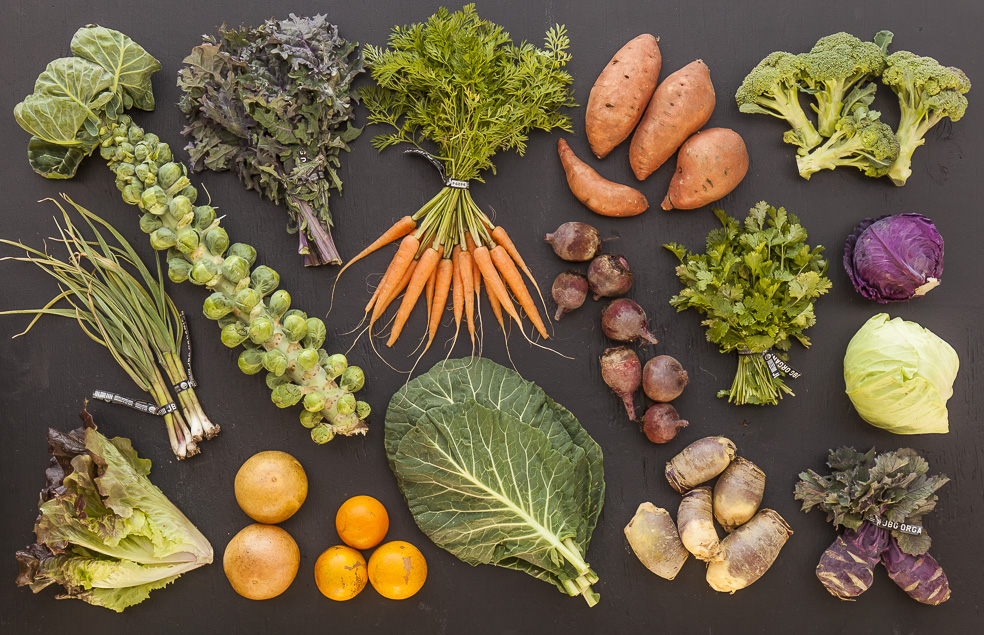 CSA Box Contents Week of Jan 29th
CSA Box Contents Week of Jan 29th
Large Box
Beet, Chioggia
Bok Choy
Brussels Sprouts
Cabbage
Carrot, Rainbow
Citrus, Mixed
Greens, Collards
Greens, Kale, Curly
Greens, Spinach
Herb, Cilantro
Lettuce, Romaine
Onion, Spring Red
Potato, Sweet
Beet, Chioggia
Bok Choy
Brussels Sprouts
Cabbage
Carrot, Rainbow
Citrus, Mixed
Greens, Collards
Greens, Kale, Curly
Greens, Spinach
Herb, Cilantro
Lettuce, Romaine
Onion, Spring Red
Potato, Sweet
Medium Box
Beet, Chioggia
Brussels Sprouts
Carrot, Rainbow
Greens, Collards
Greens, Kale, Curly
Lettuce, Romaine
Onion, Spring Red
Potato, Sweet
Radish, Watermelon
Beet, Chioggia
Brussels Sprouts
Carrot, Rainbow
Greens, Collards
Greens, Kale, Curly
Lettuce, Romaine
Onion, Spring Red
Potato, Sweet
Radish, Watermelon
Small Box
Beet, Red
Carrot, Orange
Greens, Collards
Greens, Spinach
Onion, Spring Red
Potato, Sweet
Turnip, Rutabaga
Beet, Red
Carrot, Orange
Greens, Collards
Greens, Spinach
Onion, Spring Red
Potato, Sweet
Turnip, Rutabaga
Individual Box
Carrot, Orange
Greens, Collards
Greens, Spinach
Potato, Sweet
Turnip, Rutabaga
Carrot, Orange
Greens, Collards
Greens, Spinach
Potato, Sweet
Turnip, Rutabaga
CSA BOX CONTENTS WEEK OF JAN 29TH
01/31/18 — Scott
 CSA Box Contents Week of Jan 29th
CSA Box Contents Week of Jan 29th
Large Box
Beet, Red
Broccoli
Brussels Sprouts
Carrot, Orange
Citrus, Grapefruit
Citrus, Mixed
Garlic, Green
Greens, Collards
Greens, Kale, Red
Herb, Cilantro
Kohlrabi, Purple
Lettuce, Romaine
Potato, Sweet
Turnip, Rutabaga






 0 ITEMS IN CART
0 ITEMS IN CART 


